Raven 0630172368 RGL 600 Smartbar Transmitter User Manual 936a 1 pmd
Raven Industries RGL 600 Smartbar Transmitter 936a 1 pmd
Raven >
Users Manual
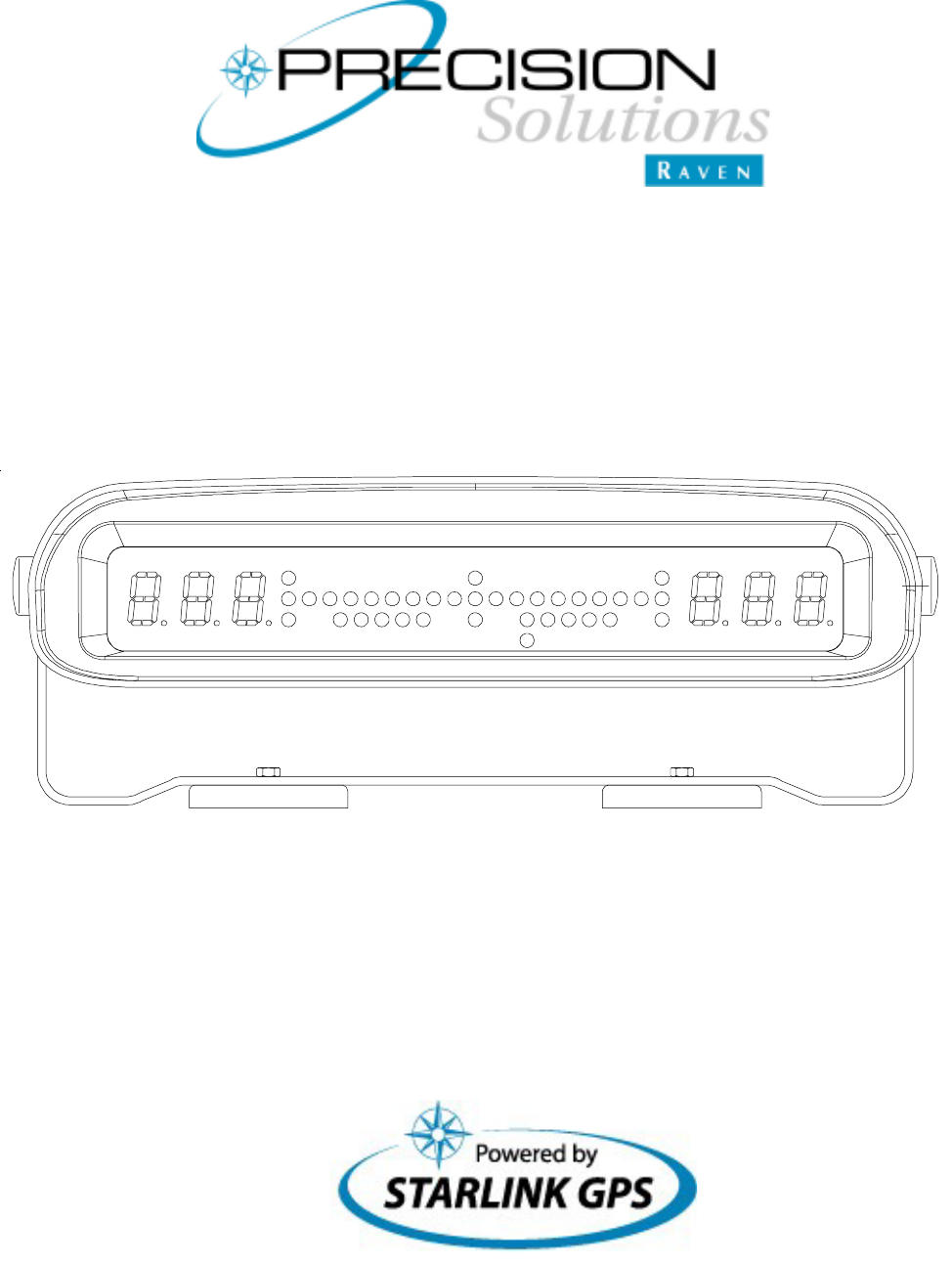
RGL 600
SMARTBAR
SWATH PATH GUIDANCE SYSTEM
OPERATION MANUAL
Use with firmware version ____
MANUFACTURER’S DECLARATION OF CONFORMITY
We declare under our sole responsibility that Raven Industries, to which this declaration relates,
is in conformity with the following standards or other normative documents:
Federal Communications Commission (FCC) Compliance Notice: Radio Frequency
Notice:
DECLARATION OF CONFORMITY
We, Raven Industries, declare our sole responsibility that the RGL 600 Smartbar complies with
Part 15 of FCC Rules.
Operation is subject to the following two conditions:
(1) this device may not cause harmful interference, and
(2) this device must accept any interference received, including interference that may cause
undesired operation.
The Devices
· Device relating to this Compliance Notice, RGL 600 Smartbar, comply with Part 15 of the
FCC Rules. Operation is subject to the following two conditions: (1) This device may not
cause harmful interference, and (2) this device must accept any interference received,
including interference that may cause undesired operation.
NOTE: This equipment has been tested and found to comply with the limits for a Class B digital
device, pursuant to Part 15 of the FCC Rules. These limits are designed to provide reasonable
protection against harmful interference in a residential installation. This equipment generates,
uses, and can radiate radio frequency energy and, if not installed and used in accordance with
the instructions, may cause harmful interference to radio communications. However, there is no
guarantee that interference will not occur in a particular installation. If this equipment does cause
harmful interference to radio or television reception, which can be determined by turning the
equipment off and on, the user is encouraged to try and correct the interference by on or more of
the following measures:
- Reorient or locate the receiving antenna.
- Increase the separation between the equipment and receiver
- Connect the equipment into an outlet on a circuit different from that to which the
receiver is connected
- Consult the dealer or an experienced radio/TV technician for help
Any modification to the unit, unless expressly approved by Raven Industries could void the user’s
authority to operate the equipment.
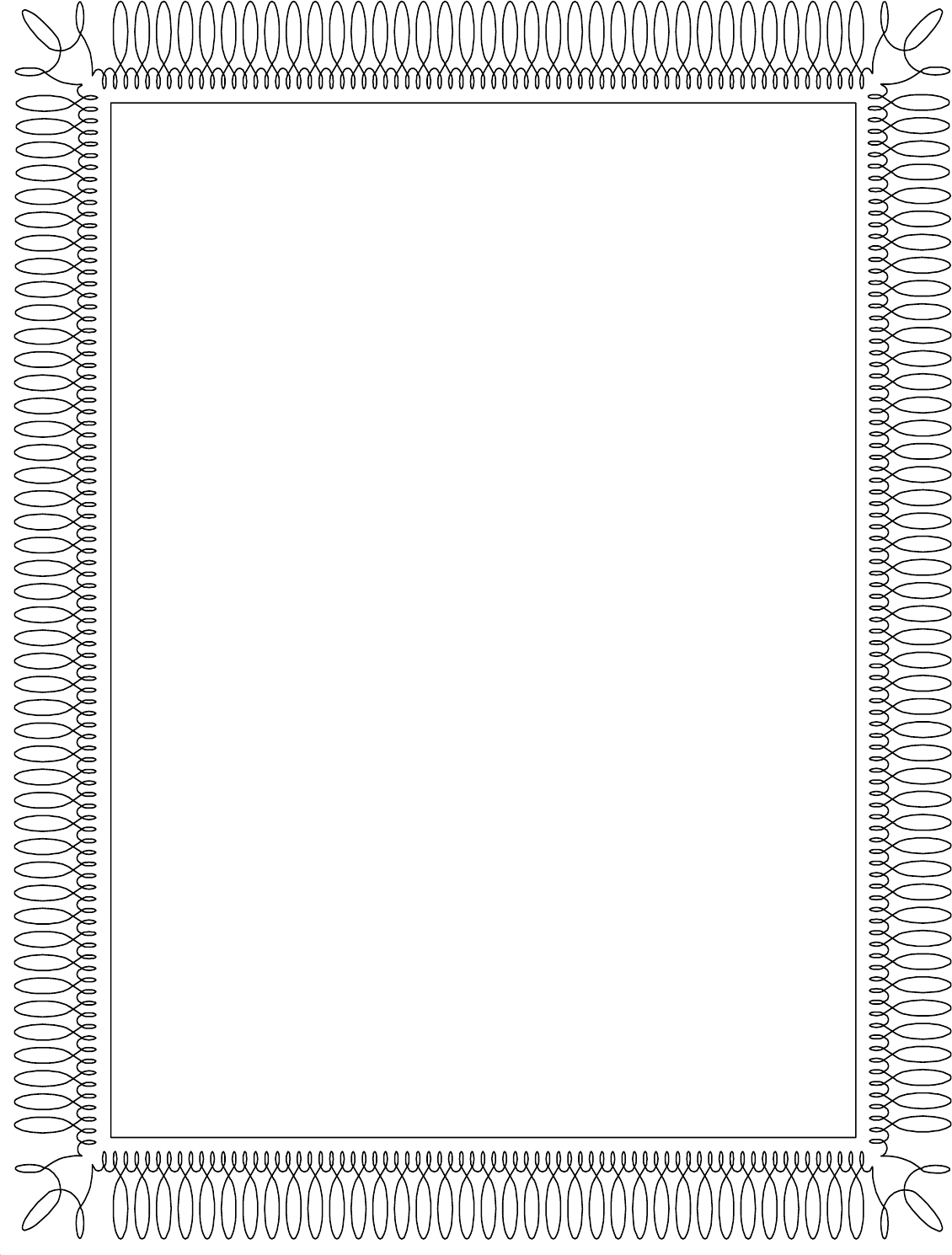
RAVEN INDUSTRIES
LIMITED WARRANTY
WHAT IS COVERED?
This warranty covers all defects in workmanship or materials in your Raven
Flow Control Product under normal use, maintenance, and service.
HOW LONG IS THE COVERAGE PERIOD?
This warranty coverage runs for 12 months from the purchase date of your
Raven Flow Control Product. This warranty coverage applies only to the
original owner and is not transferrable.
HOW CAN YOU GET SERVICE?
Bring the defective part, and proof of date of purchase, to your local dealer.
If your dealer agrees with the warranty claim, he will send the part, and
proof of purchase to his distributor or to Raven for final approval.
WHAT WILL RAVEN INDUSTRIES DO?
When our inspection proves the warranty claim, we will, at our option, repair
or replace the defective part and pay for return freight.
WHAT DOES THIS WARRANTY NOT COVER?
Raven Industries will not assume any expense or liability for repairs made
outside our plant without written consent. We are not responsible for damage
to any associated equipment or product and will not be liable for loss of
profit or other special damages. The obligation of this warranty is in lieu of
all other warranties, expressed or implied, and no person is authorized to
assume for us any liability. Damages caused by normal wear and tear, mis-
use, abuse, neglect, accident, or improper installation and maintenance are
not covered by this warranty.

RAVEN INDUSTRIES FLOW CONTROL DIVISION
205 East Sixth Street - P.O. Box 5107 - Sioux Falls, South Dakota 57117-5107
E-mail: fcdinfo@ravenind.com
www.ravenprecision.com
Toll-free: 800-243-5435 - Fax: 605-331-0426
RGL 600 Smartbar Operation Manual #016-0159-936 Rev a 10/03

1
TABLE OF CONTENTS
016-0159-936
10/03
INTRODUCTION . . . . . . . . . . . . . . . . . . . . . . . . . . . . . . . . . . . . . . . . . . . . . . . . . . . . . . . . . . . . . 3
SMARTBAR DISPLAY . . . . . . . . . . . . . . . . . . . . . . . . . . . . . . . . . . . . . . . . . . . . . . . . . . . . . . . . . 4
SMARTBAR BUTTON BOX . . . . . . . . . . . . . . . . . . . . . . . . . . . . . . . . . . . . . . . . . . . . . . . . . . . . . 5
GENERAL DIRECTION TO TARGET INDICATOR . . . . . . . . . . . . . . . . . . . . . . . . . . . . . . . . . . . 6
DGPS RECEIVER SETUP . . . . . . . . . . . . . . . . . . . . . . . . . . . . . . . . . . . . . . . . . . . . . . . . . . . . . . 6
NOTATIONS USED FOR DISPLAY FIGURES AND MENU NAVIGATION DIAGRAMS . . . . . . . 7
SMARTBAR OPERATIONAL MODE MENU NAVIGATION . . . . . . . . . . . . . . . . . . . . . . . . . . . . . 8
Basic Swathing Menu Navigation Diagrams . . . . . . . . . . . . . . . . . . . . . . . . . . . . . . . . . . . 9
Combined Headlands Menu Navigation Diagram . . . . . . . . . . . . . . . . . . . . . . . . . . . . . . . 11
Separate Headlands With Tape Measure Menu Navigation Diagram . . . . . . . . . . . . . . . . 12
ENTERING AND LEAVING THE CONFIGURATION MODE . . . . . . . . . . . . . . . . . . . . . . . . . . . . 13
THE SMARTBAR CONFIGURATION MODE . . . . . . . . . . . . . . . . . . . . . . . . . . . . . . . . . . . . . . . . 14
GPS - GPS Receiver Status Monitoring . . . . .. . . . . . . . . . . . . . . . . . . . . . . . . . . . . . . . . . 16
SWA - Swath Configuration Parameters . . . . . . . . . . . . . . . . . . . . . . . . . . . . . . . . . . . . . . 18
SWT Swath Type . . . . . . . . . . . . . . . . . . . . . . . . . . . . . . . . . . . . . . . . . . . . . . . . 18
PMR Pivot Minimum Radius . . . . . . . . . . . . . . . . . . . . . . . . . . . . . . . . . . . . . . . . 18
CON Contour Type . . . . . . . . . . . . . . . . . . . . . . . . . . . . . . . . . . . . . . . . . . . . . . . 18
SWW Swath Width . . . . . . . . . . . . . . . . . . . . . . . . . . . . . . . . . . . . . . . . . . . . . . . . 19
DIR Swath Direction . . . . . . . . . . . . . . . . . . . . . . . . . . . . . . . . . . . . . . . . . . . . . 19
SCL Guidance Offset Scale Sensitivity . . . . . . . . . . . . . . . . . . . . . . . . . . . . . . . 20
ANG Angle Indicators . . . . . . . . . . . . . . . . . . . . . . . . . . . . . . . . . . . . . . . . . . . . . 20
HDL Headlands Mode . . . . . . . . . . . . . . . . . . . . . . . . . . . . . . . . . . . . . . . . . . . . 21
ATO Along Track Offset Distance . . . . . . . . . . . . . . . . . . . . . . . . . . . . . . . . . . . 21
XTO Cross Track Offset Distance . . . . . . . . . . . . . . . . . . . . . . . . . . . . . . . . . . . 21
SYS - System Configuration (includes BAUD rate) . . . . . . . . . . . . . . . . . . . . . . . . . . . . . . 22
BPS BAUD Rate Setting . . . . . . . . . . . . . . . . . . . . . . . . . . . . . . . . . . . . . . . . . . 22
UTS Feet, Feet Fine, or Metric Units . . . . . . . . . . . . . . . . . . . . . . . . . . . . . . . . . 22
MSG Outgoing Transmit Message Control . . . . . . . . . . . . . . . . . . . . . . . . . . . . . 22
TAP Tape Measurement Control . . . . . . . . . . . . . . . . . . . . . . . . . . . . . . . . . . . . 22
DSP Display Settings . . . . . . . . . . . . . . . . . . . . . . . . . . . . . . . . . . . . . . . . . . . . . 22
GPS GPS Settings . . . . . . . . . . . . . . . . . . . . . . . . . . . . . . . . . . . . . . . . . . . . . . . 23
DSP - Display Settings . . . . . . . . . . . . . . . . . . . . . . . . . . . . . . . . . . . . . . . . . . . . . . . . . . . 23
GPS Optional DGPS Status Configuration Format . . . . . . . . . . . . . . . . . . . . . . 23
GUI Guidance Display . . . . . . . . . . . . . . . . . . . . . . . . . . . . . . . . . . . . . . . . . . . 23
OFF Offset Error Display Direction . . . . . . . . . . . . . . . . . . . . . . . . . . . . . . . . . . 23
SAV Save Position Distance . . . . . . . . . . . . . . . . . . . . . . . . . . . . . . . . . . . . . . . 24
APR Headlands Approach Display . . . . . . . . . . . . . . . . . . . . . . . . . . . . . . . . . . 24
SPL Special Angle and Offset Error Display . . . . . . . . . . . . . . . . . . . . . . . . . . . 24
CON Contour Control . . . . . . . . . . . . . . . . . . . . . . . . . . . . . . . . . . . . . . . . . . . . . 25
SWW Swath Width Control . . . . . . . . . . . . . . . . . . . . . . . . . . . . . . . . . . . . . . . . . 25
LSC Limit Swath Cal . . . . . . . . . . . . . . . . . . . . . . . . . . . . . . . . . . . . . . . . . . . . . 25
IAS - Inertial Augmentation System . . . . . . . . . . . . . . . . . . . . . . . . . . . . . . . . . . . . . . . . . 25
DIA - Diagnostic Built-In Testing . . . . . . . . . . . . . . . . . . . . . . . . . . . . . . . . . . . . . . . . . . . . 25
DSP RGL 600 Built-In Display Test . . . . . . . . . . . . . . . . . . . . . . . . . . . . . . . . . . 25
CKS Program Memory Checksum . . . . . . . . . . . . . . . . . . . . . . . . . . . . . . . . . . . 26
SET..DEF - Reset Smartbar Configuration Settings to Default Values . . . . . . . . . 26
SET..NUM - Smartbar 6 digit Unit Serial Number . . . . . . . . . . . . . . . . . . . . . . . . . 26
2
BASIC SWATHING . . . . . . . . . . . . . . . . . . . . . . . . . . . . . . . . . . . . . . . . . . . . . . . . . . . . . . . . . . . . 27
BACK AND FORTH SWATHING (BF) . . . . . . . . . . . . . . . . . . . . . . . . . . . . . . . . . . . . . . . . . . . . . . 28
SNAP-TO-SWATH SWATHING (SNP) . . . . . . . . . . . . . . . . . . . . . . . . . . . . . . . . . . . . . . . . . . . . . 28
TO BEGIN YOUR FIRST SWATH . . . . . . . . . . . . . . . . . . . . . . . . . . . . . . . . . . . . . . . . . . . . . . . . . 29
CLEARING THE A-B LINE . . . . . . . . . . . . . . . . . . . . . . . . . . . . . . . . . . . . . . . . . . . . . . . . . . . . . .30
SAVING YOUR PRESENT POSITION . . . . . . . . . . . . . . . . . . . . . . . . . . . . . . . . . . . . . . . . . . . . . 31
SWATHING WITH HEADLANDS . . . . . . . . . . . . . . . . . . . . . . . . . . . . . . . . . . . . . . . . . . . . . . . . . 32
Separate Headlands . . . . . . . . . . . . . . . . . . . . . . . . . . . . . . . . . . . . . . . . . . . . . . . . . . . . . 33
Combined Headlands . . . . . . . . . . . . . . . . . . . . . . . . . . . . . . . . . . . . . . . . . . . . . . . . . . . . 34
Double Headlands C Pattern . . . . . . . . . . . . . . . . . . . . . . . . . . . . . . . . . . . . . . . . . . . . . . 35
Headland Approach Display . . . . . . . . . . . . . . . . . . . . . . . . . . . . . . . . . . . . . . . . . . . . . . . 38
PIVOT SWATHING . . . . . . . . . . . . . . . . . . . . . . . . . . . . . . . . . . . . . . . . . . . . . . . . . . . . . . . . . . . . 39
Pivot Pattern Configuration . . . . . . . . . . . . . . . . . . . . . . . . . . . . . . . . . . . . . . . . . . . . . . . . 40
Marking the Pivot Reference Circle . . . . . . . . . . . . . . . . . . . . . . . . . . . . . . . . . . . . . . . . . . 41
Driving the Pivot Return . . . . . . . . . . . . . . . . . . . . . . . . . . . . . . . . . . . . . . . . . . . . . . . . . . .42
Saving and Returning to a Position . . . . . . . . . . . . . . . . . . . . . . . . . . . . . . . . . . . . . . . . . . 42
ROW SWATHING . . . . . . . . . . . . . . . . . . . . . . . . . . . . . . . . . . . . . . . . . . . . . . . . . . . . . . . . . . . . . 43
Configuration Steps for Row Swathing . . . . . . . . . . . . . . . . . . . . . . . . . . . . . . . . . . . . . . . 43
CONTOUR SWATHING . . . . . . . . . . . . . . . . . . . . . . . . . . . . . . . . . . . . . . . . . . . . . . . . . . . . . . . .44
Contour Control Configuration Setting . . . . . . . . . . . . . . . . . . . . . . . . . . . . . . . . . . . . . . . 45
Contour Type Configuration Setting . . . . . . . . . . . . . . . . . . . . . . . . . . . . . . . . . . . . . . . . . 45
Configuration Steps for Contour Swathing . . . . . . . . . . . . . . . . . . . . . . . . . . . . . . . . . . . . 46
Using Contour Swathing . . . . . . . . . . . . . . . . . . . . . . . . . . . . . . . . . . . . . . . . . . . . . . . . . . 47
SEED SWATHING . . . . . . . . . . . . . . . . . . . . . . . . . . . . . . . . . . . . . . . . . . . . . . . . . . . . . . . . . . . . 48
RACETRACK SWATHING . . . . . . . . . . . . . . . . . . . . . . . . . . . . . . . . . . . . . . . . . . . . . . . . . . . . . . 49
SQUEEZE SWATHING . . . . . . . . . . . . . . . . . . . . . . . . . . . . . . . . . . . . . . . . . . . . . . . . . . . . . . . . . 50
ONE BUTTON SWATHING . . . . . . . . . . . . . . . . . . . . . . . . . . . . . . . . . . . . . . . . . . . . . . . . . . . . . . 51
SMARTBAR TILT UPGRADE OPTION . . . . . . . . . . . . . . . . . . . . . . . . . . . . . . . . . . . . . . . . . . . . . 52
Tilt Sensor Upgrade Option Installation . . . . . . . . . . . . . . . . . . . . . . . . . . . . . . . . . . . . . . 52
IAS Configuration . . . . . . . . . . . . . . . . . . . . . . . . . . . . . . . . . . . . . . . . . . . . . . . . . . . . . . . 53
TLT - Tilt Control Mode . . . . . . . . . . . . . . . . . . . . . . . . . . . . . . . . . . . . . . . . . . . . . 53
AHT - Antenna Height . . . . . . . . . . . . . . . . . . . . . . . . . . . . . . . . . . . . . . . . . . . . . . 54
ANG - Tilt Angle Readout and Calibration . . . . . . . . . . . . . . . . . . . . . . . . . . . . . . .54
SWATH CALIBRATION . . . . . . . . . . . . . . . . . . . . . . . . . . . . . . . . . . . . . . . . . . . . . . . . . . . . . . . .55
SPECIAL OFFSET AND ANGLE DISPLAYS . . . . . . . . . . . . . . . . . . . . . . . . . . . . . . . . . . . . . . . . 55
ALARMS . . . . . . . . . . . . . . . . . . . . . . . . . . . . . . . . . . . . . . . . . . . . . . . . . . . . . . . . . . . . . . . . . . . . 58
GPS RECEIVER/SMARTBAR COMMUNICATIONS . . . . . . . . . . . . . . . . . . . . . . . . . . . . . . . . . . 59
CARE AND CLEANING . . . . . . . . . . . . . . . . . . . . . . . . . . . . . . . . . . . . . . . . . . . . . . . . . . . . . . . .60
TROUBLESHOOTING . . . . . . . . . . . . . . . . . . . . . . . . . . . . . . . . . . . . . . . . . . . . . . . . . . . . . . . . .60
RGL 600 MAIN UNIT CONNECTORS . . . . . . . . . . . . . . . . . . . . . . . . . . . . . . . . . . . . . . . . . . . . . 61
CABLE OPTIONS . . . . . . . . . . . . . . . . . . . . . . . . . . . . . . . . . . . . . . . . . . . . . . . . . . . . . . . . . . . . . 61
CABLE WIRING DIAGRAMS . . . . . . . . . . . . . . . . . . . . . . . . . . . . . . . . . . . . . . . . . . . . . . . . . . . . 63
SMARTBAR SPECIFICATIONS . . . . . . . . . . . . . . . . . . . . . . . . . . . . . . . . . . . . . . . . . . . . . . . . . . 66
APPENDIX A - DRIVING YOUR MACHINE USING THE SMARTBAR . . . . . . . . . . . . . . . . . . . . . 67
APPENDIX B - INVICTA DGPS RECEIVER SETUP . . . . . . . . . . . . . . . . . . . . . . . . . . . . . . . . . . .68
APPENDIX C - GLOBAL POSITIONING SYSTEM (GPS) . . . . . . . . . . . . . . . . . . . . . . . . . . . . . . 69
APPENDIX D - DIFFERENTIAL GPS (DGPS) BEACON . . . . . . . . . . . . . . . . . . . . . . . . . . . . . . . 70
3
INTRODUCTION
The RGL 600 Smart Light Bar, connected to a DGPS receiver, provides guidance control and display
for swathing applications. The RGL 600 Smartbar receives position, speed over ground (SOG), and
course over ground (COG) from a DGPS receiver. The Smartbar compares this COG and position to
the desired swath pattern, and produces a guidance display. This enables an equipment operator to
accurately drive a desired swath pattern.
Offset error and angle error are displayed by a series of bright Light Emitting Diodes (LED’s) which
form bars on either side of the display center. Offset error is displayed as a numeric distance and as
the number of LED’s illuminated on the offset error bar in the direction the machine should travel to
reduce the offset error. Angle error is displayed as the number of LED’s illuminated on the angle error
bar in the direction to correct the machine’s swath alignment.
Smartbar features include:
* Remote button box provides operator control and selection of the Smartbar options.
* Bright LED’s ensure easy viewing even in direct sunlight.
* Housing designed to operate outdoors in all weather conditions.
* Data displayed on Smartbar includes:
DGPS receiver status display
Swath Guidance Indication
Ground Speed
Course Over Ground
* User-configurable options include:
English or Metric units to display speed and distance
Swath width
Swath type
The Smartbar monitors the GPS receiver mode, Accuracy (HDOP), and DGPS Age of Data. Should
a problem arise, a warning is displayed to the operator so appropriate action can be taken.
When the Smartbar is mounted forward on the machine’s hood, the operator can optimally view
guidance indications while looking ahead to drive.
The RGL 600 Smartbar transmits output messages to indicate position, swathing sequences and
conditions, operator button switch activity, and control setup and test information. These output mes-
sages provide for data logging and other types of external controls.
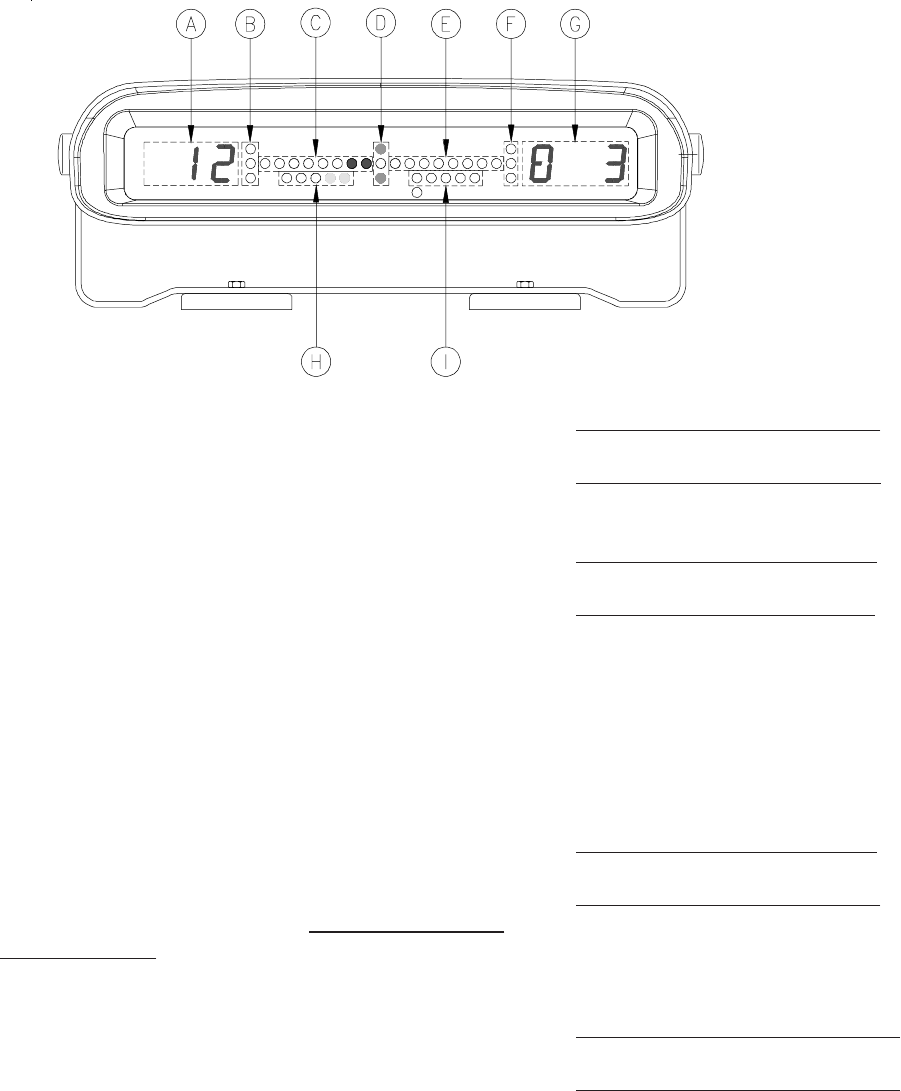
4
SMARTBAR DISPLAY
A - Left alphanumeric display showing swath number 3 bright red digits/characters
B,F - Left and right GPS Status, see table under “Alarms” 3 vertical bright amber LED’s
(All LED’s out is good, any LED on is a problem)
C - Left Offset distance error, turn left to correct 8 horizontal bright red LED’s
D - Center Guidance Status 3 vertical bright green LED’s
The center green LED is on if no offset distance error LED’s are on. The top and bottom LED’s
are both on if a swath is established and the Smartbar is showing guidance (except for Head-
lands and Saving Your Present Position). When a swath has been established, the Smartbar
shows guidance on all but a few screens, such as the BAUD rate screen. In general, when the
top and bottom LED’s are on, it is okay to spray. The top and bottom LED’s are described in
‘Saving Your Present Position’ and ‘Headlands’.
E - Right Offset distance error, turn right to correct 8 horizontal bright red LED’s
G - Right alphanumeric display showing offset distance 3 bright red digits/characters
(The left digit shown displays a General Direction to
Target Indicator. The display shown is pointing to the
target swath line, which is to the left).
H - Left Angle error, turn left to correct 5 horizontal bright amber LED’s
I - Right Angle error, turn right to correct 5 horizontal bright amber LED’s
The Smartbar shows guidance on all screens that do not use the guidance LED’s for something else.
When FT (feet) or FTF (feet fine) units are selected, swath offset distance is in feet.
When MT (metric) units are selected, offset distance is in decimeters.
IMPORTANT:
For metric units, a value of 123 is read as 123 decimeters or 12.3 meters.
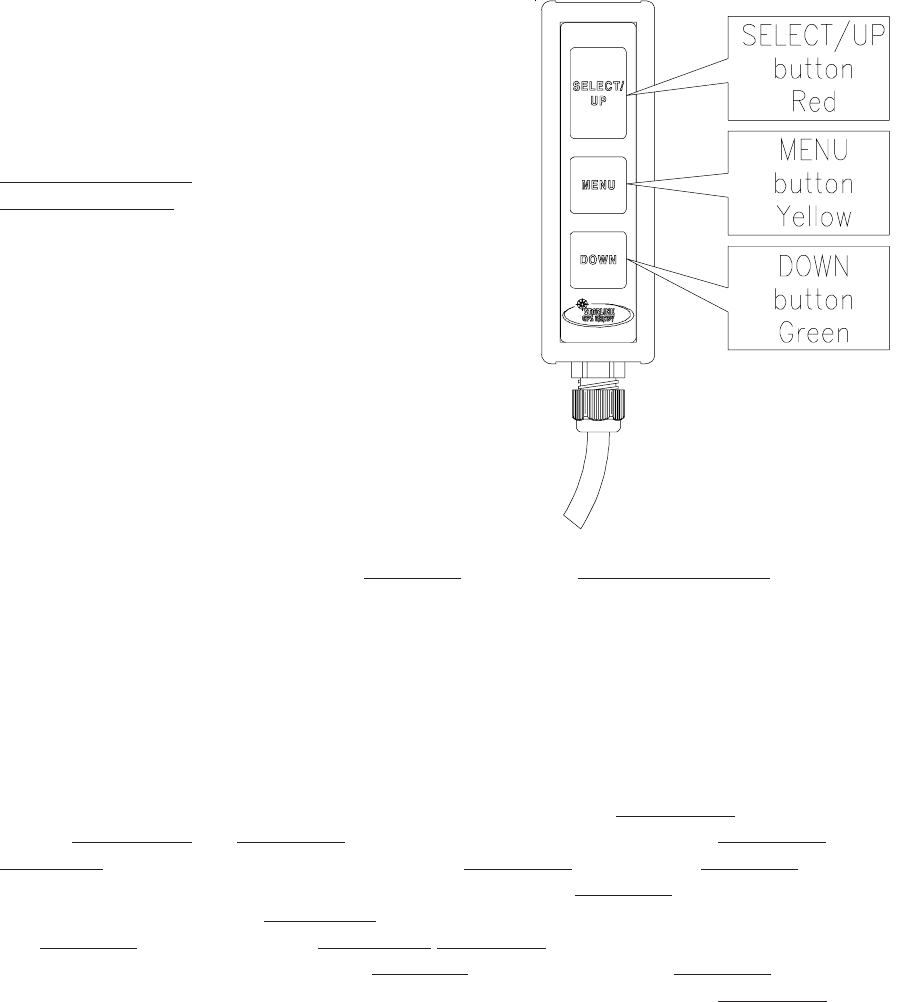
5
SMARTBAR BUTTON BOX
SELECT/UP button
The SELECT button is like an Enter or Execute
button. It changes or advances data values in the
Configuration Mode and activates actions in the
Operational Mode. This is the most used button.
It is located at the top of the Button Box for the
operator’s easy thumb access.
MENU button
The MENU button is used to select menu screens
from a list. It is also used to access an action item
from list. This button does not change data or
execute actions. Press the MENU button to
sequence through a menu list.
DOWN button
The DOWN button is used to enter a sub-menu and, in the Configuration Mode, to decrease
data values.
Sometimes actions are executed when the DOWN button is pressed. For example, the DOWN
button is used (instead of the SELECT button) to mark the last headlands point.
Navigating Menus and Sub-menus
The current menu name shows in the alphanumeric display. (see Configuration Mode Menu
Navigation Diagram) Menus that have menus ‘under’ them are main menus. Menus that are
‘under’ main menus are sub-menus. Pressing the MENU button displays main menu and
sub-menu items in sequence. When showing a main menu, (i.e. it has a sub-menu ‘under’ it),
pressing the DOWN button will display the first item in that sub-menu. Then pressing the
MENU button displays this sub-menu’s items in sequence. Pressing the MENU button at the
last sub-menu item displays this sub-menu’s main menu item again. The DOWN button may
now be pressed again to re-enter this sub-menu (in case the desired sub-menu item was
skipped inadvertently) or press the MENU button to sequence to the next main menu item.
Changing data values
Some menus are data items, such as swath width (SWW). For these menus, a data value or
setting is displayed in the right alphanumeric display. There are basically two types of data
items: numeric such as swath width and select-from-list such as headlands (OFF, SEP, CMP,
DHC). If the data item is numeric, pressing the SELECT/UP button will increase the data
value, while pressing the DOWN button will decrease the data value. Usually, the
SELECT/UP button will increase by a large value and the DOWN button will decrease by a
small value. This provides for faster setting when the desired data value is far from the current
setting. The DOWN button is then used for a precise setting.
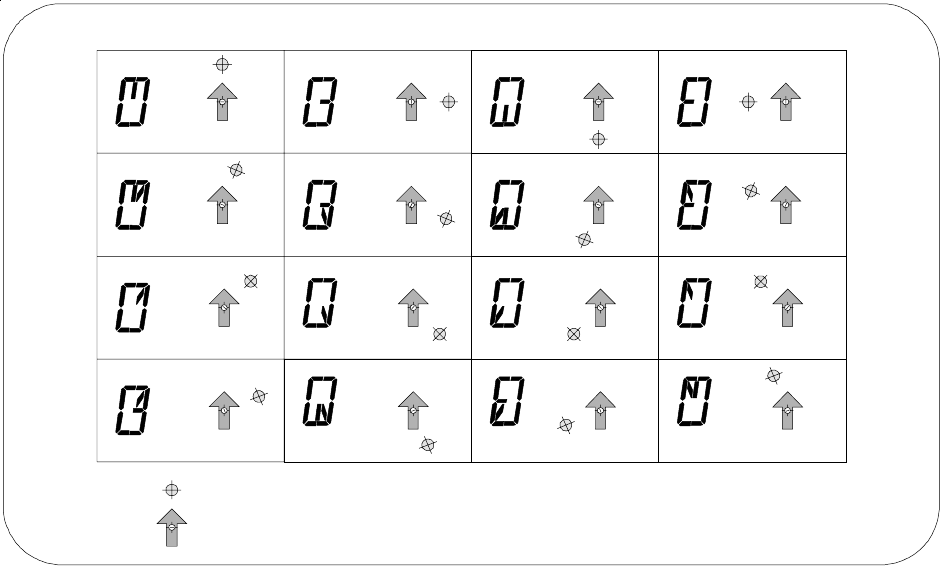
6
GENERAL DIRECTION TO TARGET INDICATOR
A General Direction to Target Indication is displayed on an alphanumeric display digit to show
the direction towards various targets. An example is the left most digit of the guidance offset
error display when the offset error is less than 100. From the perspective of the operator, this
is a general pointer to the swath line (or other target) that is in control.
DGPS RECEIVER SETUP
The Smartbar uses position and course information provided by certain messages from your
GPS receiver. Referring to the GPS receiver documentation, configure it to output $GPGGA
messages and $GPVTG messages. Alternatively, you could configure your GPS receiver to
output only $GPRMC messages.
Note that your GPS receiver documentation may drop ‘$GP’ from the message names, and
refer to them as GGA, VTG, and RMC.
Set the GPS receiver communications BAUD rate and message output rate as high as
possible. The Smartbar works with standard BAUD rates from 4800 to 38400 and message
output rates up to 10 position solutions per second (hertz). The Smartbar responds best when
the GPS receiver communications is at 38400 BAUD and the message output rate is at 10
hertz.
If the message output rate is 10 hertz, the GPS receiver BAUD rate must be at least 19200.
If the message output rate is 5 hertz, the GPS receiver BAUD rate must be at least 9600. A
BAUD rate of 4800 is only practical if the message output rate is 1 hertz.
See Appendix B for Invicta DGPS Receiver setup.
General Direction to
Target Indications
current position and COG
target
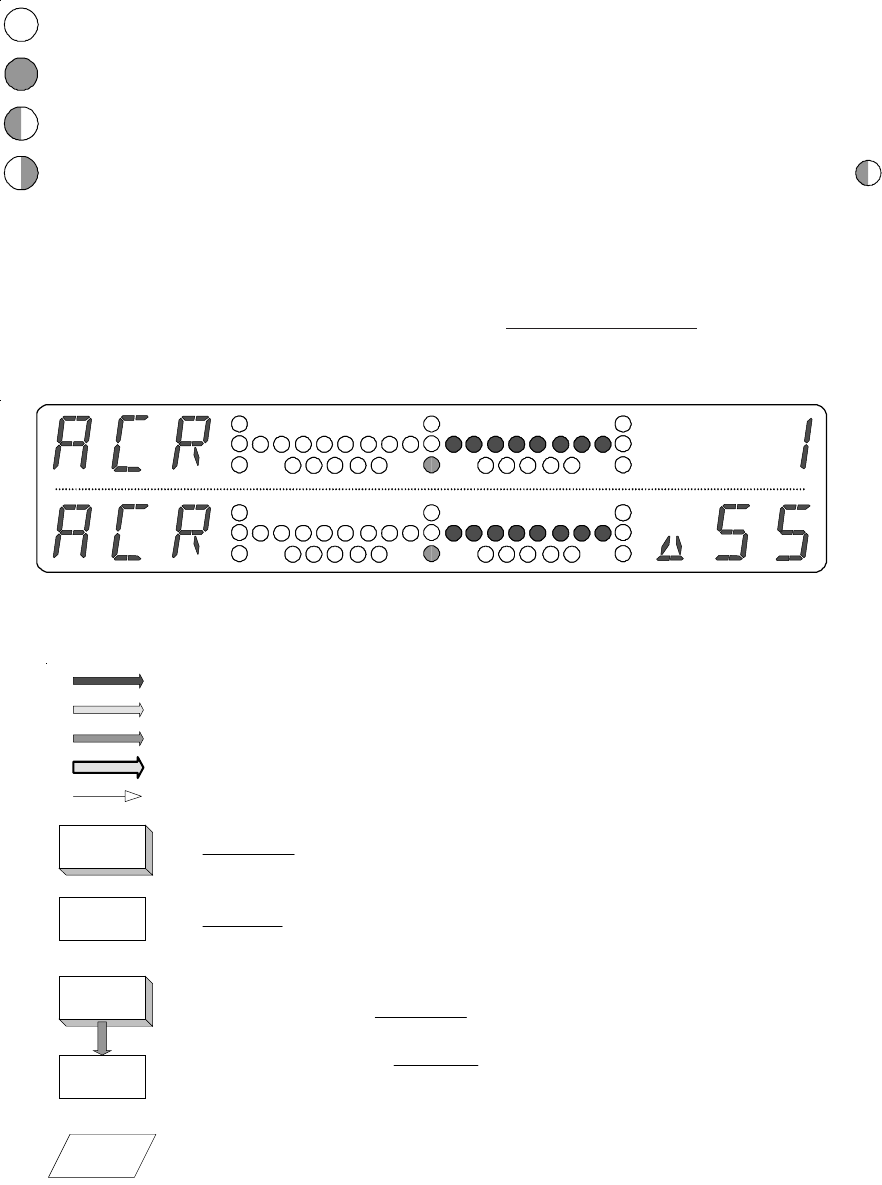
7
Notations used for display figures and menu navigation diagrams
The following notations are used to describe the Smartbar LED indicators and alphanumeric
displays:
This example shows a multiple sequence alphanumeric display. In this example, 1.55 acres
is displayed by alternating the right alphanumeric display between ‘ 1’ and ‘.55’. The Smart-
bar display alternates between [a] and [b]. In some Configuration Mode displays, up to 5
sequences are used to display large numeric values.
The following notations are used for menu navigation diagrams:
SWA
SWT
SWA
SWT
main-menu item (Left alphanumeric display shows SWA)
sub-menu item (Left alphanumeric display shows SWT)
At the Swath (SWA) main-menu,
press the DOWN button to move to
the Swath Type (SWT) sub-menu.
Execute an action.
For this example, Set the Tape Reference Point.
Set Tape
Refernce point
MENU Button pressed and released
DOWN Button pressed
SELECT Button pressed
press and hold the MENU Button for 3 seconds
Automatic (no button press)
[
a]
[
b]
- LED is OFF
- LED is ON
- LED is flashing ON/OFF
- LED is flashing OFF/ON (used to denotate alternating flash when shown with
)

8
Smartbar Operational Mode Menu Navigation
The Smartbar separates Operational functions from Configuration functions. The Smartbar operates
in either the Operational Mode or the Configuration Mode. A Smartbar operator uses the Operational
Mode when setting up and swathing a field. The Operational Mode is the primary operating mode.
therefore, the number and complexity of all menus and sequences is minimized as much as possible.
The Configuration Mode is used to setup interface and operating variables. Some of the variables set
in the Congiguration Mode help to minimize button presses in the Operational Mode. An example is
the Tape Measure feature. When the Tape Measure is turned OFF, the TAP menu item is removed
from the operational menu sequence.
The Configuration Mode is entered only from the main RGL 600 screen. Press and hold the MENU
button for approximately 3 seconds. A screen showing “TO...CFG” is displayed. Press the SELECT
button to enter the Configuration Mode. Or press the MENU button to return to the RGL 600 screen.
For more details, see the section - Entering and Leaving the Configuration Mode.
There are four different sets of Menu Navigation Diagrams in this section:
Basic Swathing w/Direction set to Auto
Back and Forth Swathing after A-B line and direction are setup
Combined Headlands
Separate Headlands with Tape Measure
There are five additional sets of Menu Navigation Diagrams other sections:
Pivot Swathing
Row Swathing
Contour Swathing
Seed Swathing
ONE Swathing
These sets are usually accompanied by a set of display figures that depict actual Light Bar displays
corresponding to the Menu Navigation Diagram.
There are numerous combinations of configurable operating features and methods for using the
Smartbar while covering a field with an applicator machine. These Menu Navigation Diagrams do not
show all combinations of operations. For instance, the Tape Measure is shown in the Separate
Headlands set, but it can also be used for Basic Swathing and Combined Headlands. Look in all
of the various sets of Menu Navigation Diagrams for solutions to your particular swathing require-
ments.
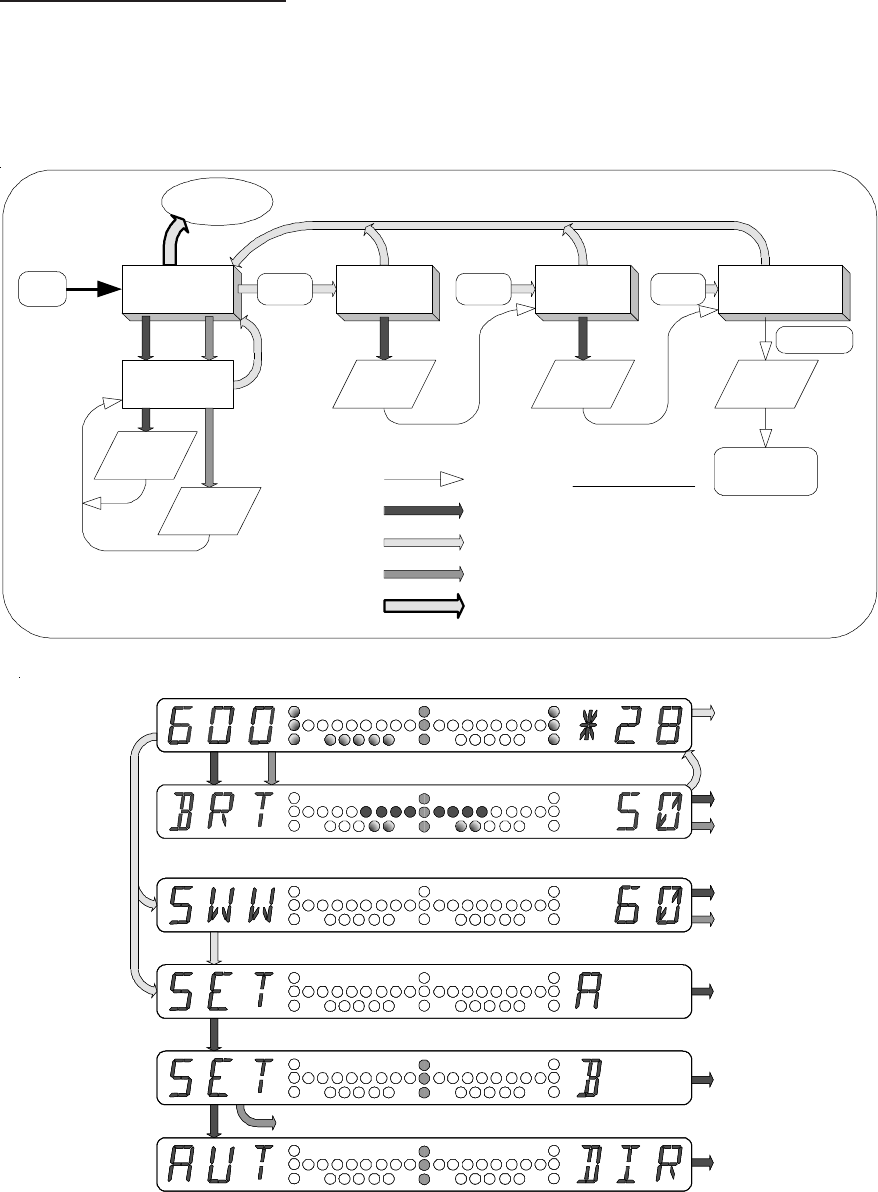
9
Basic Swathing Menu Navigation Diagrams
Menu Navigation Diagram #1 conditions:
Tape Measure is OFF
Headlands control is OFF
Direction is Auto
A-B Marks have not been set
enter
Configuration
Mode
RGL 600
Operational Mode
Menu Navigation Diagram #1
BRT
Decrease
Brightness
Increase
Brightness
Power
ON SET A
Set the
B Mark
Set
Direction
SET B AUT DIR
if A is
not set
if A is
set
if A-B
are set
to
Menu Navigation
Diagram #2
press MENU Button
press DOWN Button
press SELECT Button
press and hold MENU Button
Automatic (no button press)
turn toward
Swath #2
Set the
A Mark
Hold 3 sec.
to CFG
Firmware Version *2.8
SELECT increase
s
brightness.
DOWN decreases
brightness.
A-B Line
Setup
Press SELEC
T
to mark A.
Turn toward
Swath 2.
Direction will
set Automatically.
Display
Brightness
Adjust
Screen
Turn Left or Right toward field
To mark Temp B
Press SELECT
to mark B.
Down for temp B
.
SELECT increase
s
Swath Width
DOWN decreases
Swath Width.
Hold 3 sec.
to CFG
Firmware Version *2.3
M
ain Screen
RGL 600
SELECT increase
s
brightness.
DOWN decreases
brightness.
A-B Line
Setup
Press SELEC
T
to mark A.
Turn toward
Swath 2.
Direction will
set Automatically.
Display
Brightness
Adjust
Screen
Turn Left or Right toward field
To mark Temp B
Press SELECT
to mark B.
Down for temp B
.
SELECT increase
s
Swath Width
DOWN decreases
Swath Width.
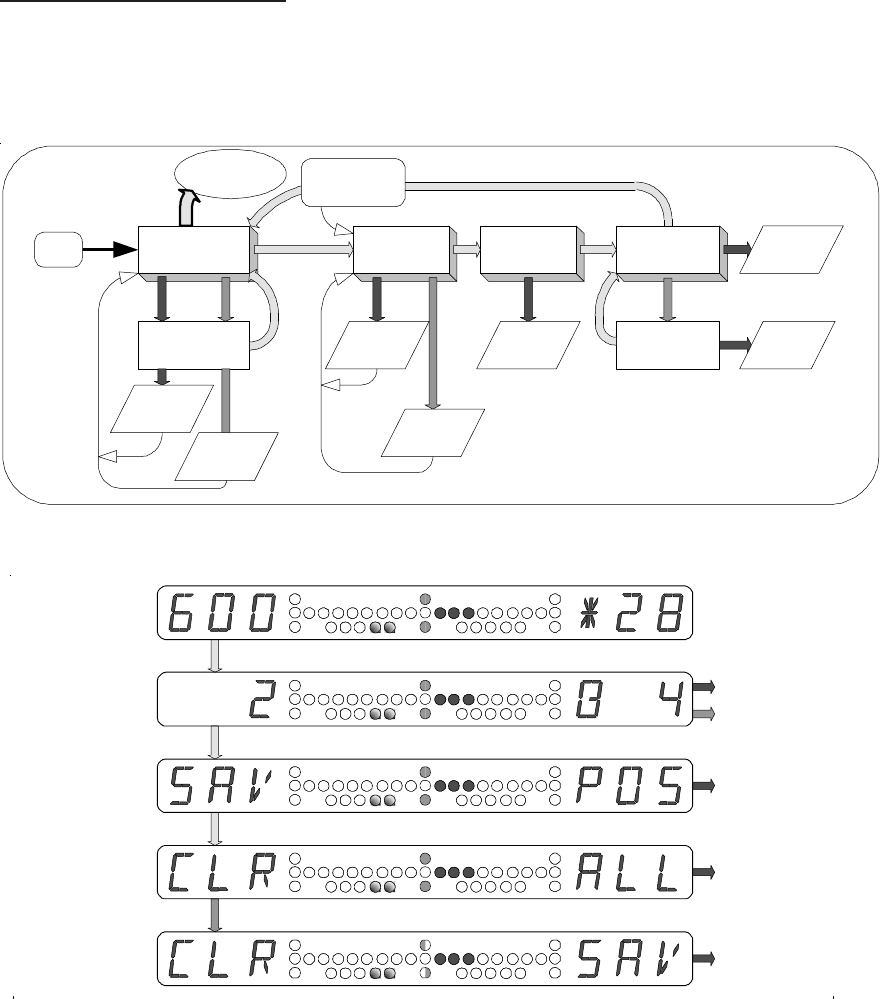
10
Menu Navigation Diagram #2 conditions:
Tape Measure is OFF
Headlands control is OFF
A-B Marks and Direction are set
enter
Configuration
Mode
Operational Mode
Menu Navigation Diagram #2
BRT
Decrease
Brightness
Increase
Brightness
Power
ON 2 SAV
CLR SAV
CLR ALL
Decrement
Swath #
Advance
Swath # Save
Position
Skipped if a Position
is Saved
Skipped if no
Position is Saved
Swath Number
Clear
ALL
Clear
Saved
Position
RGL 600
from
Menu Navigation
Diagram #1
We are 4 feet left of Swath #2 pointing 4° to the right.
Main Screen
RGL 600
Swath
Navigation
Swath number is
Displayed
SELECT
advances,
DOWN
decrements
swath
press SELECT to
Save current
position
SELECT Clears
A-B marks
and Saved Position
SELECT
Clears
Saved Position
A-B (instead of ALL) is displayed if there is No Saved Position
if there is a Saved Position
Save the
Current Position
Steer in direction of red LED's
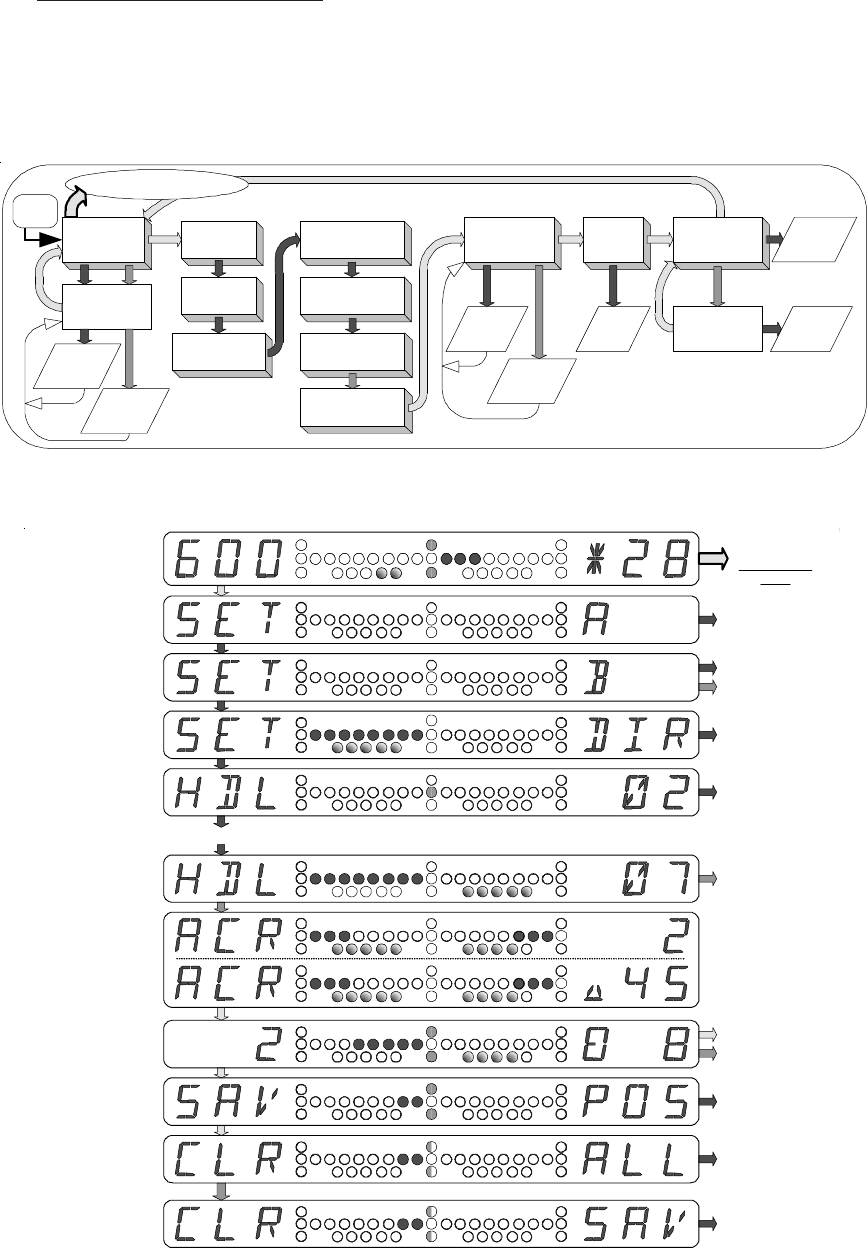
11
Combined Headlands Menu Navigation Diagram
Menu Navigation Diagram #3 conditions:
Tape Measure is OFF
Headlands control is Combined (CMB), DIR is MAN
Headlands and A-B marks are clear
enter Configuration Mode
RGL
600
ACR
2 SAV
Operational Mode
Menu Navigation Diagram #3
CLR SAV
CLR ALL
BRT
Decrement
Swath #
Advance
Swath #
Power
ON
Skipped if a Position
is Saved
Skipped if no
Position is Saved
Swath Number
HDL 02SET A
SET B
SET DIR
HDL 03...
HDL xx
HDL 00
HDL 01
Set Direction
Clear
ALL
Clear
Saved
Position
Save
Position
Increase
Brightness
Decrease
Brightness
Main Screen
Swath
Navigation
Area defined by
marked Headland
s
is 2.45 acres
We are 8 feet right of Swath #2 and pointing 11° left of it. SELECT advances
DOWN decrements
swath.
Drive and press Select to mark Headland points 03...07
SELECT
Saves
Current Position
SELECT
Clears ABC,
HDL, and
Saved Position
SELECT
Clears
Saved Position
only
if there is a Saved Position
Save
Current Position
DOWN goes to Clear
Saved Position
sub-menu
Center green LED's indicate we are Outside of the Leave Zone
DOWN marks
last
HDL point.
SELECT marks
HDL points.
SELECT
to Set Direction.
SELECT to mark B
.
DOWN for temp B
SELECT
to mark A.
Mark A-B
Mark
Headlands
Display
Area
press and hold
DOWN to enter
Configuration
Mode
Set Direction
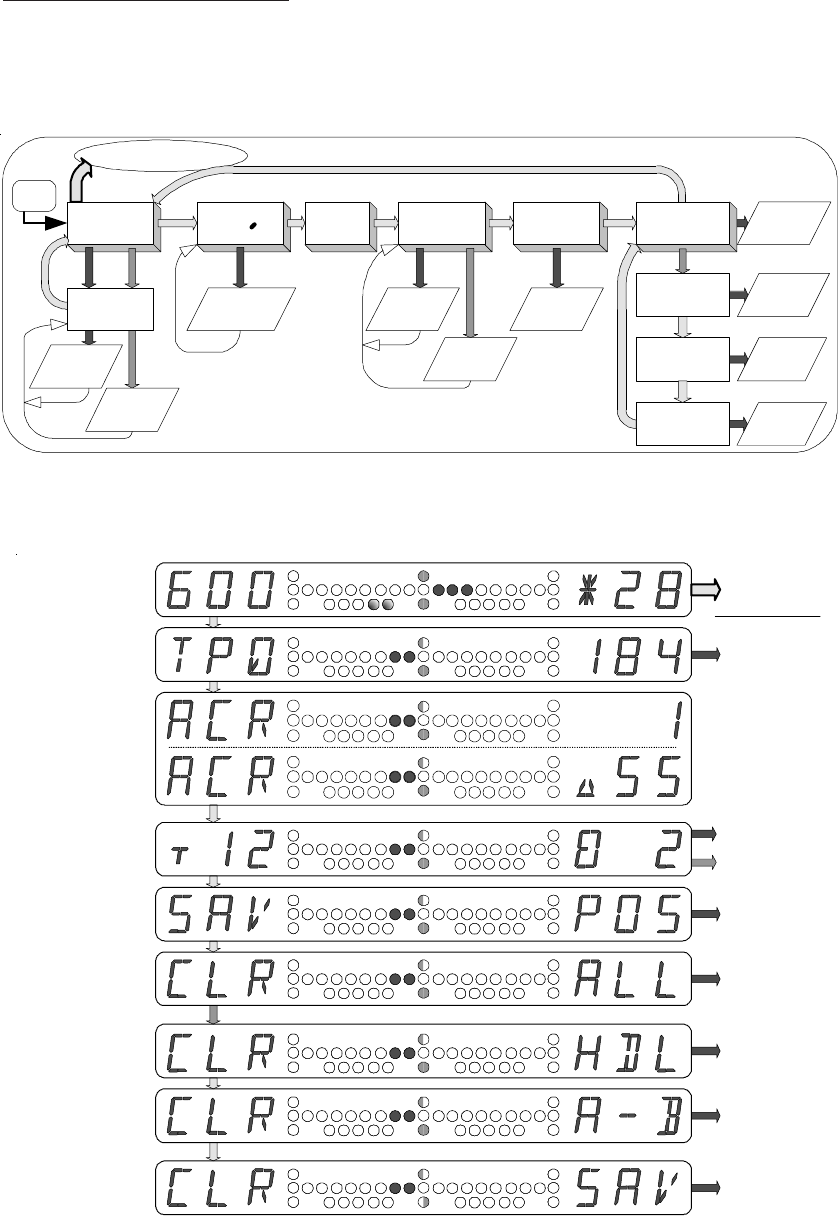
12
Separate Headlands with Tape Measure Menu Navigation Diagram
Menu Navigation Diagram #4 conditions:
Tape Measure is ON
Headlands control is Separate (SEP)
Headlands, A-B marks, and DIRection are set
enter Configuration Mode
RGL
600 TPO ACR 2 SAV
Operational Mode
Menu Navigation Diagram #4
CLR A-B
CLR SAV
Decrement
Swath #
Advance
Swath #
Decrease
Brightness
Set Tape
Reference point Save
Position
Increase
Brightness
Power
ON
Skipped if a Position
is Saved
Skipped if
no Position
is Saved
Swath Number
Clear
ALL
Clear
Headlands
Clear
A-B
Clear
Saved
Position
CLR ALL
CLR HDL
BRT
We are 2 feet right and parallel to the swath line. Approaching Headlands.
Main Screen
Swath Navigation
(Headland boundary
is 12 ft ahead)
SELECT advances
DOWN decrements
swath.
press
SELECT to
Save current positio
n
SELECT clears
A-B, HDL,
and Saved Position
SELECT
clears
Saved Position
only
if there is a Saved Position
Save
Current Position
SELECT
clears
HDL only
SELECT
clears
A-B only
SELECT
sets
Tape Reference
Point
We are 184 feet from the
Tape Reference point
which is left and behind.
Area defined by
marked Headlands
is 1.55 acres
press DOWN to clear
separate items
Center green LED's indicate we are Leaving the Save Position Zone
press and hold
DOWN
to enter
Configuration Mode
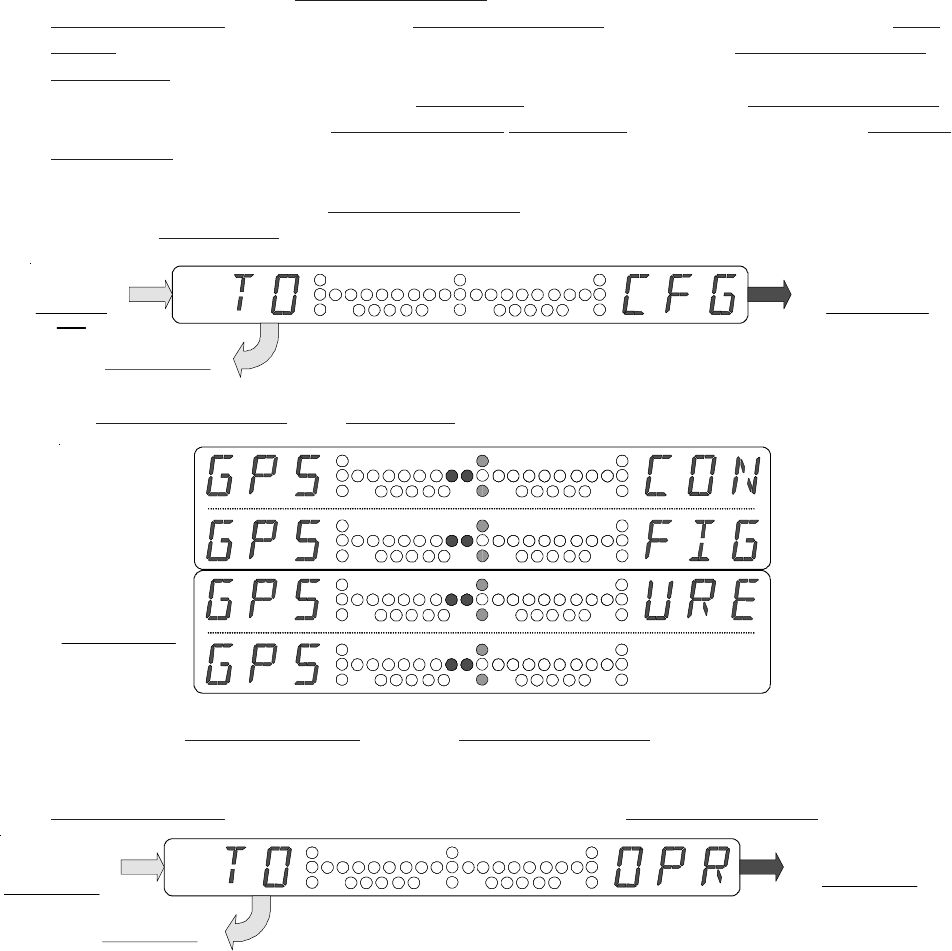
13
Entering and Leaving the Configuration Mode
Controlled access to the Configuration Mode prevents inadvertent entrance during normal
Operational Mode activity. Once the Configuration Mode is entered, there are several main
menus that are displayed sequentially by pressing the MENU button. Configuration Mode
main menus are identified by the word “CON...FIG...URE...” displayed sequentially in the right
alphanumeric display (see the [GPS] main menu example below). The Configuration Mode
can only be entered from the Operational Mode main screen [RGL 600]. To enter the Configu-
ration Mode, press and hold the MENU button for approximately 3 seconds. When the
[TO...CFG] screen shows (see below), the MENU button may be released. Press the
SELECT button to enter the Configuration Mode or press the MENU button to return to the
[RGL 600] main screen.
The Configuration Mode GPS main menu is displayed first as shown here.
Return to the Operational Mode from any Configuration Mode menu by pressing and holding
the MENU button for approximately 3 seconds. When the [TO...OPR] screen shows (see
below), the MENU button may be released. Press the SELECT button to return to the
Operational Mode or press the MENU button to stay in the Configuration Mode.
Press and hold
MENU to enter
Configuration
Mode
SELECT
enters
Configuration Mod
e
Press MENU to cancel
Configuration Mode
[
c]
[
d]
[a
]
[
b]
Display
sequences
between
[a], [b], [c], and
[d]
Typical of all
Configuration Mode
Main Menus
Press and hold
MENU to return to
Operational Mode
SELECT
returns to
Operational Mod
e
Press MENU to cancel
Operational Mode

14
The Smartbar Configuration Mode
There are normally 7 main menus in the Configuration Mode as listed here:
GPS GPS Receiver Status monitoring
SWA Swath Configuration parameters
SYS System Configuration (includes BAUD rate)
MSG Output Messages control (present only if SYS-MSG=ON)
DSP Display Settings (present only if SYS-DSP=CFG)
IAS Inertial Augmentation System (configuration for optional tilt compensation)
DIA Diagnostic Built-In Testing
Pressing the MENU button at a Configuration Mode main menu will view the next Configura-
tion Mode main menu. Pressing the MENU button at last main menu will view the first main
menu [GPS]. The SELECT button is not funtional for Configuration Mode main menus. Press
the DOWN button to go down from a main menu, into its sub-menus. Then press the MENU
button to go through the sub-menus. After the MENU button has been pressed for all of the
sub-menus, the same main menu is displayed again. This provides a quick return to a sub-
menu that may have been passed unintentionally. The DOWN button will reenter the same
main menu’s sub-menus, or the MENU button will proceed to the next main menu.
The Output Messages control (MSG) main menu is present only if SYS-MSG is set on ON.
The Display Settings (DSP) main menu is present only if SYS-DSP is set to configure (CFG).
The Inertial Augmentation System (IAS) main menu is present only if optional tilt compensa-
tion is installed.
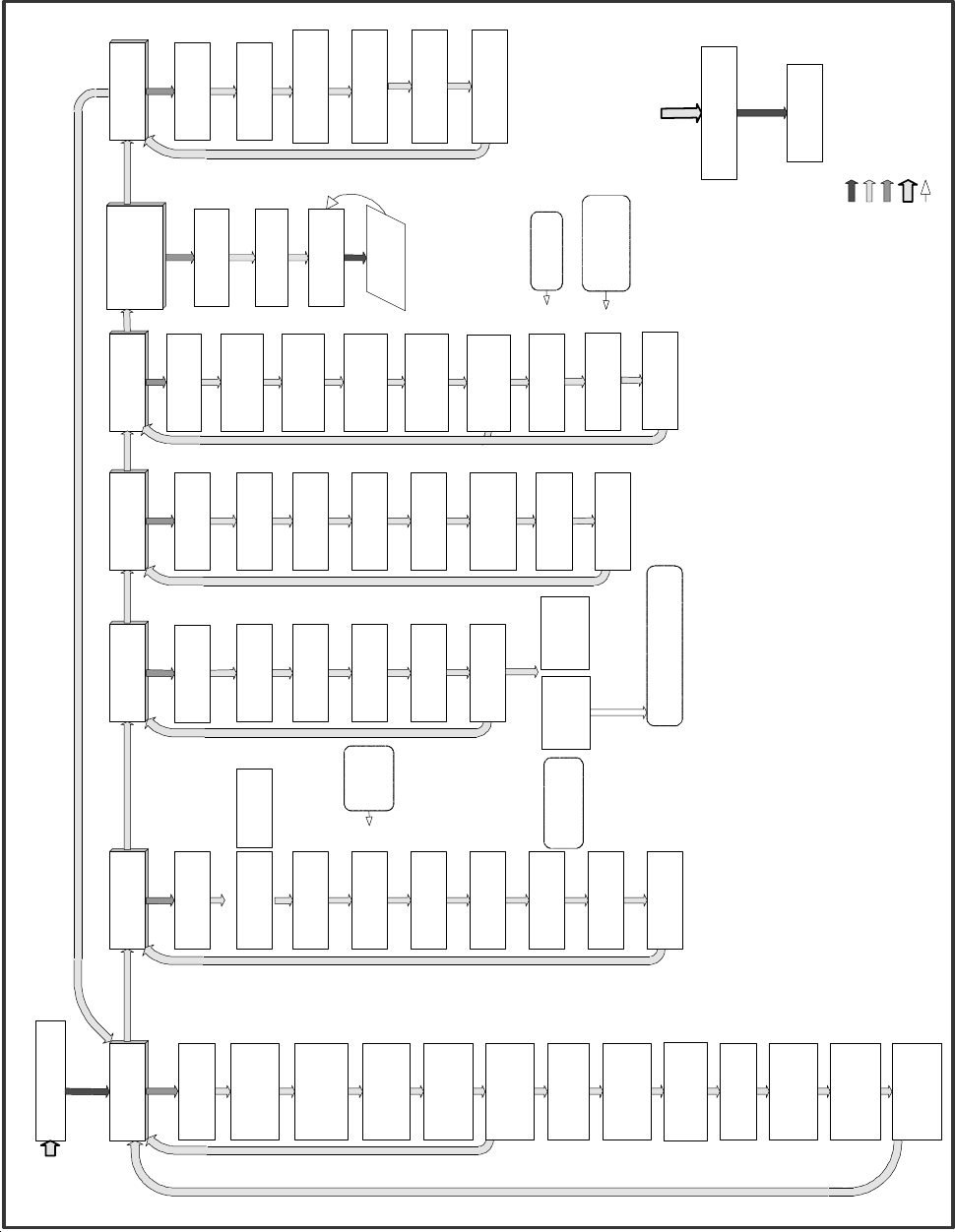
15
press & release MENU Button
press DOWN Button
press SELECT Button
press & hold MENU Button
Automatic (no button press)
DSP
Display Settings
SYS
System Settings
SWA
Swath
NPS, G-2, G-3,
D2X, D3X,
right display is
number of
satellites
G=GPS
A=AOD
D=Differential
Bottom 2 GPS
LED alarm if
less than 2.1.
seconds
degrees
GPS
DGPS Status
D3X
Receiver Position
Status
HDP
HDOP
(accuracy)
AOD
Age Of
Differential Data
SOG
Speed Over
Ground
SWW
Swath Width
SCL
Offset Scale
ANG
Angle Display
HDL
Headlands
UTS
Units
MSG
Output Messages
TAP
Tape Measure
CKS
FW Checksum
SER NUM
Unit Serial Number
enter
Configuration
Mode
ATO
Along Track Off
Configuration Mode Menu Navigation Diagram
48, 96,
192,
384,
AUT
OFF
ON
OFF
ON
BF, SNP, ROW,
PVT, CON, SED,
RT, SQ, ONE.
FIN, NRM,
CRS, AUT
OFF
ON
FIN
OFF, SEP,
CMB, DHC
FT - Miles/Hr
MT - Km/Hr
FT
FTF
MT
5-500 ft
5.0-95.0 ft
1-999 dm
FT
FTF
MT
(0.1-99.9 m)
FT
FTF
MT
-99 to +99 ft
-19.9 to +50.0 ft
-99 to +99 dm
(-9.9 to +9.9 m)
FT
FTF
MT
-99 to +99 ft
-19.9 to +19.9 ft
-99 to +99 dm
(-9.9 to +9.9 m)
press and hold
MENU Button
TO...CFG
DIR
Swath Direction AUT
MAN
PMR
Pivot Min Radius CON
Contour Type
NRM
FIN
VFN
CPFS
NRM
CFG
DSP
Display Settings
GUI
Guidance
Display
NRM
ADV
NRM
OVR
COG
Course Over
Ground
XTO
Across Track Off
OFF
ON
XIN
Switch Inputs
EVT
Events
GER
Guidance Errors
VCT
Vectors
GUP
Guidance
Updates
PLT
Plot Messages
MRK
Manual Marks
OFF
ON
SEC
OFF
ON
OFF
ON
OFF
ON
OFF
ON
SEC
OFF
ON
OFF
ON
DIA
Diagnostics
IAS
Inertial
Augmentation
System
AHT
Antenna Height
ANG
Angle - degrees
Calibrate
Tilt Sensor
1.0-40.0 ft
0.10-9.99
mt
180
to
0
to
-179
OFF,
SLO,
NRM,
FST
if MSG = ON if DSP = CFG if Tilt Sensor
Option is installed
skipped if
SWT=ROW,PVT,
CON, SQ, RT
if SWT = CON
if SWT = PVT
2BT
1BT
0BT
only if
SWT = CON
SPL
Special Angle/
Off
ON
OFF
CON
Contour Control
APR
Approach
Display
ON
OFF
FLA
OFF
Offset Direction
NRM
REV
SAV
Save Pos
Distance
XTO
RNG
SET DEF
Set Default Config
MSG
Output Messages
DSP
Display Test
GPS
Display Setting
SWT
Swath Type
GPS
Alarms BPS
BAUD Rate POS
Position TLT
Tilt Mode
RGL 600
Home Screen
press and hold
MENU Button
from any
Configuration Mode
screen
return to
Operational
Mode
TO ... OPR
skipped if
SWT=ROW,
PVT,CON,
SQ, or RT
Displays
Invicta
Receiver
Serial #
Displays
Receiver
Invicta
Firmware
SET PRN
122-138
or OFF
SNO
Receiver Serial #
VER
Receiver
firmware
WAS
Waas Satellite
PRN #
TRK
Tracking Status SYN
SRH
SNR
Signal to Noise
Ratio
PPR
Parity Pass Ratio
%0 to 100
XX.X
XXX
INV
GEN
GPS
Inv or Gen
SEL TO INI automatically sets
inv port that LB-5 is connected
Baud 19200, GGA, VTG.
SEL TO INI
GPS menu
SNO, VER
if GPS = INV
GPS menu
stops at COG
if GPS = GEN
OPR
CFG CFG removes
SWW from OPR
mode
SWW
Swath width
IF
GPS
GEN
IF
GPS
INV
CPM
Corrections p/
minute
LSC
Limit Swath Cal
ON
OFF
TPF
Temp in Farenheit
TPC
Temp in Celsius

16
The Smartbar Configuration Mode (continued)
GPS - GPS Receiver Status monitoring
GPS GPS Status Indication (display only)
D3X GPS Mode and Number of Satellites (display only)
HDP Horizontal Dilution Of Precision (HDOP) (display only)
AOD Age Of Data (display only)
SOG Speed Over Ground (display only)
When using a Raven receiver and SYS-GPS is set to INV, the GPS Main Menu will display the
following screens:
SNO Receiver Serial # (display only)
VER Receiver Firmware (display only)
WAS Waas Satellite PRN (allows setting PRN on RPR 110W and RPR 115 Invicta
Receivers).
Press SELECT button, ‘SET PRN’ screen will be displayed.
Press SELECT button to select PRN #’s between 120 to 138 or OFF.
Press MENU to send changes to Invicta Receiver.
TRK Tracking Status SYN (Synchronized) or SRH (Searching) (display only)
SNR Signal to Noise Ratio (display only)
PPR Parity Pass Ratio % (display only)
CPM Corrections Per Minute (display only)
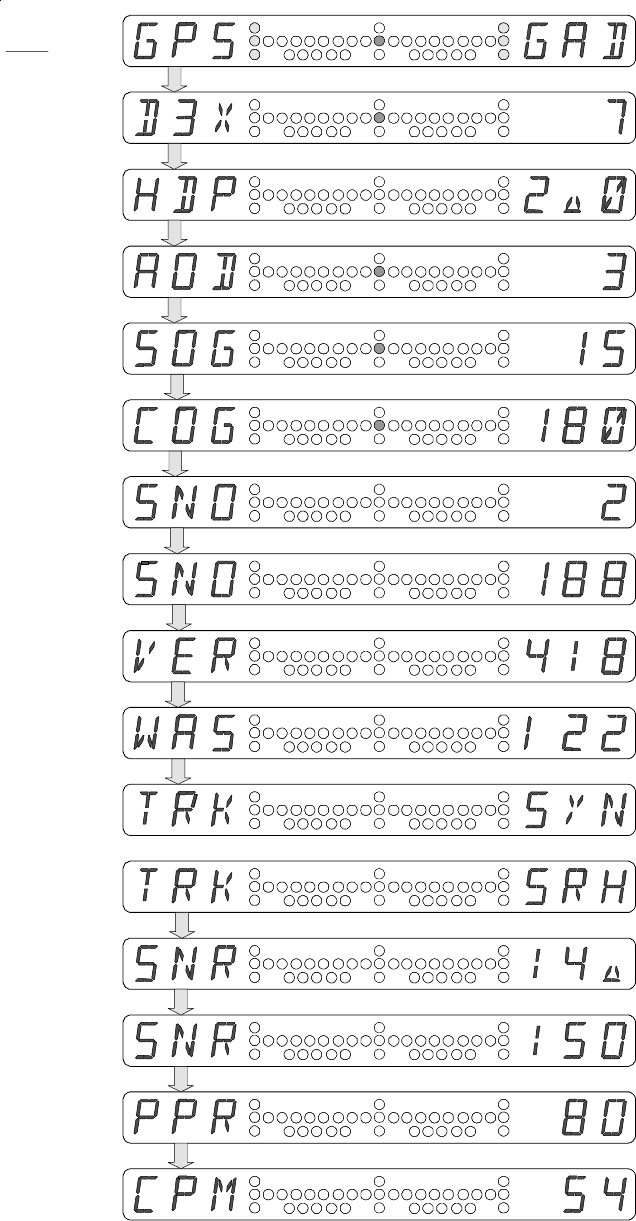
17
Receiver Position Status definitions:
NPS no position
G-2 2D navigation, no differential correction
G-3 3D navigation, no differential correction
D3X 3D navigation, with differential correction
First GPS
sub-menu
Receiver
Position Status
(NPS, G-2, G-3,
D2X, D3X)
Alarms,
G=GPS,
A=Accuracy,
D=Differential
Shows dashes when no
alarms present
7 GPS Satellites
being used
HDOP (Accuracy)
should be less than 2.1
or bottom 2 GPS Statu
s
LED’s come ON
Differential Age of Data
is 3 seconds
Speed Over Ground
Meters - Km/Hr
English - Statute miles/Hr
Course Over Ground
in degrees
**When using a Raven receiver and SYS-GPS is set to INV, the GPS Main Menu will display the following screens
OR
Receiver Serial #
Receiver Firmware
WAAS PRN - Allows
setting PRN on RPR
110 and RPR 115
Tracking Status
Synchronized
Tracking Status
Searching
Signal to Noise Ratio
Parity Pass Ratio
Correction per Minut
e

18
THE SMARTBAR CONFIGURATION MODE (continued)
SWA - Swath Configuration parameters
SWT Swath Type
Press SELECT button to select Swath Type Back-and-Forth (BF), Snap-To-
Swath (SNP), Row Swathing (ROW), Pivot swath pattern (PVT), Contour
Swathing (CON), Seed Swathing (SED) Squeeze pattern (SQ), Racetrack
pattern (RT), or One Button (ONE).
Swath
Type Description Function
BF Back-and-Forth SELECT button is used (in the Operational Mode) to
advance or decrease the swath number as required.
SNP Snap-To-Swath The swath number is set automatically to the swath
nearest the curent position.
ROW
Row Swathing
Special guidance is shown for driving down crop rows.
PVT Pivot pattern Sequences to mark and follow a circular pattern are
used.
CON
Contour Swathing
Guidance to curved swath patterns is given.
SED Seed Swathing
Used for seeding much like BF except that whenever
the SELECT button is pressed to advance to the next
swath, an "auto swath calibrate" occurs.
SQ Squeeze pattern A special swath number sequence is used for aviation
crop applications.
RT Racetrack pattern A special swath number sequence is used for aviation
crop applications.
ONE One button swathing One button setting is the same as Snap-To-Swath
operation, with no need to set point A and B.
PMR Pivot Minimum Radius
This configuration setting will only be present if SWT=PVT (Pivot Swathing). The PMR
setting controls the smallest circle to be sprayed.
Press SELECT button to set the Pivot Minimum Radius as required. As you press the
SELECT button the PMR increases by 10 ft (FT/FTF) or 1.0 meter (MT). The DOWN
button decreases the PMR by 1 ft (FT/FTF) or 0.1 meter (MT). You can hold down
each button to quickly change the settings.
The maximum PMR setting is 999 feet or 99.9 meters.
CON Contour Type
This configuration setting will only be present is SWT=CON (Contour Swathing).
Press SELECT button to select between Contour Types CRS (Course), NRM
(Normal), FIN (Fine), or VFN (Very Fine). The default setting is NRM and may be
used in most applications. The FIN and VFN settings reduce the maximum length
of a contour swath. The CRS setting increases the maximum length of a contour
swath.
See the section Contour Swathing - Contour Type Configuration Setting for
details on setting the Contour Type.

19
THE SMARTBAR CONFIGURATION MODE (continued)
SWW Swath Width
Press SELECT button to set the Swath Width as required. The boom width of your
machine determines the swath width. As you press the SELECT button the width
increases by 5 ft (FT), 5.0 ft (FTF), or 10 decimeters (MT). The DOWN button
decreases the width by 1 ft (FT), 0.1 ft (FTF), or 1 decimeter (MT). You can hold down
each button to quickly change the settings.
The following table shows SWW setting ranges for each units setting (SYS UTS):
units min SWW max SWW
FT
- feet
5
ft
500
ft
FTF
- feet fine
5.0
ft
95.0
ft
MT
- metric
1
dm (0.1m)
999
dm (99.9m)
DIR Swath Direction
This configuration setting is not present if the Swath Type (SWT) is set to ROW, PVT,
CON, SQ, or RT.
Press SELECT button to select AUT (Automatic) or MAN (Manual) Swath Direction
control. The default is AUT and should be used in most applications to eliminate a
button press after marking the A-B line.
The Swath Direction determines on which side of the A-B line swath numbers are
positive. Generally, this is the direction you will work the field.
When DIR is set to AUT, the Swath Direction is set automatically as the machine turns
past 75 degrees from the Course Over Ground (COG) when the B point was marked.
After the B point is marked, the Smartbar displays ‘AUT DIR’ until the 75 degree turn is
completed. Then the Swath Direction is set and Swath #2 guidance is displayed. The
Swath Direction may be set prior to completing the 75 degree turn, by pressing the
SELECT button, if desired.
When DIR is set to MAN, the Swath Direction is set by pressing the SELECT button
after marking the B point and turning in the desired direction to work the field. After the
B point is marked, the Smartbar displays ‘SET DIR’ until the SELECT button is pressed
to set the direction. Then Swath #2 guidance is displayed.
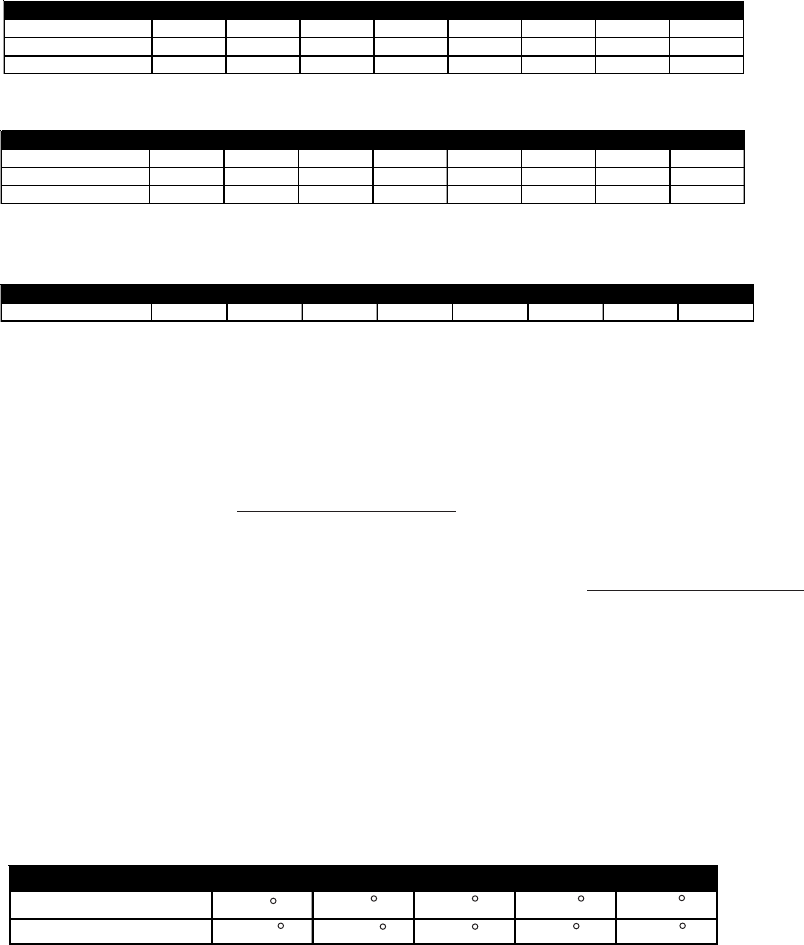
20
THE SMARTBAR CONFIGURATION MODE (continued)
SCL Guidance Offset Scale sensitivity
Press SELECT button to select between Swath Scales Fine (FIN), Normal (NRM),
Coarse (CRS), or Automatic (AUT). There are 8 offset LED’s on each side of center.
LED swath offset error distances for English units in feet (FT or FTF) as follows:
LED swath offset error distances for Metric units in meters (MT) as follows:
LED swath offset error distances for Auto SCL in percentage of Swath Width as
follows:
Custom Guidance Scales can be installed via the Raven Configuration Block (SCB).
Custome Scale names can also be assigned by the SCB. If custom scale names are
present in the SCB, those names will replace FIN, NRM, CRS, or AUT as Guidance
Offset Scale identifiers.
When the SCB control “Enable Scales Display” is turned ON, the DOWN button is
used to display the Offset distance for each LED of the Offset Guidance display. Press
the DOWN button to sequence through 8 Offset settings. Corresponding Offset LED’s
illuminate indicating which Offset value is displayed. When “Enable Scales Display” is
ON, only the SELECT button may be used for selecting Swath Scales. This is be-
cause the DOWN button is used to display the Scale settings.
ANG Angle Indicators
Press SELECT button to turn Angle Indicator LEDs OFF, ON, or FIN. The angle LED’s
indicate the difference between your Course Over Ground (COG) and the swath line
you are following.
LED swath angle error degrees for ON and FINe as follows:
NOTE: A special angle display indicates that COG is not valid and therefore the angle
error can not be displayed. This indication is all angle LED’s off except the far
left angle LED and the far right angle LED. This condition is usually caused by
low Speed Over Ground (SOG).
# of LED's
1
2
3
4
5
6
7
8
Fine 0.31.01.52.02.53.03.55.0
Normal 1.0 2.0 4.0 6.0 8.0 10.0 12.0 14.0
Coarse 4.0 6.0 12.0 18.0 24.0 30.0 36.0 42.0
# of LED's
1
2
3
4
5
6
7
8
Fine 0.1 0.2 0.4 0.6 0.8 1.0 1.2 1.4
Normal 0.3 0.6 1.2 1.8 2.4 3.0 3.6 4.2
Coarse 1.2 1.8 3.6 5.4 7.2 9.0 10.8 12.6
# of LED's
1
2
3
4
5
6
7
8
Auto 0.5% 1% 2% 4% 10% 20% 40% 50%
# of LED's
1
2
3
4
5
ON 1 3 6 10 15
FIN 0.5 1.5 3 6 10

21
THE SMARTBAR CONFIGURATION MODE (continued)
HDL Headlands Mode
HDL configuration is not present if Swath Type (SWT) is set to ROW, PVT, CON, SQ,
RT or ONE. SELECT button selects between OFF, SEP (Separate), CMB (Combined),
or DHC (Double Headlands C pattern). When OFF is selected, no headlands control
features are active. When CMB is selected, A-B line marking and headland marking
are combined. The first two points will be A-B line swath marks. After the A-B line is
marked and the swath direction is set, the display will show “HDL” (left side) and 03
(right side). The operator drives to the next headland position and presses the
SELECT button. Each point is defined in this way. Pressing the DOWN button at the
last display will show ACR (Acreage) and the right display will alternate between whole
acres and decimal part of acres. If the units are metric, then “ACR” is replaced by
“HET” (Hectares). When SEP is selected, headlands and A-B line marking are
separate. When DHC is selected, the Double Headlands C pattern is used. See the
section “Double Headlands C pattern” for details.
ATO Along Track Offset distance
The Along Track Offset distance adjusts the antenna position along the direction of
machine movement (COG). This adjustment moves the DGPS antenna position rela-
tive to the desired Along Track guidance point. Positive settings move the antenna
ahead of the guidance point. (for example: ATO set to +10 ft sets the guidance point
at the boom if the antenna is mounted 10 ft ahead of the boom). Negative settings
move the antenna behind the guidance point. Press SELECT button to set the Along
Track Offset distance.
XTO Cross Track Offset distance
The Cross Track Offset distance adjusts the antenna position across the direction of
machine movement (COG). This adjustment moves the DGPS antenna position rela-
tive to the desired Cross Track guidance point. Positive settings move the antenna
to the right of the guidance point. (for example: XTO set to +2 ft aligns the guidance
point with the boom center if the antenna is mounted 2 ft right of center). Negative
settings move the antenna to the left of the guidance point. Press SELECT button to
set the Across Track Offset distance.
Note: The following setting and range details apply to both ATO and XTO offset distance setting.
The SELECT button increases the offset distance by 5 ft (FT) 5.0 ft (FTF), or 10 decimeters
(MT). The DOWN button decreases the width by 1 ft (FT), 0.1 ft (FTF), or 1 decimeter (MT).
You can hold down each button to quickly change the settings.
The following table shows ATO and XTO setting ranges for each units setting (SYS UTS):
Note: If Along Track Offset and/or Cross Track Offset are not being used, be sure ATO and/or XTO
are set to 0. When using ATO or XTO, an accurate machine movement direction (COG) is
used to adjust the antenna position. COG measurement requires the machine to be moving.
Whenever machine speed is too slow for accurate COG measurement, the Angle LED’s will
show a special pattern indicating the speed is low (only outside amble Angle LED’s are on).
When the machine is stopped, the low speed indication is displayed and the previous valid
COG is used for ATO and XTO antenna adjustment.
Locating the antenna at the machine/boom center is recommended rather than using XTO
setting, where practical.
units min ATO/XTO max ATO/XTO
FT - feet -99 ft +99 ft
FTF - feet fine -19.9 ft +50.0 ft
MT - metric -99 dm (-9.9m) +99 dm (+9.9m
)
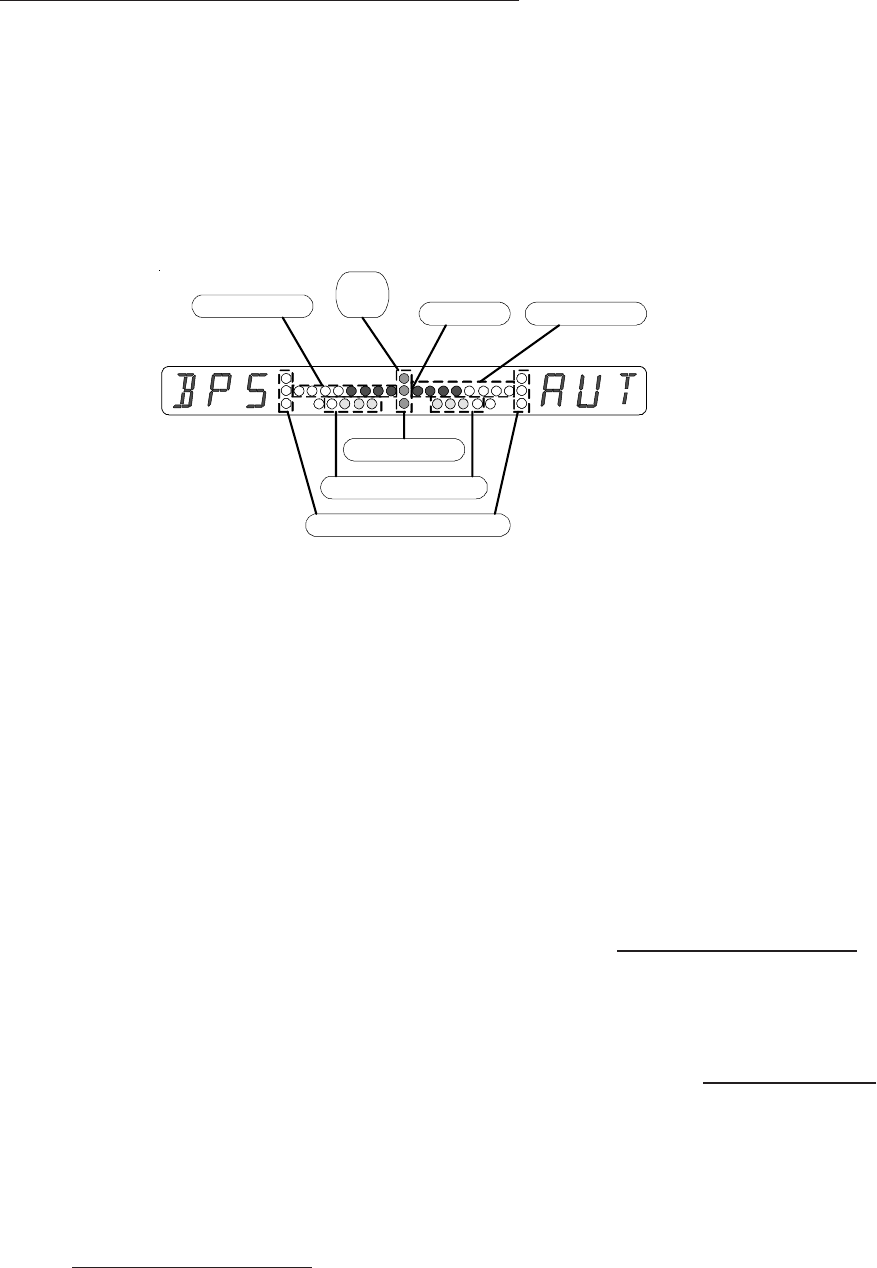
22
THE SMARTBAR CONFIGURATION MODE (continued)
SYS - System Configuration (includes BAUD rate)
BPS BAUD rate setting
The BAUD rate controls the data rate for messages received from the DGPS Receiver
and outgoing transmit messages. Press SELECT button to select AUT (Automatic
BAUD select), 38400, 19200, 9600, or 4800. The default setting is AUT. For most
installations, Auto BAUD should be used. Auto BAUD automatically determines the
DGPS Receiver transmission BAUD rate, then uses that BAUD setting to receive and
transmit. BPS stands for Bits Per Second.
Below is a typical BAUD rate setting screen with Auto BAUD at 19200.
UTS Feet, Feet Fine, or Metric Units
Press SELECT button to set the units to FT (English feet), FTF (fee fine mode), or MT
(Metric). When set to FTF, offset distance is shown in feet, and swath width (SWW),
Along Track Offset (ATO), and Across Track Offset (XTO) are shown in tenths of feet
(0.1 feet). When set to the metric mode, the Smartbar shows distances in decimeters
(0.1 meter). A swath width of 6.5 meters would be shown as 065.
Whenever UTS is changed, the Along Track Offset (ATO) and Cross Track Offset (XTO)
distances are set to 0. If the new UTS setting is MT, Swath Width (SWW) is set to 18.3
meters (183 decimeters). If the new UTS setting is FT or FTF, SWW is set to 60 feet.
MSG Outgoing Transmit Message Control
Press SELECT button to turn outgoing Messages ON or OFF. For operation without
data logging or other ancillary Light Bar Data monitoring equipment, Messages should
be set to OFF. When SYS-MSG is set to ON, the MSG configuration main menu is
enabled for selecting which messages are used.
TAP Tape Measurement Control
Press SELECT button to set the Tape Measurement mode ON or OFF. When Tape
Measurement is enabled, an additional sequence is added to the Operational Mode to
provide control and monitoring of distances. If Tape Measurement will not be used, it
should be set to OFF simplifying the operator’s control sequences.
DSP Display Settings
Press SELECT button to set Display Settings (DSP) to NRM (Normal) or CFG
(Configurable). The default setting is Normal. When SYS-DSP is set to CFG, the DSP
configuration main menu is enabled for configuring various Smartbar display and con-
trol options.
GGA message LED’s
Receive
Data
Signal Single Message VTG message LED’s
Multiple Messages
BAUD Rate LED’s showing 19200
GPS Status Alarms

23
THE SMARTBAR CONFIGURATION MODE (continued)
GPS GPS Settings
Press SELECT button to set GPS Settings (GPS) to GEN (generic not used) or INV
(Auto configure Raven Invicta Receiver). The default setting is GEN (Generic). When
SYS-GPS is set to INV, and MENU button is pressed ‘INV-SEL-TO-INI.’ will appear.
Pressing the SELECT button will automatically set up the port of the invicta receiver
that the RGL 600 is connected.
BAUD rate will be set at 19200, GGA-ON at 10HZ, VTG-ON at 10HZ.
DSP - Display Settings
GPS Optional DGPS Status Configuration format
Press SELECT button to set DSP-GPS to NRM or ADV (Normal or Advanced).
When DSP-GPS is set to NRM, the DGPS Status configuration main menu will display
six configuration sub-menus: GPS, D3X, HDP, AOD, SOG, and COG.
When DSP-GPS is set to ADV, the DGPS Status configuration main menu will display
four configuration sub-menus: GPS...D3x combined, HDP...AOD combined, SOG...COG
combined, and LAT...LON combined. This advanced setting allows monitoring of two
GPS status elements together and adds a Latitude and Longitude display. The ad-
vanced GPS display uses alternating display elements to show more data.
GUI Guidance Display
Press SELECT button to set DSP-GUI to NRM or OVR (Normal or Overlay).
The default DSP-GUI setting is NRM. Swath offset error distance is shown in the right
hand Smartbar alphanumeric display. If the offset error distance display uses less
than two digits, a General Direction to Target Indicator digit is shown in the third
digit. This indicator points toward the guidance target. See the section “General
Direction to Target Indicator”. As the offset error exceeds two digits, the third digit is
no longer available to display the General Direction to Target Indicator. When DSP-
GUI is set to NRM, the General Direction to Target Indicator is not displayed when
the offset error is greater than two digits. When DSP-GUI is set to OVR, the General
Direction to Target Indicator is displayed alternately with the three-digit swath offset
error. (i.e. it is overlayed)
OFF Offset Error display direction
Press SELECT button to set DSP-OFF to NRM or REV (Normal or Reverse).
The swath offset guidance Red LED bars normally light up pointing in the direction you
need to steer. This is the DSP-OFF default setting (NRM). To display the Red LED
bars in the opposite direction (the bar appears as if pointing toward the machine from
the swath line), set DSP-OFF to REV (Reverse). When DSP-OFF is set to REV, the
direction of the angle error indicator LED bars are also reversed.

24
THE SMARTBAR CONFIGURATION MODE (continued)
DSP - Display Settings (continued)
SAV Save Position Distance
Press SELECT button to set DSP-OFF to XTO or RNG (Cross Track Distance or Range).
When swathing a field, the current position can be saved by pressing the SELECT
button at a menu “SAV POS”. the DSP-SAV configuration controls what the right hand
alphanumeric display is showing while leaving and returning to a Saved Position.
The default setting is XTO (Cross Track Distance). When DSP-SAV is set to XTO, off-
set error to the saved swath line is displayed similar to swath offset error when there is
no Saved Position.
When DSP-SAV is set to RNG (Range), the right hand display shows the distance
from the current position to the Save Position. See the section “Saving Your Present
Position” for more details.
APR Headlands Approach Display
Press SELECT button to set DSP-APR to ON, OFF, or FLA (Flash).
When swathing with headlands, there are two approaches to headland boundaries.
One is from within the field. You approach the boundary entering the headland area.
This approach requires the spray control to be turned OFF by the operator at the head-
land boundary. The other is from the headland area into the field. This happens after
making an end of row turn and requires the spray control to be turned ON by the
operator at the headland boundary.
The Headland Approach Display indicates distance to the headland boundary as the
machine is approaching it. This is an aid to help the operator control the spray at the
proper point. The Headland Approach Display is shown to the operator in place of
the swath number. (i.e. in the Smartbar left alphanumeric display).
The default DSP-APR setting is ON. The DSP-APR setting allows the Approach Dis-
play to be turned OFF, or to flash (FLA). When DSP-APR is set to FLA, the swath
number and the approach distance are shown alternately in the left alphanumeric
display. See the section “Swathing with Headlands - Headland Approach Display”
for more details.
SPL Special Angle and Offset error display
Press SELECT button to set DSP-SPL to ON or OFF.
The Special Angle and Offset error display is used to indicate distance away from the
swath target when the machine is nearly perpendicular to the swath line. In this orien-
tation, it is difficult to determine which way the machine is heading. Therefore the left
or right sense of error offset indications may be unclear. See the section “Special
Offset and Angle Displays” for more details. DSP-SPL provides a configuration to
turn OFF this Special Angle and Offset error display.

25
THE SMARTBAR CONFIGURATION MODE (continued)
DSP - Display Settings (continued)
CON Contour Control
Contour Control configuration is present only if Swath Type (SWT) is set to CON.
Press SELECT button to set DSP-CON to 2BT, 1BT, or 0BT (Two Button, One Button,
or No Buttons). The Contour Control setting determines how much operator activity is
required when turning between rows using Contour Swathing. See the section “Con-
tour Swathing - Contour Control Configuration Setting” for more details.
SWW Swath Width Control
Press SELECT button to set Display Settings SWW (Swath Width) to OPR (Opera-
tional mode) or CFC (Configuration Menu). The default setting is OPR (Operational
mode). When OPR is selected, the SWW (Swath Width) menu will appear in the
Operational mode and in the Configuration Menu under SWA (Swath).
When CFG is selected, the SWW (Swath Width) menu will appear only in the Config-
uration Menu under SWA (Swath).
LSC Limit Swath Cal
Press SELECT button to set Settings LSC (Limit Swath Calibration) to ON or OFF.
The default setting is ON.
When LSC-ON is selected the Swath Calibration is limited to 1/4 of the current swath
width setting.
When LSC-OFF is selected the Swath Calibration limit is bypassed.
See the section “Swath Calibration” for more details.
IAS - Inertial Augmentation System
This IAS configuration main menu will be present if your Smartbar has the optional Tilt Sensor
upgrade installed. The four sub-menus under IAS are TLT (Tilt Mode), AHT (Antenna Height),
and ANG (Angle Display and Calibration). See the section “Smartbar Tilt Upgrade Option -
IAS Configuration” for configuration details.
DIA - Diagnostic Built-In Testing
DSP RGL 600 Built-In Display Test
Press the SELECT button to execute the Display Test sequence. The SELECT button
is pressed two times in the sequence to proceed past display inspection points. The
MENU button may be pressed at any time to abort the Display Test.
Shown with Boom Switch #1, #2, #3, and #5 closed
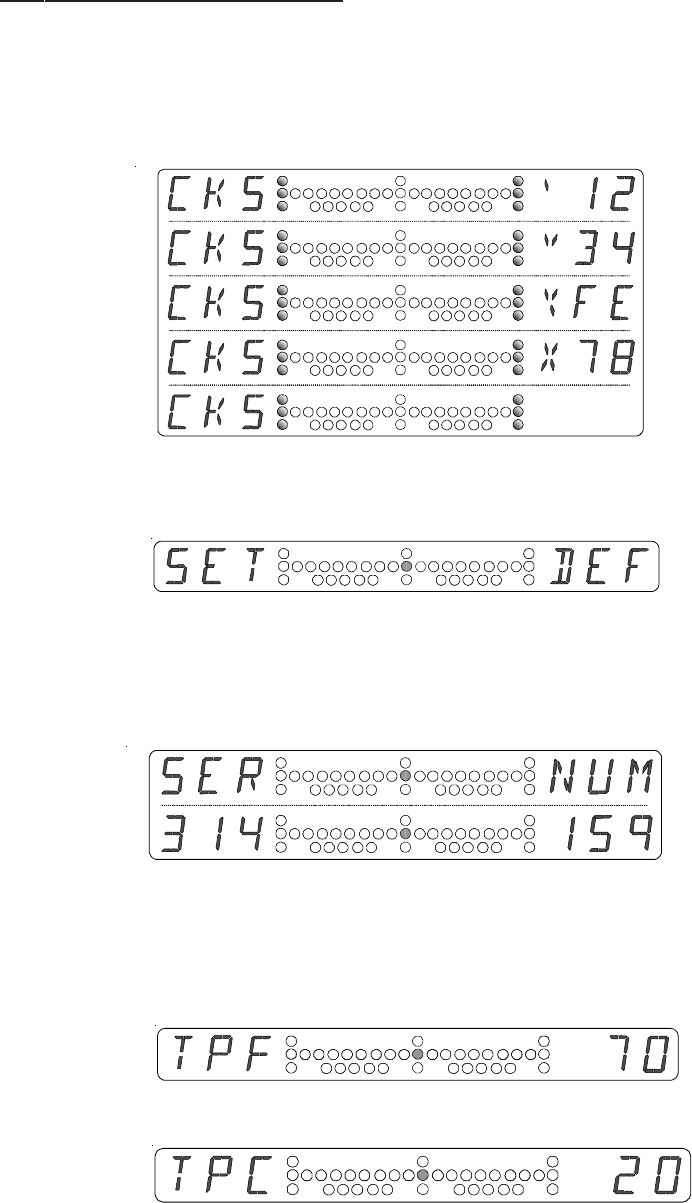
26
THE SMARTBAR CONFIGURATION MODE (continued)
DSP - Diagnostic Built-In Testing (continued)
CKS Program Memory Checksum
Press the SELECT button to execute a program memory checksum calculation. The
calculated 8 Hexadecimal digit checksum is displayed in 4 display cycles. (see below)
Firmware program integrity is validated if the indicated checksum matches a known or
published checksum for the current version.
SET..DEF - Reset Smartbar configuration settings to default values
WARNING: All existing Smartbar configuration settings will be erased.
Press the SELECT button to reset all Smartbar configuration settings to default values.
When the SELECT button is pressed, the Smartbar will restart to the home screen with
default values for all configuration settings.
SER..NUM - Smartbar 6 digit Unit Serial Number
This Serial Number matches the Model/Serial Number tag on the back of your Smartbar.
It is important to supply this Serial Number when requesting product or technical
support.
TPF Internal Board Temperature in Fo (Farenheit).
TPC Internal Board Temperature in Co (Celsius).
Temperature display menu only available in RGL600 with Tilt option installed.
Display sequences
between
[a], [b], [c], [d], [e
].
showing the
Hexadecimal numb
er
'1234FE78'
[
a]
[
b]
[
c]
[
d]
[
e]
[
a]
[
b]
Display sequence
s
between [a] and [b
]
showing
Serial Number
314159
27
BASIC SWATHING
The Smartbar has two basic parallel swath types: Back and Forth (BF) and Snap-to-Swath
(SNP). With each pattern you must first mark point A and then point B. This defines the A-B
line, which is swath number 1. Swath number 2 will be in the direction (from the A-B line) you
will work the field. If Direction (DIR) is configured for Auto (AUT), the direction to work the field
is established when the machine turns past 75o after marking point B. If Direction (DIR) is
configured for Manual (MAN), the operator presses the SELECT button, after turning from
marking the B point, to set the direction to work the field. DIR may be AUT or MAN for both BF
and SNP. The DIR default setting is AUT for both BF and SNP.
Once the A-B line is marked and the direction to work the field is established, then the light
bar knows where the swaths are for that field based on the swath width you specified when
configuring the Smartbar. The swaths are numbered 1, 2, 3... with the A-B line being swath 1.
Swaths on the opposite side of the A-B line than you are working are numbered -1, -2, -3, ....
For example, if you are using BF and your current swath number is 1, pressing the Down
button will decrement the current swath to -1. Pressing Down again will decrement the current
swath to -2. The offset distance is always relative to the current swath number.
The offset distance from the current swath is shown on the right alphanumeric display. The
offset distance LED’s are all off when you are on swath, and come on sequentially as you
leave the swath.
The offset angle LED’s are all off when you are parallel to the current swath, and come on
sequentially as your angle to the current swath increases.
IMPORTANT:
When traveling perpendicular to the current swath line, the direction you should turn to
correct is indeterminate. If the current Course Over Ground alignment to the swath
line is greater than about 70o, the angle and offset LED’s are displayed in special
manner. This special display aids in determining the location and orientation of the
swath line when the direction is close to perpendicular and the intended direction along
the swath line is indeterminate. See the section “Special Offset and Angle Displays”.
When swathing, all Smartbar GPS status LED’s should be out, indicating the GPS receiver is
operating properly. If one or two of the status LED’s are on, the accuracy of the light bar will be
impaired. If all status LED’s are on, swathing is either unreliable or non-functional.
The Guidance Status LED’s (refer to diagram item D on page 4) are used as follows:
The center LED is on if no offset error LED’s are on.
The top and bottom center LED’s are usually on when you are swathing (the
A-B line has been established), but change states when you are either ap-
proaching or within a headlands area. When the LED’s are on, it is okay to
spray. When the LED’s are off, you have entered a headland area, which has
already been sprayed. The top and bottom LED’s are also used when saving
and returning to a position. See ‘Headlands’ and ‘Saving Your Present
Position’.
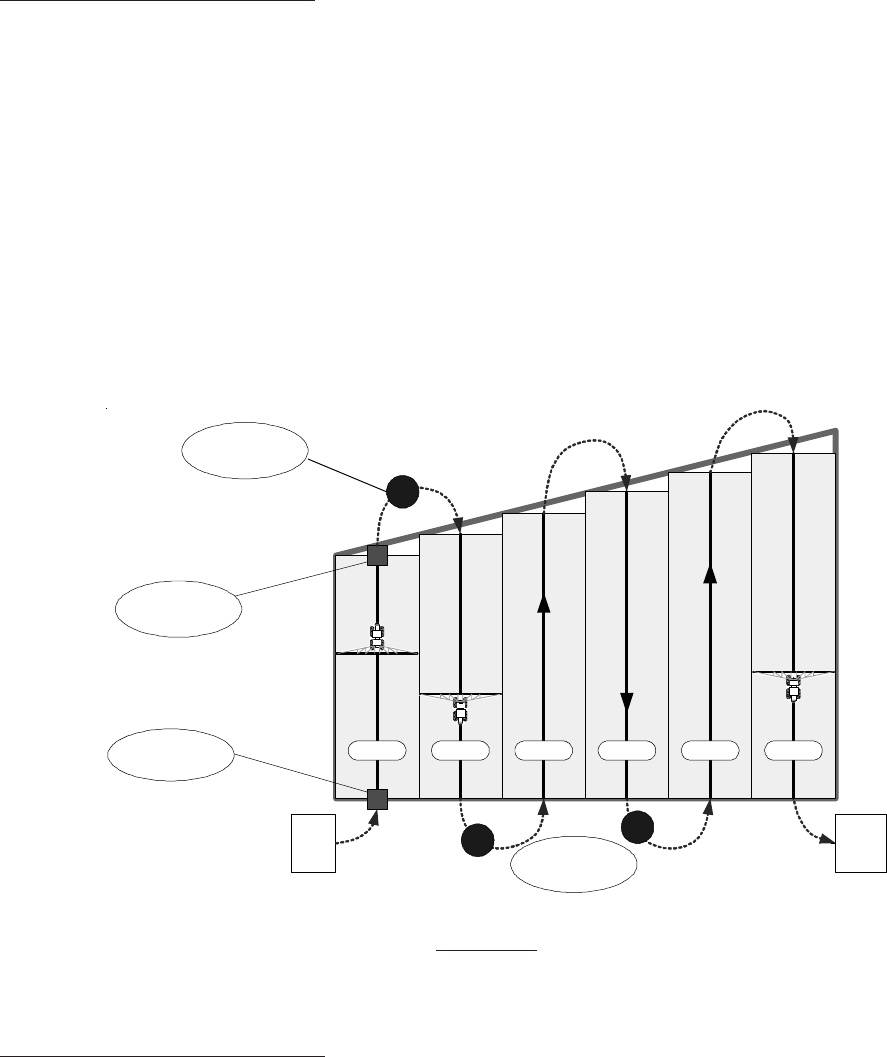
28
Back and Forth Swathing (BF)
Back and Forth swathing is used, as the name applies, to swath the field in first one direction
and then the other using swaths that are parallel to the A-B line. Below are the steps required
for BF swathing.
The straight line defined by marks A and B must be parallel to the remaining swaths. Make
sure the GPS antenna has a good view of the sky and the Smartbar shows NO alarm condi-
tions.
If DIR is set to Automatic (AUT), the Direction is set automatically when the machine turns
past 75o alignment to the A-B line. If DIR is set to Manual (MAN), press the SELECT button
(after marking B and turning) to set the direction.
The SELECT button and DOWN button are then used to choose the next swath you want to
run. Swaths are numbered in order but you can run any swath you want at any time and in any
direction.
Important
The ‘A’ and ‘B’ marks form a straight line that must be parallel to the remaining
swath paths. Ensure that no alarms are present while setting the ‘A’ and ‘B’ marks.
Snap-to-Swath Swathing (SNP)
When using SNP, the Smartbar will find the swath nearest to the current position and set the
swath number accordingly. Swath lines are numbered as in BF swath type. The SELECT/UP
button and DOWN button do not control the swath number as in Back and Forth Swathing.
With the SNP pattern, you can work the field with the least need for pressing Smartbar but-
tons.
First, mark the A-B line as you would with BF, and then make your turn. If (DIR) is set to Auto-
matic (AUT), the Direction is set automatically when the machine turns past 75o alignment to
the A-B line. The following section leads you through a step-by-step description of swathing
using either BF or SNP swath patterns.
B
A
Enter
Field
Here
Exit
Field
Here
Swath #1 Swath #2 Swath #3 Swath #4 Swath #5 Swath #6
press SET B button to
Mark the
B point
press SET A button
to Mark the
A point
SEL
SEL
SEL
If DIR=MAN
press SELECT button
to set direction
If SWT=BF
press SELECT button
to advance Swath #

29
To Begin Your First Swath
1. Make sure the GPS antenna has a good view of the sky and the system is operating
with NO alarm conditions. Using a visible site as a point of reference, steer a straight
line parallel to your intended swath paths as you mark your reference points A and B.
Important
The Smartbar will establish all subsequent swaths as parallel to the AB line, so
make sure no GPS alarms are present while establishing the A-B line.
2. Press the MENU button until you see the “SET A” display.
3. When you are lined up on the first swath, press the SELECT button to enter the “A”
mark. ‘SET B’ is displayed.
4. Continue to the end of the first swath path and press the SELECT button to enter the
“B” mark. You can also use a temporary mark B to cause the Smartbar to guide you
along the A-B line. After marking A, you can press the DOWN button to set a tempo-
rary B. The Smartbar will guide you along the new A-B line until you press the DOWN
button to create a new temporary A-B line or you press the SELECT button to set the
final A-B line.
5. Turn toward the next swath path. Press the SELECT button to set the direction if DIR
is set to MAN. If DIR is set to AUT, the direction is set automatically as the machine
turns past 75o. The display will indicate swath 2.
6. Once you reach the end of swath 2, you may press the SELECT button to advance to
the next swath (for BF). You can also select a lower numbered swath by using the
DOWN button. With the SNP swath type selected, the swath number is automatically
advanced or decreased, as you become closer to a given swath than any other swath.
7. The red offset distance LED’s indicate the direction you must steer to reach the swath
number you have selected. Simply steer in the direction of the LED’s. That is, if the
LED’s to the right of the center are on, steer right. If the LED’s to the left of center are
on, steer left. The distance (feet or decimeters) to the selected swath is shown on the
right side of the screen.
8. The Guidance Status LED’s in the center of the Smartbar work as described in Basic
Swathing, Headland Swathing, and Saving Your Present Position.
9. Offset in degrees provides an approximation of the angle at which you are approach-
ing the selected swath. The number of LED’s on the bottom row will increase as your
angle of approach to the selected swath increases. For example, if you are approach-
ing the selected swath at a 50o angle, the maximum number of bottom-row LED’s are
on. If however, you are parallel to the selected swath, these LED’s will all be off and
your distance to the next swath will not be changing. If you turn away from the
selected swath at a sharp angle, the number of LED’s will again increase and, of
course, your distance to the selected swath will be increasing. When used together,
the angle indicator and offset LED’s will help you judge your approach to the selected
swath. This provides the best indication of when to begin your turn onto the selected
path.

30
10. To enter new reference marks at the end of the current field or to change reference
marks: Pres the MENU button to display ‘CLR A-B’. Clear the current reference
marks by pressing the SELECT button.
NOTE: If your GPS receiver is outputting 10 messages per second, you may notice
that as you move over bumps and dips in the field, the steering LED’s change
rapidly. This is because the GPS antenna is moving from side to side and with
10 updates per second the receiver sees this as a change in position. (This
problem shows up more at lower speeds). For better accuracy, do not chase
the LED’s but try to center them across the display.
Clearing the A-B line
From the ‘CLR A-B’ menu screen, press the SELECT button to clear the A-B line. You will
have to enter new ‘A’ and ‘B’ marks to begin your next swathing operation. Clearing the A-B
line also clears the Save Position (SAV POS).
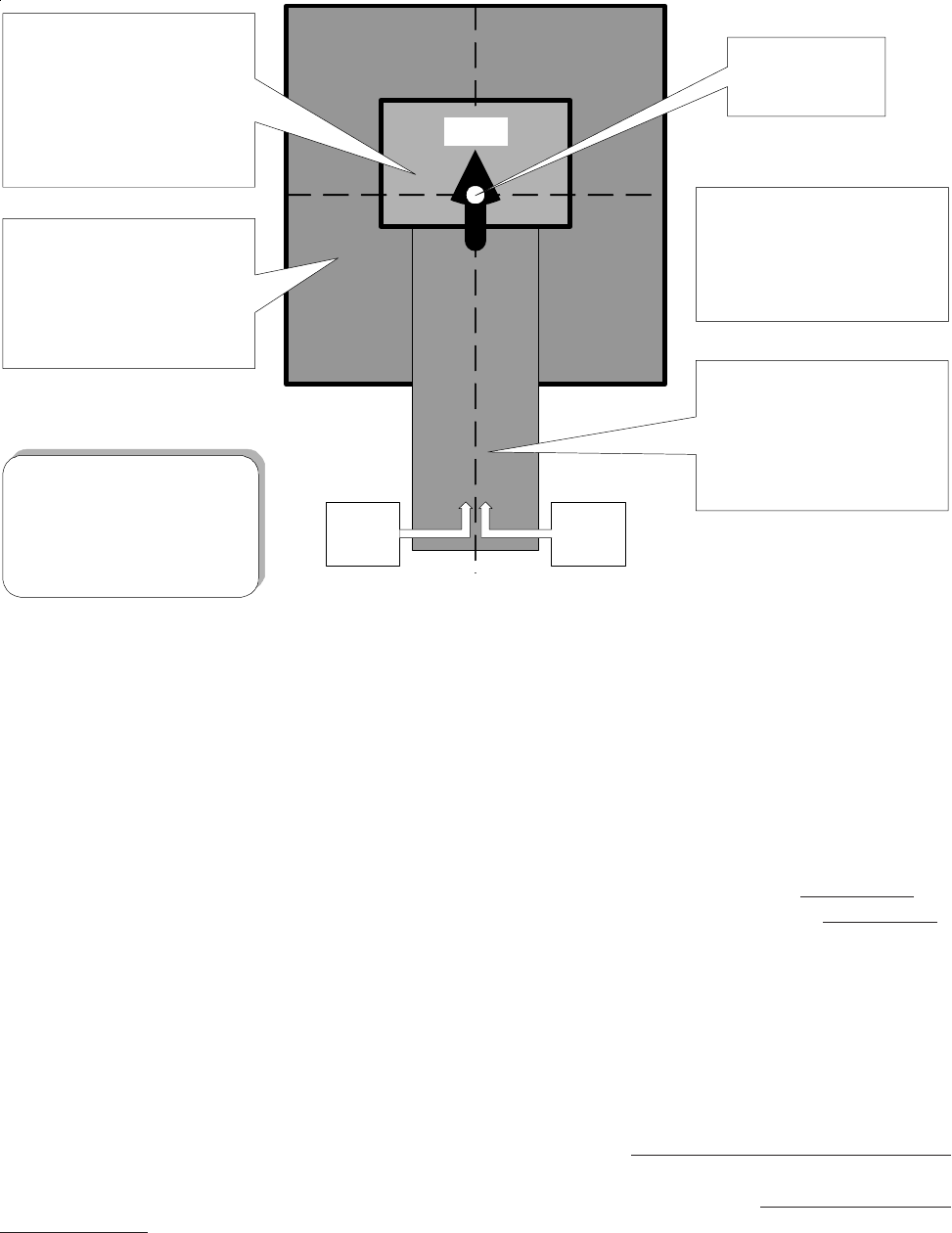
31
Outside
described areas
Save Lights
FLASH TOGETHER
Zones used
to describe
Leaving and Returning
to a
Saved Position
Leave Zone
60ft square
centered on Saved Position point.
Save Lights
FLASH ALTERNATELY
when leaving.
normal
return
path
normal
return
path
Arrive Zone
30ft wide x 20ft long,
begins 5 ft before
Saved Position point.
Save Lights
ON STEADY
after reaching this zone.
Saved Position
Point
COG
Approach Zone
±10ft from swath line
of Saved Position.
Save Lights
GO OUT
when returning.
COG line
Using the Smartbar ‘SAV POS’ function, you can leave your current swathing position and return to it
later to continue the present swathing operation. To save your current position, locate the ‘SAV POS’
screen on the menu and press the SELECT button. A position may be saved after stopping. How-
ever, do not back up prior to saving a position or the saved COG will be in the wrong direction.
In the following description, the upper and lower center green LED’s are referred to as the ‘save
lights’.
After saving your current position:
The Save Lights will FLASH ALTERNATELY until you exit the Leave Zone.
The Save Lights will FLASH TOGETHER after you have left the Leave Zone.
The Save Lights will GO OUT when you enter the Approach Zone indicating a
correct approach direction. (i.e. You are going in the same direction.)
The Save Lights will come ON STEADY when you reach the Arrive Zone. The
Smartbar is then ready to continue swathing.
When returning to a Saved Position Point, use normal swath guidance to find the Saved Position
swath. For BF and SNP the swath number is locked so all swath guidance indicators will guide you
back to the correct swath line. Look at the swath offset LED’s and the angle LED’s to find the Saved
Position swath. If you are perpendicular to the swath line, use the Special Offset and Angle Displays
(see separate section) to find your way back. Otherwise, notice if the offset distance (right alphanu-
meric) is increasing or decreasing to locate the Saved Position swath. Also the General Direction to
Target Indicator (see separate section) will point back to the saved position when there are available
digits on the offset display. Once the Saved Position Swath is located, use the diagram above to
navigate to the Saved Position point.
SAVING YOUR PRESENT POSITION
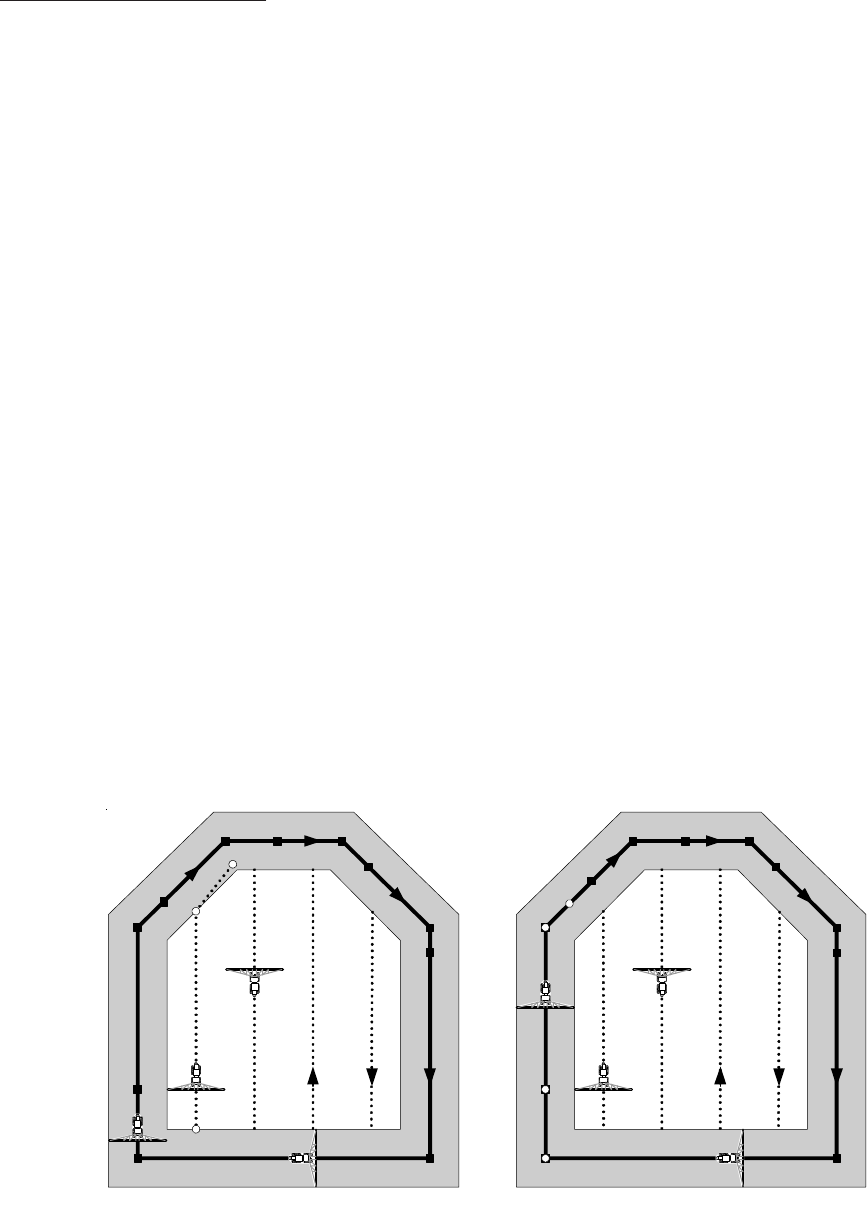
32
Swathing with Headlands
The area defined by the boom width, as you drive around a field perimeter, is known as the
‘headlands’ of the field. This is the area that cannot be reached by normal swathing if the field
is confined.
The Smartbar allows you to spray the headlands and then spray the rest of the field using
normal swathing. While swathing the part of the field that is inside of the headlands, the
operator is given indicators showing that the machine is approaching and/or crossing a head-
land boundary. As the machine approaches each headland boundary, the distance to the
boundary is shown to aid in accurate spray nozzle control. See the section Headland
Approach Display for details of these indicators.
The effective point where the machine crosses the headland boundary can be adjusted from
the antenna to the boom position using the Swath Along Track Offset configuration. (see
Smartbar Configuration Mode (SWA-ATO) Swath Along Track Offset for antenna to boom
adjustments).
You can select either of three headland modes: Separate (SEP), Combined (CMB), or Double
Headlands C pattern (DHC). When using the Separate Headlands mode, mark the A-B line
and direction separately from the headland points. When using the Combined Headlands
mode, the first few headland points and the A-B line are marked together. (i.e. when A is
marked, H01 is automatically marked). Combined has the advantage of making it easy to find
the first swath, the A-B line. Separate requires you to use a visual queue, such as a fence
line, to locate the A-B line.
For most jobs, Combined Headlands is the preferred method. Use the Separate Headlands
to swath fields where the A-B line does not correspond to one of the headland sections, an ir-
regular shape, or other special conditions. Use the Double Headlands C pattern when a
larger end-row turning radius is required.
Examples below show Separate and Combined headlands applied to the same field:
Shaded Area - Headland areas
Solid Line - Path of antenna within Headland Areas
Separate
H01
H02
H03
H04
H05 H06 H07
H08
H09
H10
H11
S1 S2 S3 S4
A
B
DIR
Combined
B
DIR
H01
H02
H03
H04
H05 H06 H07
H08
H09
H10
H11
B
S1 S2 S3 S4 S5
A
Temp

33
Separate Headlands
1. If HDL configuration is not already set to SEP, enter the Configuration Mode, go to
SWA main menu, HDL sub-menu, and set HDL to SEP. Exit the Configuration Mode.
2. Use the MENU button to advance to the HDL guidance screen.
3. Use the SELECT button to mark headlands points as you drive the headlands area.
In the diagram on the previous page, you would press the SELECT button at each of
H01 through H11. At any point in marking headlands, you could press the MENU
button and then go mark the A-B line and direction. You can then use the MENU
button to cycle back around to the HDL guidance screen.
4. As you are marking headlands, the guidance LED’s will keep you headed along a
straight line. You need at least 2 points to be guided. For example, in the diagrams on
the previous page, you need at least H01 and H02 before you get guidance. Note that
the even-numbered headlands points, (H02, H04, H06, ...) in the diagrams are used to
establish a new line along which you wish guidance. You can store up to 100 head-
lands points.
5. Press the DOWN button to complete headlands. This will cause the total acres, in-
cluding headlands, to be calculated and displayed on the ACR screen. The ACR
screen will show whole acres and fractional acres alternately. The fractional part of
acreage is identified by a decimal point in the first display place. (If you are using
metric units, ‘ACR’ is replaced by ‘HET’ for ‘Hectares’).
6. Press the MENU button to go mark the A-B line and direction, if you haven’t already
done so.
7. As you drive each of swaths S1 through S4, the top and bottom Guidance Status
LED’s will be on when you are not in the headlands area and will be off when you are
in the headlands area (the shaded area in the diagram). When the LED’s go off, it is
time to turn off the spray and make the turn. As you approach the headlands area
within half a swath width, the top Guidance Status LED will flash. When you arrive at
the headlands area, the top and bottom LED’s will go out. The center LED stays on to
indicate that you are still on the swath. Spraying can resume when the LED’s turn on
again. Angle and offset distance LED’s guide you as they would in a BF swath pattern
without headlands.
IMPORTANT:
Headlands along track indicator LED’s are based upon the center of the swath
line.
8. With Separate, you can clear the A-B line and headlands either separately or to-
gether. Press the MENU button until you are at the CLR...ALL screen. Pressing the
SELECT button at this point will clear both the A-B line and the headlands. To clear
the A-B line or headlands individually, press the DOWN button. The DOWN button
takes you to the CLR sub-menu. Press the MENU button until desired item is showing
in the right alphanumeric display. Then press the SELECT button to clear that item.

34
Combined Headlands
1. If HDL configuration is not already set to CMB, enter the Configuration Mode, go to
SWA main menu, HDL sub-menu, and set HDL to CMB. Exit the Configuration Mode.
2. Use the MENU button to advance to the HDL guidance screen.
3. Press the SELECT button to mark A. To get guidance prior to marking B, press the
DOWN button to establish a temporary B mark. As the diagram indicates, mark A
and temporary mark B also establish coincident headlands points, H01 and H02.
4. Press the SELECT button to mark B. This point coincides with H03 in the ‘Combined’
diagram.
5. After turning in the desired swath direction, press the SELECT button to set the
direction. If the swath direction control (DIR) is set to AUT, direction is automatically
set as the machine turns past 75o.
6. As you are marking headlands, the guidance LED’s will keep you headed along a
straight line. You need at least 2 points to be guided. For example, in the diagrams
(on page 32), you need at least A (H01), and temporary B (H02), before you get
guidance. Note that the even-numbered headlands points (H02, H04, H06,...) in the
diagrams were used to establish guide lines for new headland segments when the
direction changes. You can store up to 100 headlands points.
7. Press the DOWN button to complete headlands. This will cause the total acres, in-
cluding headlands, to be displayed on the ACR screen. The ACR screen will show
whole acres and fractional acres alternately. (see Separate Headlands Operation
step 5).
8. Press the MENU button to advance to the swathing screen. As you drive each of
swaths S2 through S5, the top and bottom Guidance Status LED’s will be on when you
are not in the headlands area and will be off when you are in the headlands area (the
shaded area in the diagram). When the LED’s go off, it is time to turn off the spray and
make the turn. As you approach the headlands area within half a swath width, the top
Guidance Status LED will flash. When you arrive at the headlands area, the top and
bottom LED’s will go out. The center LED’s turn on to indicate that you are still on the
swath. Spraying can resume when the LED’s turn on again. Angle and offset distance
LED’s guide you as they would in a BF swath pattern without headlands.
IMPORTANT:
Headlands along track indicator LED’s are based upon the center of the swath
line.
9. With Combined you clear both A-B line and headlands together.
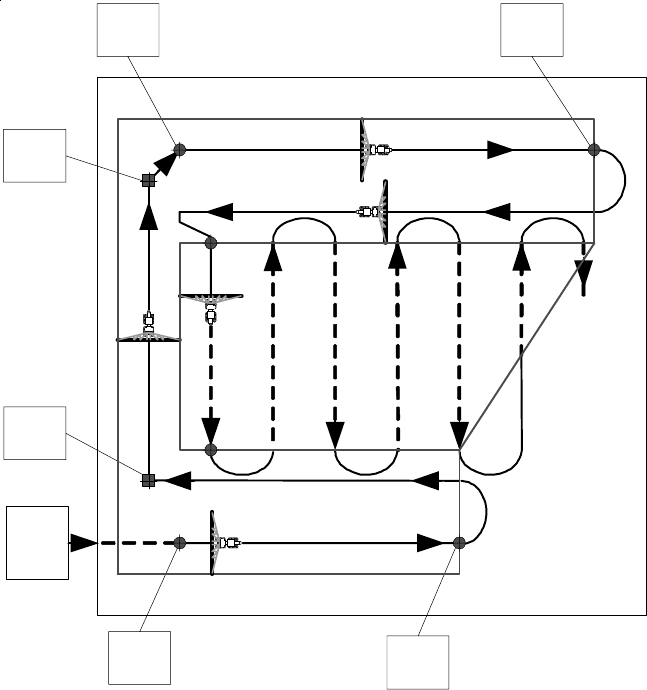
35
DH 3
mark DH 4
mark
DH 1
mark DH 2
mark
B
mark
A
mark
Enter
Field
Here
The Double Headlands C pattern provides parallel swathing between two straight double
headland areas. Using the C pattern, swathing progresses toward an “open” end, allowing the
last swath to easily align with the edge of the field. This pattern can be used with Swath Types
(SWA) Back and Forth (BF) or Snap-To-Swath (SNP) and uses the direction (DIR) control
AUT/MAN setting to determine the layout of the C pattern.
Three line segments define the Double Headlands C pattern (DHC): DH1-2, A-B, and DH3-
4. (see diagram on this page). The DH1-2 line defines the first Double Headland area. The A-
B line controls the orientation of all subsequent swaths between the headland areas. The
DH3-4 line defines the second Double Headland area. These three line segments may be at
any angle or orientation so long as the general shape of the letter “C” is formed. Guidance
along the inside of DH1-2 and DH3-4 includes ON/OFF indicators (similar to headland con-
trols) on the center top and bottom RGL 600 green LED’s. These indicators direct the opera-
tor to turn the applicator ON or OFF so that the headland swath, which is inside of DH1-2, can
be the same length and alignment as the DH1-2 line, if desired. The DH3-4 inside headland
swath is controlled similarly. The exact shape of the field will determine if and how these
indicators are used. Marking of the A-B line is independent of DH1 and DH3 marks, although
the A mark is close to DH1 and the B mark is close to DH3. This allows some flexibility in the
corners of the field along the A-B line. The A-B line should be marked carefully as it controls
the position and direction of all subsequent swaths between the headland areas. The area
covered by the Double Headlands C pattern and swathing is calculated and displayed at the
end of guidance along the DH3-4 inside headland.
Double Headlands C pattern

36
Once the Double Headlands C pattern is defined, the field is sprayed using parallel swathing.
BF or SNP swath types can be used as configured.
As the machine crosses headland boundaries in either direction, the center top and bottom
green LED indicate the presence and status of a headland boundary approach. The Head-
land Approach Display shows the distance to near headlands that are in front of the ma-
chine.
Note that the line between DH2 and DH4 might not be parallel to the A-B line. Applicator
ON/OFF signals and Headland Approach Displays are shown when swaths at the end of field
cross this boundary where there is no headland area.
The following steps outline Double Headlands C pattern swathing:
1. If HDL configuration is not already set to DHC, enter the Configuration Mode, go to
SWA main menu, HDL sub-menu, and set HDL to DHC. Exit the Configuration Mode.
2. Enter the field in the direction of the DH1-2 line segment. Determine the best position
and direction for the DH1-2 segment. This may be a fence line or field boundary in
many cases.
3. Clear any previous swath setting and press the MENU button until the RGL 600
display reads “SET...DH1”.
4. Press the SELECT button to set the DH1 mark. Drive along the intended DH1-2 line
segment with the applicator ON. The display will indicate “SET...DH2”. Press the
DOWN button for straight-line guidance as required. This is called a temp DH2.
5. At the end of the DH1-2 line, press the SELECT button and turn the applicator OFF.
The display will read “AUT...DIR” or “SET...DIR” depending on the direction config-
uration (DIR). Turn in the desired direction for the field layout.
6. For manual direction, press the SELECT button. For automatic direction, just drive in
the desired direction. The display will read “D12...offset” and the LED’s show guid-
ance along the inside of the DH1-2 line segment. Notice the top and bottom green
LED’s will go on when the machine passes the DH2 point.
7. Drive along the DH1-2 inside headland path. When the machine is aligned with the
end of the DH1 point, the center top and bottom LED’s will go OFF. When reaching
the position for the A mark, press the SELECT button and the display will read “SET...A”.
8. Turn and position the machine for the A mark. Press the SELECT button to set the A
mark. The display indicates “SET...B”. Press the DOWN button for straight-line
guidance as required. This is called a temp B mark.
9. Drive along the A-B line to the B reference point. Press the SELECT button to set the
B mark. This display indicates “SET...DH3”.
37
10. Position the machine for the desired beginnng of the DH3-4 line segment. This may be
a fence line or field boundary in many cases. Press the SELECT button to set the DH3
mark. This display will indicate “SET...DH4”. Press the DOWN button for straight-line
guidance as required. This is called a temp DH4.
11. At the end of the DH3-4 line, press the SELECT button and turn the applicator OFF.
This marks DH4. Turn toward the field and guidance is given for entering the field
along the DH3-4 inside headland area. Turn the applicator ON as required when
entering the field. Notice the top and bottom green LED’s will turn ON when the
machine passes the DH4 point.
12. Drive along the DH3-4 inside headland path. When the machine is aligned with the
end of the DH3-4 line, the center top and bottom LED’s will go OFF. This completes
the A-B line and headlands marking.
13. Press the SELECT button to calculate the acreage, and begin swath guidance along
the first swath parallel to the A-B line.
14. Press the MENU button to see the swath guidance screen.
(swath offset error is shown on the right)
15. Proceed with swathing and turn the applicator OFF and ON when turning between
swaths.
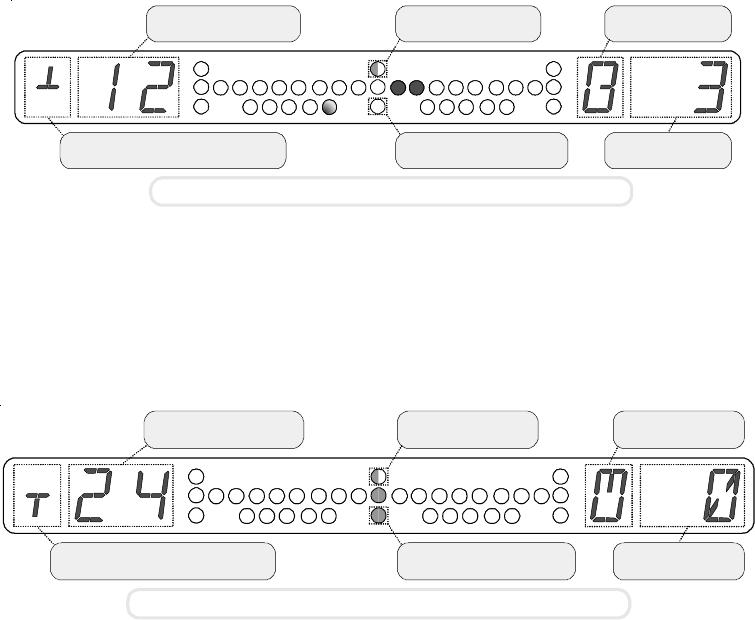
38
Headland Approach Display
The Headland Approach Display shows the distance to upcoming headland boundaries in-
stead of the swath number in the left alphanumeric display. A symbol is also displayed which
indicates entering or leaving the headland area. When the machine is in a headland ap-
proaching a boundary to the spray ON area, the approach display comes on one-quarter
swath width from the boundary. When the machine is in the field approaching a boundary to
the headlands, the approach display comes ON one swath width from the boundary.
See the configuration DSP-APR, which provides ON, FLA, or OFF Approach Display control
settings. The default setting is ON as described here. When DSP-APR is set to FLA, the
Headland Approach Display and Swath Number will show alternately (i.e. FLAsh). When
DSP-APR is set to OFF, the center top green LED still flashes to indicate an approaching
headland boundary.
When operator is leaving a headland area and approaching the parallel swath area, the center
top green LED will flash (center bottom green LED is OFF). The Headland Approach
Display shows the distance to the headland boundary, instead of the swath number. This
prompts the operator to prepare to turn the applicator ON. The center top and bottom green
LED’s will both go ON when the operator crosses the boundary into the parallel swath area.
When the operator is approaching an upcoming headland area, the center top green LED will
flash (center bottom green LED is ON). The Headland Approach Display shows the
distance to the headland boundary, instead of the swath number. This prompts the operator to
prepare to turn the applicator OFF. The center top and bottom green LED’s will both go OFF
when the operator crosses the boundary into the headland area.
current position is outside
spray area of field swath offset error
is 3 feet
target direction
is to the right
approaching
headland boundary
distance to headland
boundary is 12 feet
indicates approach to spray area
of field from a headland
Headland Approach to Spray ON Display
current position is inside
spray area of field swath offset error
is 0 feet
target direction is
straight ahead
approaching
headland boundary
distance to headland
boundary is 24 feet
indicates approach to headland
from inside the field
Headland Approach to Spray OFF Display
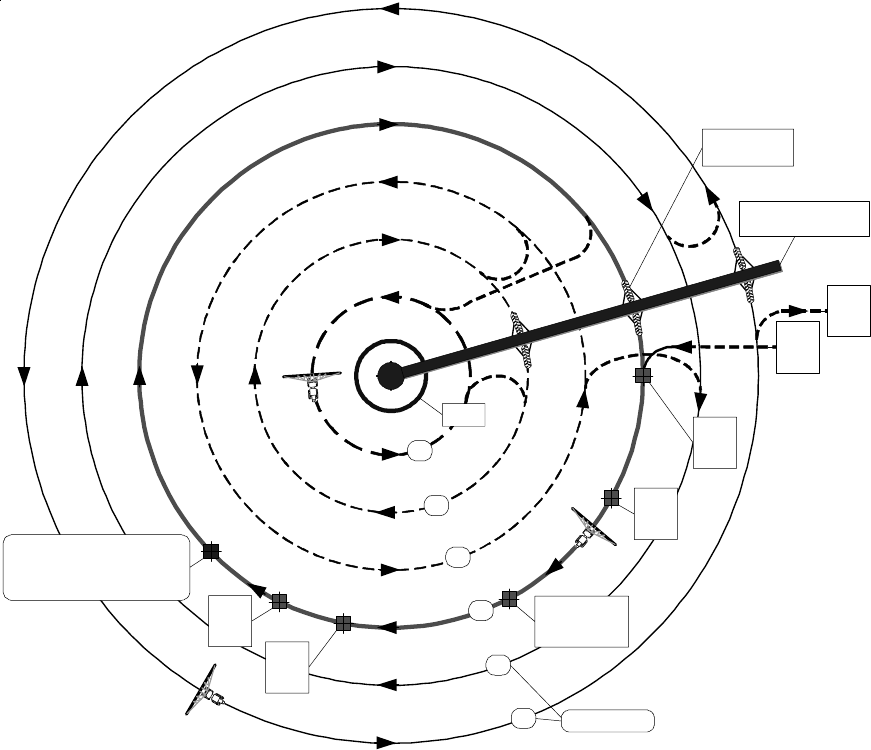
39
PIVOT SWATHING
The Pivot Pattern provides a circular swathing of fields that have a well-defined center and
are shaped like a circle or a section of a circle. The requirement for circular swathing usually
results from use of a pivot irrigation system.
There are two steps in using the Pivot Pattern:
1. Determine the center of the circular pattern.
2. Follow circular swath lines to cover the required area.
Once the center is determined, the Smarbar lays out swath numbers starting at number one
(closest to the center) and increasing outward from the center. To determine the center, the
operator marks points while driving any circular swath. These points mark the Pivot Refer-
ence Circle. The Pivot Minimum Radius (SWA-PMR) is a configuration distance used only
by the Pivot Pattern. The Pivot Reference Circle, the Swath Width (SWW), and PMR
determine the position of circular swath #1. Subsequent swaths are numbered outward from
swath #1 and are located at Swath Width intervals.
PVT
Mark
1
PVT
Mark
2
PVT
Mark 3
guidance begins
PVT
Mark
4
PVT
Mark
5
Enter
Field
Here
Guidance is OK.
DOWN button is pressed.
Pivot Reference Circle is complete.
Swath is #4
PMR
#1
#2
#3
#4
#5
#6 Swath Numbers
Exit
Field
Here
Pivot Irrigation
tower tires
Pivot Irrigation boom
in parked position
40
The Pivot Minimum Radius setting defines a circular area at center of the field. Circular
swaths are assigned outside of this area. As the radius of circular swaths become smaller
and smaller, the inside spray nozzle moves slower than the outside spray nozzle. The PMR
setting determines the smallest circle to be sprayed. The PMR setting may also be used to
define an unplanted area at the center of the field that is used for installed equipment or
storage.
Use a known circular path to setup the Pivot Reference Circle. An example is the tire tracks
previously made by one of the pivot irrigation towers. After three points are marked, the
operator is shown guidance to the best circle, which is calculated from points marked on the
Pivot Reference Circle. The operator continues marking points while comparing this circular
guidance to the reference path being followed. When guidance indications match the refer-
ence path, the operator pushes the DOWN button to accept the current Pivot Reference
Circle. At this time, the resultant circular swath number is displayed along with circular
guidance. The operator finishes the initial swath and then traverses the field in any order
similar to the Snap-To-Swath procedure in parallel swathing. Care should be taken not to
re-spray the swath number that is the Pivot Reference Circle. Note the swath coverage
sequence shown on the diagram on the previous page.
Pivot Pattern Configuration
To use the Pivot Pattern, enter the Configuration Mode and navigate to the Swath
(SWA) menu. Set the Swath Type (SWT) to PVT. Set the Pivot Minimum Radius
(PMR) to the length from the center of the field to a point on a circle where circular
swathing may begin. Set the Swath Width (SWW) to the dimension across each
swath. The Swath Direction Control (DIR) is not used for the Pivot Pattern. Set the
Offset Guidance Scale (SCL) and Angle display (ANG) as for parallel swathing to
control guidance indication displays. The Headlands Type (HDL) is not used for the
Pivot Pattern swathing. Set Along Track antenna Offset (ATO) and Across Track
Antenna Offset (XTO) as for parallel swathing.
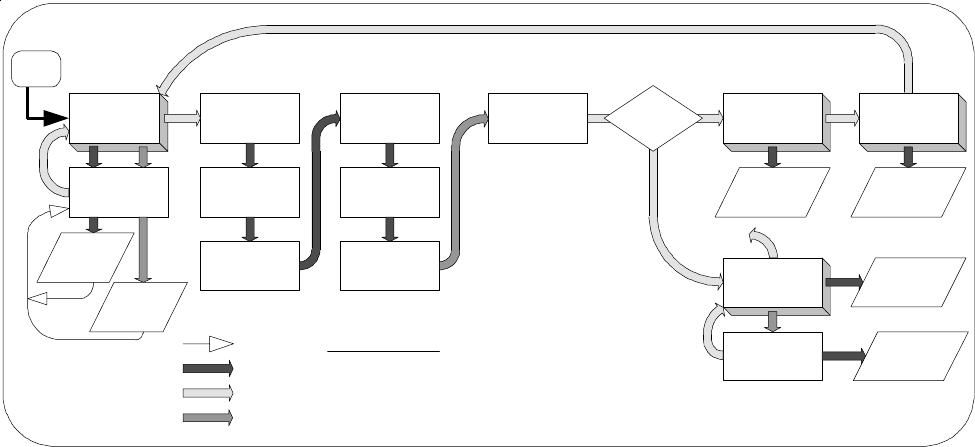
41
Marking the Pivot Reference Circle
When the Smartbar is configured for Pivot Pattern and the Pivot Pattern has been cleared,
press the MENU button until the left alphanumeric display reads “P1” and the right display is
blank. This display prompts the operator to mark the first point on the Pivot Reference Circle.
While driving the Pivot Reference Circle, mark the first point by pressing the SELECT button.
The display will initially indicate “P2 0”, prompting for the second point. While marking
points on the Pivot Reference Circle, the right display indicates difference, in degrees, be-
tween the current Course Over Ground (COG) and the previous point’s COG. As you drive
around the Pivot Reference Circle away from the P1 mark, the right display will increase your
COG changes. Continue around the Pivot Reference Circle and mark P3. When three points
are marked, the Smartbar can calculate a center and radius for the Pivot Reference Circle.
After P3 is marked, the Smartbar offset LED’s and angle LED’s will display guidance indica-
tions as you drive around the Pivot Reference Circle. Each time a new point is marked, the
Smartbar recalculates the center and radius of the Pivot Reference Circle. Continue marking
points while driving around the Pivot Reference Circle. There must be at least 17 feet (5
meters) distance and 12o change in COG between each pivot reference point. When the
guidance indicators match the path you are driving, the center and radius have been accu-
rately determined. Press the DOWN button to complete the Pivot Reference Circle marking
phase.
After the Pivot Reference Circle is marked, the Smartbar determines the location of circular
swath #1 and the swath number of the Pivot Reference Circle. After the DOWN button was
pressed to complete the Pivot Reference Circle marking, the left display shows the swath
number and the right display shows offset error as in parallel swathing.
When marking Pivot Reference Circle points, the operator should press the SELECT button
when the machine is as close as possible to the circumference line being followed. Pivot
Reference Circle accuracy is determined by the accuracy of marking these points.
PVTCLRPOSSAV
RGL
600
Operational Mode
Pivot Pattern
Navigation Diagram
BRT
Decrease
Brightness
Increase
Brightness
Power
ON
NO
circular guidance
Swath Number
& Offset distance
15
17
P1 P4
P5
P6 5
no
guidance guidance to current
Reference Circle
3 0
31P3
14P2
Swath #
Clear
Pivot
Save
Position
Position
is Saved?
YES
CLR SAV Clear
Saved Position
Clear
ALL
CLR ALL
press MENU Button
press DOWN Button
press SELECT Button
Automatic (no button press)

42
Driving the Pivot Pattern
No button presses are necessary after the Pivot Reference Circle is marked. Use the same
technique as Snap-To-Swath for parallel swathing, except each swath is part of a circle. As
the operator drives the field, the Smartbar will always give guidance indication to the closest
swath.
Refer to the pivot pattern diagram at the front of this section. The swath order used to cover
this example pivot pattern is #4 (Pivot Reference Circle), #1, #2, #5, and #6. The Pivot
Reference Circle may be any swath number and the swath order can be chosen to best suite
the particular field and equipment.
Offset and angle indicators are much like they are for parallel swathing. When using the pivot
pattern, a new location on the current circular swath is continously calculated. Offset error
indicates distance from the target circumference. Angle error indicates variance from a line
tangent to the circular swath at the current position.
Saving and Returning to a Position
Refer to the section Saving Your Present Position. When Pivot Pattern is in use, Saving and
Returning to a Position is very similar to parallel swathing. Imagine a line tangent to the
circular swath at the time the Save Position is done. When returning to that saved position,
this tangent line is treated as a parallel swathing pattern swath line.

43
ROW SWATHING
Use Row Swathing when you are driving in plowed rows and must follow the rows precisely.
The SELECT button is pressed at the end of each row to advance to the next row. For Row
Swathing, the Smartbar continuously memorizes the track just behind the current position.
When the SELECT button is pressed at the end of a row, guidance is given to the swath in
either direction to the next row. Since the offset distance to the next row is calculated from the
position at the end of the current row, guidance into the next row will be very accurate. It is
important to configure the swath width setting to closely match the required multiple of the
distance between each row. It may be necessary to configure SYS-UTS to FTF (see System
Configuration, UTS Feet, Feet Fine, or Metric Units). This will allow the swath width to be set
in tenths of feet.
As rows are laid out across a field, small incremental inconsistencies in the pitch (distance
between each row) may exist. This can cause a swath position calculated from an A-B line
reference to misalign with rows that are several swaths away from the A-B line. When using
Row Swathing, each swath position is based on the previous swath position and direction.
This produces a precise guidance into each new row, which can minimize the time required to
turn from one swath to another.
The primary purpose of Row Swathing is to aid in locating the target row when turning. Row
Swathing does not require the rows to be straight. As the operator is driving along each
swath, guidance is given toward a straight path based on the path just behind the current
position. The operator will be using the row as a primary path. Smartbar guidance will aid in
following these row patterns.
Note: When using Row Swathing, Swath numbers shown in the left display are swath
sequence numbers and do not necessarily represent a position on the field.
Configuration Steps for Row Swathing
To use Row Swathing, enter the Configuration Mode and navigate to the Swath (SWA) menu.
Set the Swath Type (SWT) to ROW. Set the Swath Width (SWW) to the dimension across
each swath. The Swath Direction Control (DIR) is not used for Row Swathing. Set the Offset
Guidance Scale (SCL) and Angle display (ANG) as for parallel swathing to control guidance
indication displays. The Headlands Type (HDL) is not used for the Row Swathing. Set Along
Track antenna Offset (ATO) and Across Track Antenna Offset (XTO) as for parallel swathing.
SAV POS
RGL
600 BEG ROW
Menu Navigation Diagram for Row Swathing
Save
Position
Clear
ROW
Clear
Saved
Position
CLR ALL
CLR ROW
Clear
All
CLR SAV
press MENU Button
press DOWN Button
press SELECT Button
Automatic (no button press)
Top and Bottom
Center Green LED’s
are ON
1 offset
error 2 offset
error 2 offset
error
if a Position
is Saved
next swath
Top and Bottom
Center Green LED’s
are ON
Top and Bottom
Center Green LED’s
are OFF
aligned w/prev
end of swath

44
CONTOUR SWATHING
Some fields require Contour Swathing for application of fertilizer, chemicals, or other agricul-
tural maintenance. If a field has contoured terraces, Contour Swathing may be required for
swathing to follow the contour of the terraces. Some fields may have an irregular shape,
which requires Contour Swathing for reasonable coverage.
When Contour Swathing is used, each swath (except the first) is based on the previous swath.
This allows any irregularities in one swath to be accounted for in the next swath. For example,
the operator may have to drive around a tree or ground feature in the field. Guidance for the
next swath will follow the path taken by the operator when driving around the tree or ground
feature. Contour Swathing can be referred to as ‘relative’ swathing. This is because each
swath is ‘relative’ to the previous swath. Other parallel swathing can be referred to as
‘absolute’ swathing. This is because each swath is an ‘absolute’ distance (swath number
multiplied times the swath width) from the A-B reference line.
To provide Contour Swathing guidance, the Smartbar memorizes each swath path as the
operator is driving. To simplify the progress through the field, each memorized swath is
separate from the other swaths. See the Contour Swathing Diagram below. Swath #1 starts
at the ‘1A’ mark and ends at the ‘1B’ mark. Swath #2 starts at the ‘2A’ mark and ends at the
‘2B’ mark, etc. The Smartbar memorizes the path of the two complete swaths. While driving
the first swath, the Smartbar memorizes the path of that swath. While driving the second
swath, the Smartbar shows relative guidance to the first swath while memorizing the second
swath. While driving the third swath, guidance to the second swath is shown while memoriz-
ing the third swath. This process is repeated across the field.
1
Enter
Field
Here
Exit
Field
Here
2A
3A
4A
5A
2B
3B
4B
5B
1B
1A
Contour Swathing Diagram
45
Contour Control Configuration Setting
To mark the beginning of the first swath (1A), press the SELECT button at the BEG...CON
screen. See the Menu Navigation Diagram for Contour Swathing in this section. To mark
the end of the first swath (1B), press the DOWN button. This will be done just prior to turning
toward the second swath. You may turn either direction (i.e. left or right) toward the second
swath. After making the turn, press the SELECT button to mark the beginning of the second
swath (2A). Follow the guidance indicators to complete the second swath. Press the DOWN
button to mark the end of the second swath (2B). Repeat this process for the third swath, etc
across the field. This method of marking the beginning and end points of the second and
successive swaths is the default Contour Control (DSP-CON) and is called the two-button
(2BT) mode. Two button presses are required when turning at the end of each row. Two
additional Contour Control settings (1BT and 0BT) minimize and/or eliminate operator button
press activities at the end of rows.
When the Contour Control is set to the one-button mode (DSP-CON=1BT), only one button
press is required at the end of each row. At the end of each row, the operator presses the
DOWN button to mark the end of that swath. Then, make the end-of-row turn to the next
swath. When the machine is aligned with the previous swath end mark (position of DOWN
button press) and one swath width away, the beginning of the next swath is automatically
marked. If the field shape is such that the next swath should begin before alignment to the
end of the previous swath, the operator can press the SELECT button to mark the next swath’s
beginning early.
When the Contour Control is set to the zero-button mode (DSP-CON=0BT), no button presses
are required at the end of rows. Automatic marking of swath beginnings is the same as in the
one-button mode. The zero-button mode automatically marks the end of each swath after the
first swath. When the machine is aligned with the previous swath begin mark and one swath
width away, the end swath is automatically marked. If the field shape is such that the end of
swath should be marked before alignment to the beginning of the previous swath, the opera-
tor can press the DOWN button to mark the end swath mark early. To use the zero-button
mode the beginning and end of swaths should generally align with the beginning and end of
the first swath.
Contour Type Configuration Setting
There are four settings for the Contour Type configuration:
NRM - Normal
FIN - Fine
VFN - Very Fine
CRS - Course
The Contour Type controls how the Smartbar memorizes swath paths. Normal (NRM) is the
default and should be used for nearly all applications. As the Contour Type is set to finer
settings, the length available for each swath decreases. Swath length maximum distances for
each Contour Type are shown below:
NRM - 3 miles
FIN - 1.5 miles
VFN - 0.5 miles
CRS - 4 miles
46
Configuration Steps for Contour Swathing
To use Contour Swathing, enter the Configuration Mode and navigate to the Swath (SWA)
menu. Set the Swath Type (SWT) to CON. Set the Contour type (CON) to Normal (NRM),
Fine (FIN), Very Fine (VFN), or Course (CRS). Set the Swath Width (SWW) to the dimension
across each swath. The Swath Direction Control (DIR) is not used for Contour Swathing. Set
the Offset Guidance Scale (SCL) and Angle display (ANG) as for parallel swathing to control
guidance indication displays. The Headlands Type (HDL) is not used for the Contour Swath-
ing. Set Along Track antenna Offset (ATO) and Across Track Antenna Offset (XTO) as for
parallel swathing.
Contour Control (DSP-CON) is set to two-button (2BT) by default. To use one-button (1BT)
or no button (0BT) Contour Control, first navigate to the System (SYS) configuration main-
menu. Set SYS-DSP to Configure (CFG)). This will activate the Display Settings (DSP)
configuration main-menu. Go to the Contour Control (DSP-CON) sub-menu and select 2BT,
1BT, or 0BT.
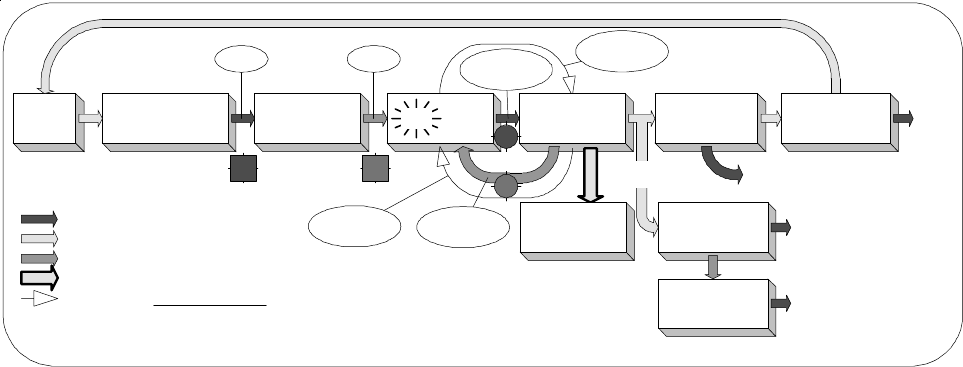
47
Using Contour Swathing
1. Set the Swath Type (SWT) to CON. Set the Contour type (CON) to NRM, FIN, VFN,
or CRS. (Normal, Fine, Very Fine, or Course) These settings control the fineness of
contour recording. For NRM, swaths up to 3 miles in length can be recorded. For FIN,
swaths up to 1.5 miles in length can be recorded. For VFN, swaths up to 0.5 miles in
length can be recorded. For CRS, swaths up to 4 miles in length can be recorded.
The VFN setting is mostly for testing. The NRM setting is used in most agriculture
swathing applications.
2. Contour Operational Mode starts with BEG...CON. Press the SELECT button to start
the first swath and drive as required. The left display will show 1 and the right display
will show 0%, 1%, etc to 100% indicating the percent of available contour swath memory
remaining. For NRM setting, this will indicate 100% at about 3 miles.
3. At the end of the first swath, press the DOWN button. Recording will stop and guid-
ance will be given in either the right or left direction while turning to the second swath
path. While making this turn, note the swath number is flashing. This indicates the
path is not being recorded and is a prompt to press the SELECT button to begin re-
cording swath 2.
4. After the turn, press the SELECT button at the front of swath 2 and follow guidance
indicated that is one swath width away from swath one. During this time, the swath 2
pattern is being recorded and stored. The right display shows offset error as for paral-
lel swathing. Press and hold the MENU button to see the percent of available contour
storage on the right display.
5. At the end of contour swath 2, press the DOWN button to end that swath. While
making this turn, note the swath number is flashing. This indicates the path is not
being recorded and is a prompt to press the SELECT button to begin recording the
next swath. Repeat steps 4-5 for each swath to complete the field.
Note: Step 4 is optional if Contour Control is configured to the one-button mode.
Step 4 and step 5 are optional if Contour Control is configured to the zero-button mode.
SAV POS
RGL
600 BEG CON
Menu Navigation Diagram for Contour Swathing
Save
Position
Clear
CON
Clear
Saved
Position
CLR ALL
1 10% CLR CON
2 offset
error
2 offset
error
Clear
All
CLR SAV
if a Position
is Saved
press MENU Button
press DOWN Button
press SELECT Button
press & hold MENU Button
Automatic (no button press)
2 14%
begin
swath #1 end
swath #1 SELECT Button
to begin
swath #2 . . .
Align w/prev
start to begin
swath #2 . . .
Align w/prev
end to end
swath #2 . . .
DOWN Button
to end
swath #2 . . .
2A
1B1A 2B
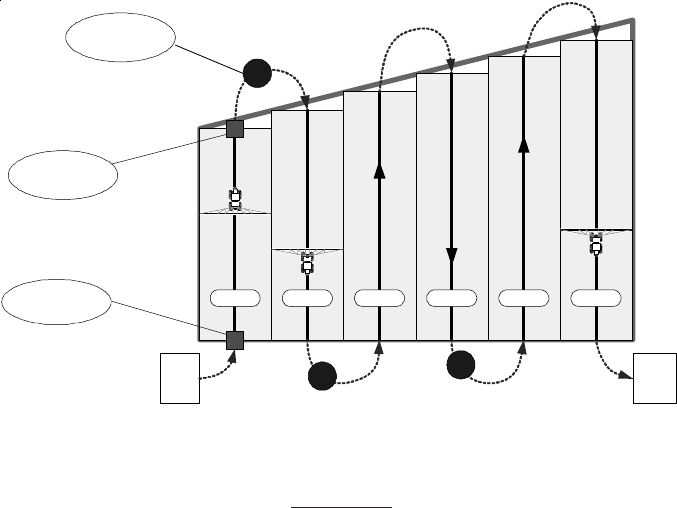
48
SEED SWATHING (SED)
Seed swathing (SED) is used, as the name imples, for seeding purposes using swaths that
are parallel to the A-B line.
SED swathing is much like BF except that whenever the Select button is pressed to advance
to the next swath, an “auto swath calibrate” occurs. This makes the entry into the next swath
very accurate for close alignment of the wheels to the next row. The operator must be trained
to press the SELECT button at the best point to setup for the next row. The operator must be
sure to press the SELECT button before he starts to make his turn.
Below are the steps required for SED swathing.
SED - Basic Operation
The straight line defined by marks A and B must be parallel to the remaining swaths.
Make sure the GPS antenna has a good view of the sky and the Smartbar shows NO
alarm conditions.
If DIR is set to Automatic (AUT), the Direction is set automatically when the machine
turns past 75o alignment to the A-B line. If DIR is set to Manual (MAN), press the
SELECT button (after marking B and turning) to set the direction.
The SELECT button is then used to advance to the next swath.
Important
The ‘A’ and ‘B’ marks form a straight line that must be parallel to the remaining
swath paths. Ensure that no alarms are present while setting the ‘A’ and ‘B’ marks.
B
A
Enter
Field
Here
Exit
Field
Here
Swath #1 Swath #2 Swath #3 Swath #4 Swath #5 Swath #6
press SET B button to
Mark the
B point
press SET A button
to Mark the
A point
SEL
SEL
SEL
If DIR=MAN
press SELECT button
to set direction
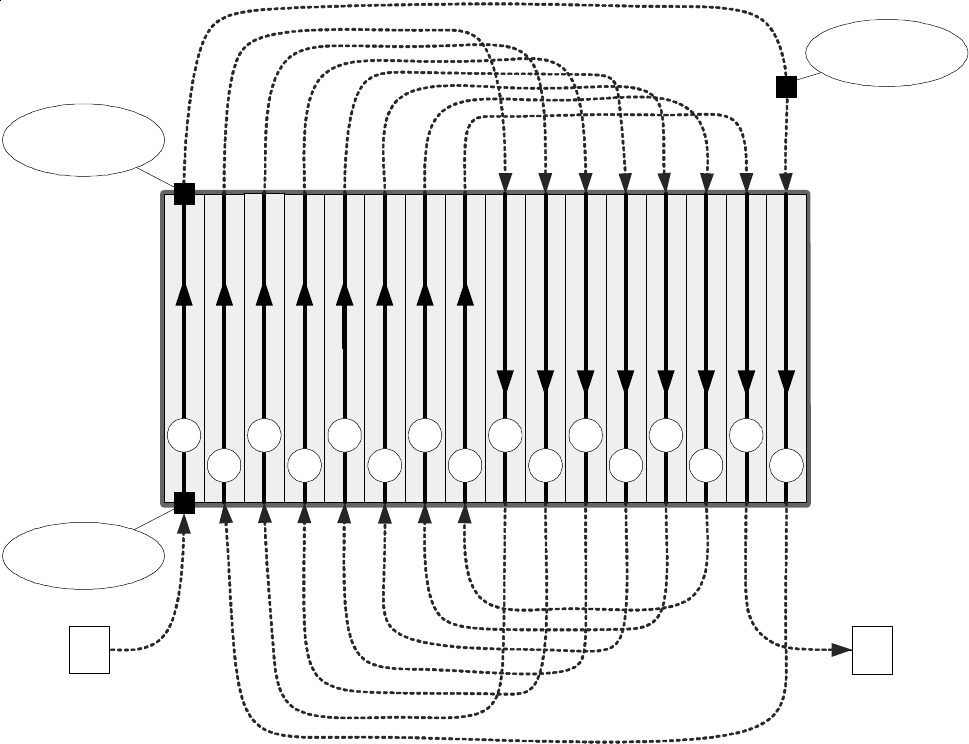
49
RACETRACK SWATHING
Racetrack Swathing is a special swath pattern used by aviators when crop dusting.
B
A
Enter
Field
Here
Exit
Field
Here
press SELECT button
to Mark the
B point
press SELECT button
to Mark the
A point
Swath
#1
Swath
#2
Swath
#3
Swath
#4
Swath
#5
Swath
#6
Swath
#7
Swath
#8
Swath
#9
Swath
#10
Swath
#11
Swath
#12
Swath
#13
Swath
#14
Swath
#15
Swath
#16
C
press SELECT button
to Mark the
C point
Steps used to cover a field using the Racetrack Swathing pattern:
1. Mark A and B points by pressing the SELECT button while spraying the first
swath.
2. Go to the last swath of the field and Mark C by pressing the SELECT button.
3. Press the SELECT button when exiting the field for each swath to get guidance
to the next swath.
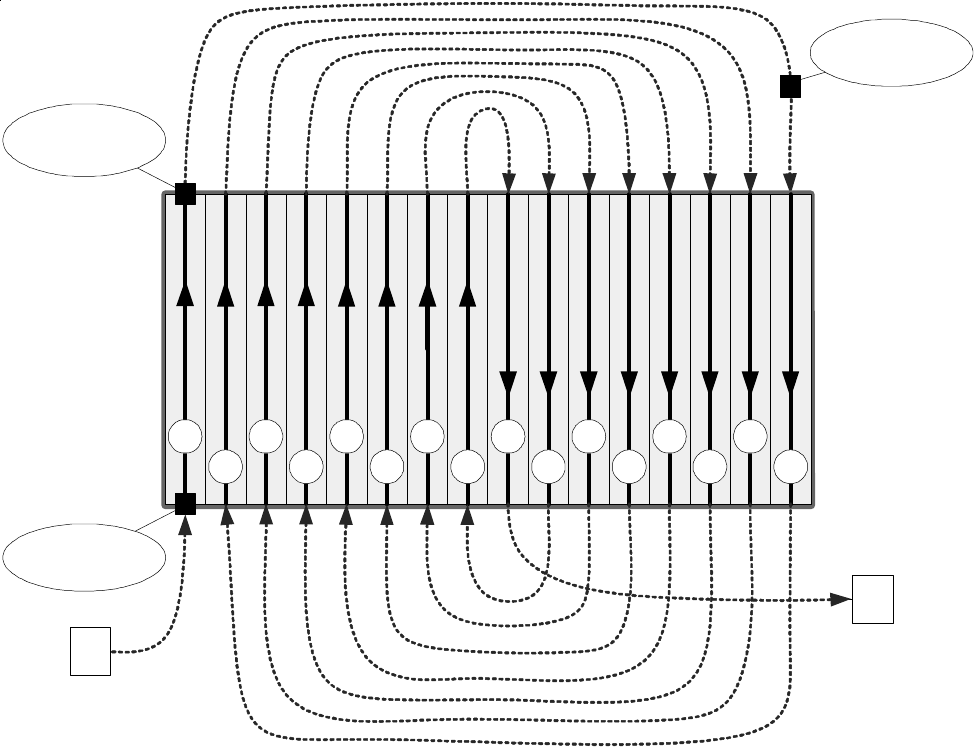
50
B
A
Enter
Field
Here
Exit
Field
Here
press SELECT button
to Mark the
B point
press SELECT button
to Mark the
A point
Swath
#1
Swath
#2
Swath
#3
Swath
#4
Swath
#5
Swath
#6
Swath
#7
Swath
#8
Swath
#9
Swath
#10
Swath
#11
Swath
#12
Swath
#13
Swath
#14
Swath
#15
Swath
#16
C
press SELECT button
to Mark the
C point
SQUEEZE SWATHING
Squeeze Swathing is a special swath pattern used by aviators when crop dusting.
Steps used to cover a field using the Squeeze Swathing pattern:
1. Mark A and B points by pressing the SELECT button while spraying the first
swath.
2. Go to the last swath of the field and Mark C by pressing the SELECT button.
3. Press the SELECT button when exiting the field for each swath to get guidance
to the next swath.
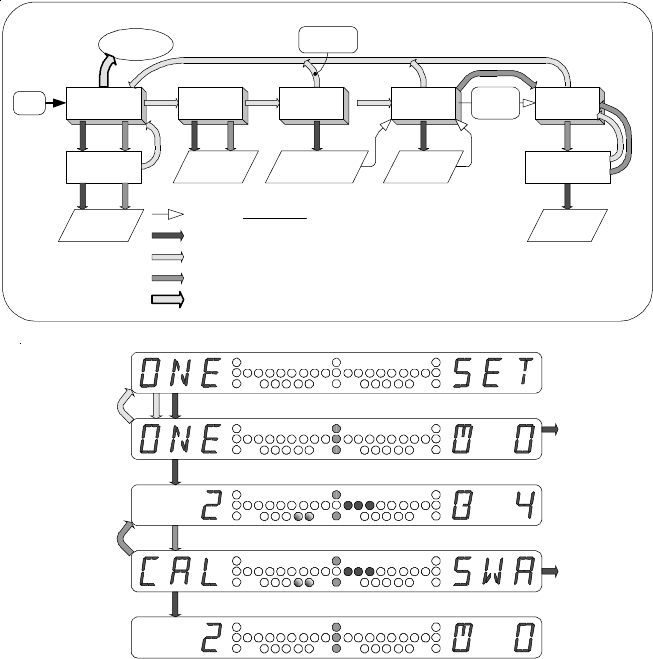
51
ONE BUTTON SWATHING (ONE)
One Step - Basic Operation
A new Swath Type is added, which is SWT-ONE.
One Step operation is basically the same as Snap-To-Swath operation, without the need to set
point A and B.
Main Screen
One Step
Swath
Navigation
Swath number is
Displayed
If offset errors ar
e
showing press
SELECT
to reset end Mark
SELECT
to Calibrate
Swath Line
Press DOWN to Swath Calibration
Press SELECT to Calibrate Swath
Reset End Mark / Turn towards Swath #2 and continue snap-to-swath.
Press SELECT to Set start - End Mark (Swath #1 in guidance mode).
Operational Steps:
1. While moving in the direction of the reference swath, press the SELECT button at the
“ONE SET” menu. This sets the Start mark to the current position and the End mark
ahead by four swath widths in the direction of the present COG (Course Over Ground).
Guidance and offset indicators are shown immediately with “ONE” showing in the left
alphanumeric display.
2. Continue driving the reference swath. If offset erros are showing, press the SELECT
button to reset the End mark.
3. At the end of the reference swath, turn toward the second swath and continue Snap-
To-Swath. The swath number now shows in the left alphanumeric display.
4. To calibrate the reference swath position, press the DOWN button. The promp “CAL
SWA” will be shown immediately. To calibrate the reference swath, press the SELECT
button. To abort, press the MENU or DOWN button.
press MENU Button
press DOWN Button
press SELECT Button
press and hold MENU Button
Automatic (no button press)
ONE off
set
enter
Configuration
Mode
RGL 600
One Step - Basic Operational Mode
Menu Navigation Diagram
BRT
Power
ON SET ASWW
Set
Brightness
Snap to Nearest swath #
off
set
swath
#
Complete
turn toward
Swath #2
Set
Swath Width
only if initial
Swath Navigation
has not been set
Set the A mark Reset
End Mark CAL SWA
Calibrate
Swath Line
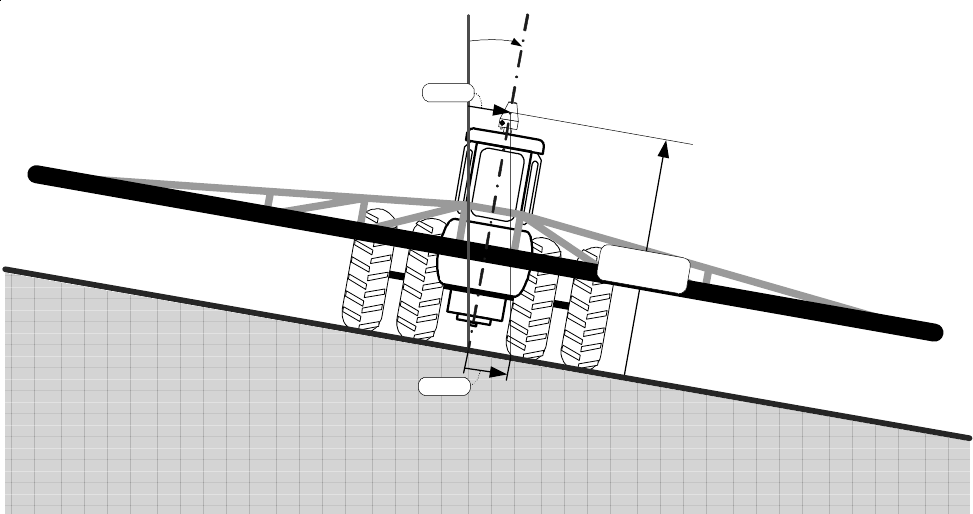
52
SMARTBAR TILT UPGRADE OPTION
The Smartbar Tilt Upgrade Option provides straight parallel swath guidance on fields that
are not level. This option corrects position errors that occur when an applicator machine
moves over an uneven field.
For accurate DGPS signal reception, the GPS antenna is usually placed on the highest part
of the applicator machine. This may be on top of the operator’s cab. The antenna height may
be from about 8 feet to about 20 feet. If the surface of the field is not level, this antenna
position and the center of the applicator boom are not in the same place. The difference be-
tween the antenna’s position and the center of the boom is tilt error (see diagram on this
page). If a field’s surface along a swath line is not uniformly at the same tilt angle, swath paths
created by following the DGPS position will not be straight. If the field’s surface between
adjacent swath’s is not at the same tilt angle, the swath patterns created by following the
DGPS will leave gaps or overlap.
The Smartbar Tilt Upgrade Option measures the machine tilt using a solid state inclino-
meter. Once the machine’s tilt is determined, the “error” can be calculated and corrected.
This tilt correction provides for straight parallel swathing on fields that are not level.
As a machine moves along a swath path, various bumps in the field and the machine’s
vibration can cause erroneous inclinometer tilt readings. The Smartbar filters these tilt read-
ings to eliminate most of these errors. During the Smartbar IAS (Inertial Augmentation
System) configuration, the user can adjust this filter for very rough fields with only gradual
changes in slope or very smooth fields with abrupt changes in slope.
Antenna
Height
Tilt
Angle
STA
RLINK
Error
Error
Tilt Sensor Upgrade Option Installation
The Tilt Sensor Upgrade Option is installed into a new or existing Smartbar at the factory by
adding the Tilt Sensor (inclinometer). A Smartbar, with the Tilt Sensor Upgrade installed, can
use Smartbar firmware updates to the IAS as they become available.
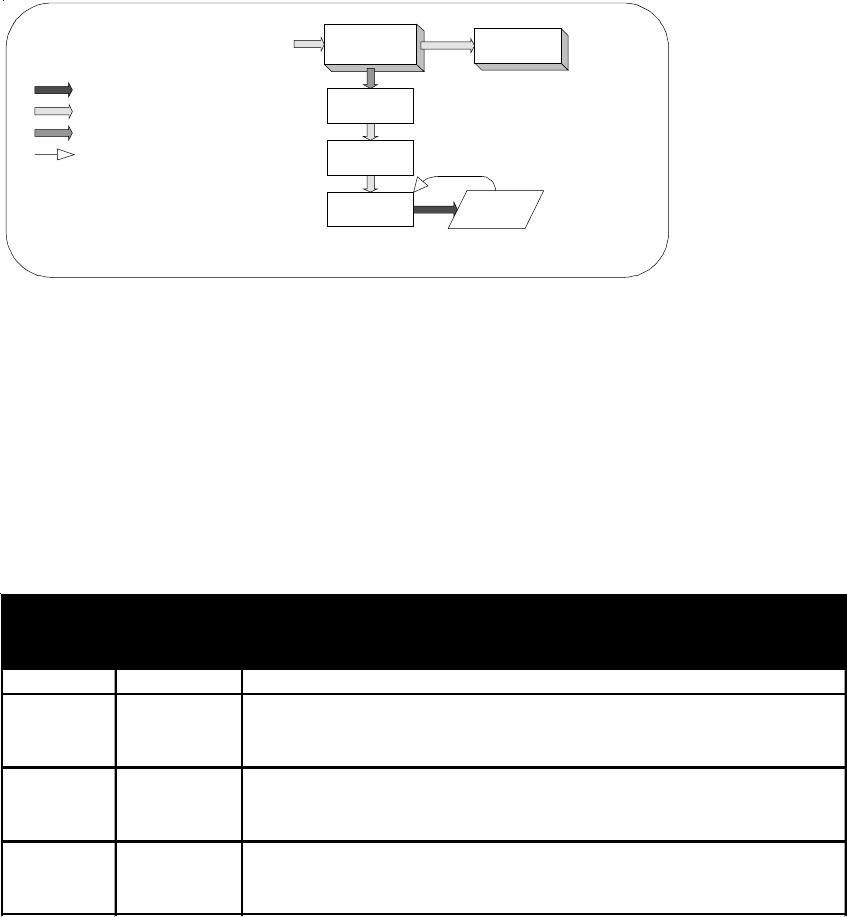
53
IAS Configuration
When a Smartbar has a Tilt Sensor Upgrade Option installed, a new top level config-
uration menu (IAS) is added just prior to the DIA top level configuration menu. Press
the DOWN button at the IAS top level menu to enter the IAS configuration sub-menus.
IAS configuration sub-menus are used to setup the tilt correction calculation para-
meters and to calibrate the tilt sensor:
TLT - Tilt Control Mode
Press SELECT button to select between Tilt Control Modes:
DIA
Diagnostics
IAS
Inertial
Augmentation System
AHT
Antenna Height
ANG
Angle - degrees
Calibrate
Tilt Sensor
1.0-40.0 feet
0.10-9.99 meters
degrees indication
-179 to 0 to 180
left level right
OFF, SLO, NRM, FST, or VFS
TLT
Tilt Mode
Inertial Augmentation System Configuration Menu
press MENU Button
press DOWN Button
press SELECT Button
Automatic (no button press)
Tilt
Control
Mode
Description Function
OFF
Off Smartbar tilt sensors have no effect on swath guidance
SLO Slow
The tilt angle filter has the greatest effect. The effective tilt angle
will change slowly. This mode is used for rough fields with
gradually changing slopes.
NRM Normal
The tilt angle filter will have a medium effect. The effective tilt angle
will change normally. This setting is usually used for the tilt control
mode.
FST Fast The tilt angle filter has only a small effect. The effective tilt angle
will change fast. This mode is used for smooth fields with rapidly
changing slopes.

54
AHT - Antenna Height
The GPS antenna height is entered and displayed. This is an important part of the tilt
error correction. It must match the measurement between the antenna mounted on
the applicator machine to the ground.
The setting range is 1.0 feet to 40.0 feet or 0.10m to 9.99m.
Press the SELECT button to increase the Antenna Height by 1.0 feet or by 0.10 meter.
Press the DOWN button to decrease the Antenna Height by 0.1 feet or by 0.01 meter.
ANG - Tilt Angle Readout and Calibration
The measure tilt angle is displayed as -179 degrees (tilted to the left) to 180 degrees
(tilted to the right). 0 degrees is displayed when level. The tilt sensors must be cali-
brated after installation any time the Smartbar firmware is updated.
To calibrate the tilt sensors:
1. Stop the applicator machine on known level ground.
2. Press the SELECT button to calibrate the tilt sensors.
3. ANG display will read approximately 0 degrees.
Note:
The ANG display will indicate inclination for all angles. However, tilt correction
calculations are limited to +20o.
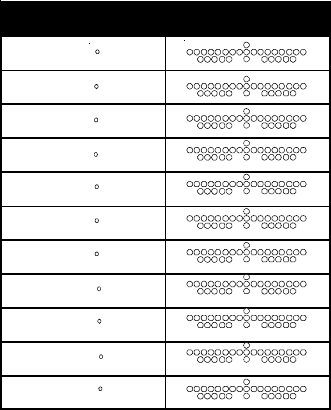
55
SWATH CALIBRATION
The Swath Calibration feature is an aid for very accurate swathing requirements. The DGPS
Receiver accuracy is high for short periods of time. When long time intervals occur during
swathing, small across track position drifts can be corrected using Swath Calibration. The
machine operator must be able to determine the precise corrected position of the current
swath line and position the machine to that point. Swath Calibration will adjust the AB line
reference and all successive swaths to this adjusted point. Swath Calibration is limited to 1/4
the current swath width setting. From the Swath Navigation screen, press and hold the MENU
button for approximately 3 seconds. When the [CAL...SWA] screen shows, the MENU button
may be released. Press the SELECT button to calibrate the swath line to the current position
or press the MENU button to return to the Swath Navigation screen without changing the
swath calibration.
The swath calibration limit may be turned off. In the SYS configuration menu, set DSP to CFG
then in the DSP configuration menu, set DSP-LSC to OFF. When LSC-ON, the Swath Calibra-
tion is limited to 1/4 of the current swath width setting. When LSC-Off, the Swath Calibration
limit is bypassed.
SPECIAL OFFSET AND ANGLE DISPLAYS
Special offset and angle LED display patterns indicate that the Smartbar is nearly perpendicu-
lar to swath line. This display pattern will usually be seen only when turning from one swath to
another or when leaving and returning from a ‘Saved Position’.
See the diagram “An Ideal Turn” on page 57 for an illustration of how the angle LED’s indicate
swath alignment between 70o and 110o (20o on either side of 90o, which is perpendicular).
Notice the angle LED’s are all on (either left or right) from about 15o to about 70o. As the
swath angle increases toward perpendicular, an additional angle LED will come for each 5o
until all angle LED’s are ON at 90o. As the swath angle continues to increase, beyond 90o,
an angle LED will go off for each 5o until all angle LED’s on the original side are off. As the
angle changes toward swath alignment, LED’s will begin to go off at about 15o (referenced to
the next swath line) and will all be off when alignment to the next swath is reached.
Angle LED display patterns between 70o and 110o are shown in the following table.
Machine Alignment
with Swath Line Special Angle LED
Display Pattern
65
70
75
80
85
90
95
100
105
110
115
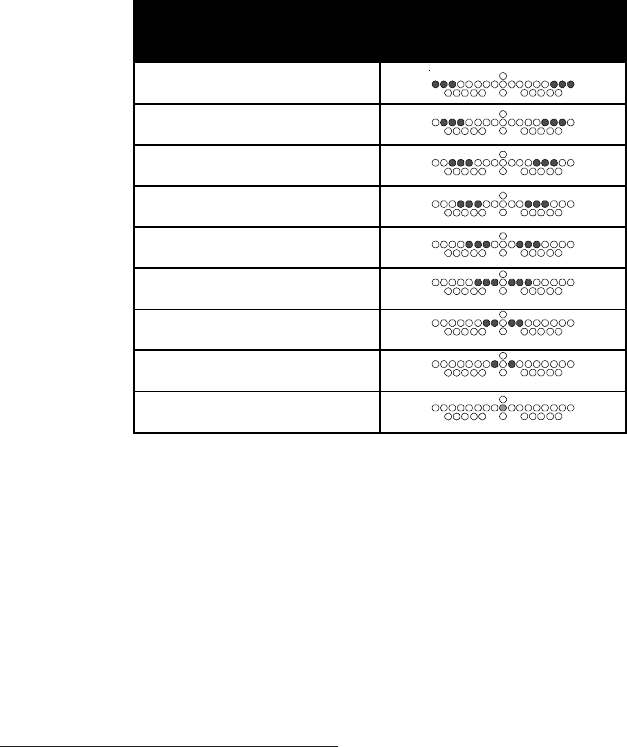
56
Within this same nearly perpendicular angular alignment, the offset LED’s are displayed using
a special pattern. This pattern indicates the distance from (or to) the selected swath line.
Since the machine alignment is perpendicular to the swath line, this distance is an along track
distance indication. The offset LED’s usually indicate across track distance. The along track
display pattern is different from the across track display to prevent confusion. Along track
distance intervals for this special offset display pattern are percentages of the swath width
(SWW) as shown in the table below.
During turn maneuvers at the end of each swath, the machine operator can use these special
angle and offset distance displays to determine the approximate location and orientation of
the previous and/or next swath line. This aids in smoothly setting up for alignment at the
beginning the new swath.
When returning from a ‘Saved Position’ and driving down the side of the field, two elements of
the along track offset pattern will begin to move toward each other, one half of the swath width
distance away from the return swath line. This aids in locating the entrance line back into the
field.
The Special Offset and Angle Display may be turned OFF. In the SYS Configuration Menu,
set DSP to CFG (i.e. Light Bar Display options can be configured). Then in the DSP Config-
uration Menu, set SPL to OFF.
Along Track
Offset distance
% of Swath Width
Special Offset
Display Pattern
50%
45%
40%
30%
20%
10%
5%
2%
0%
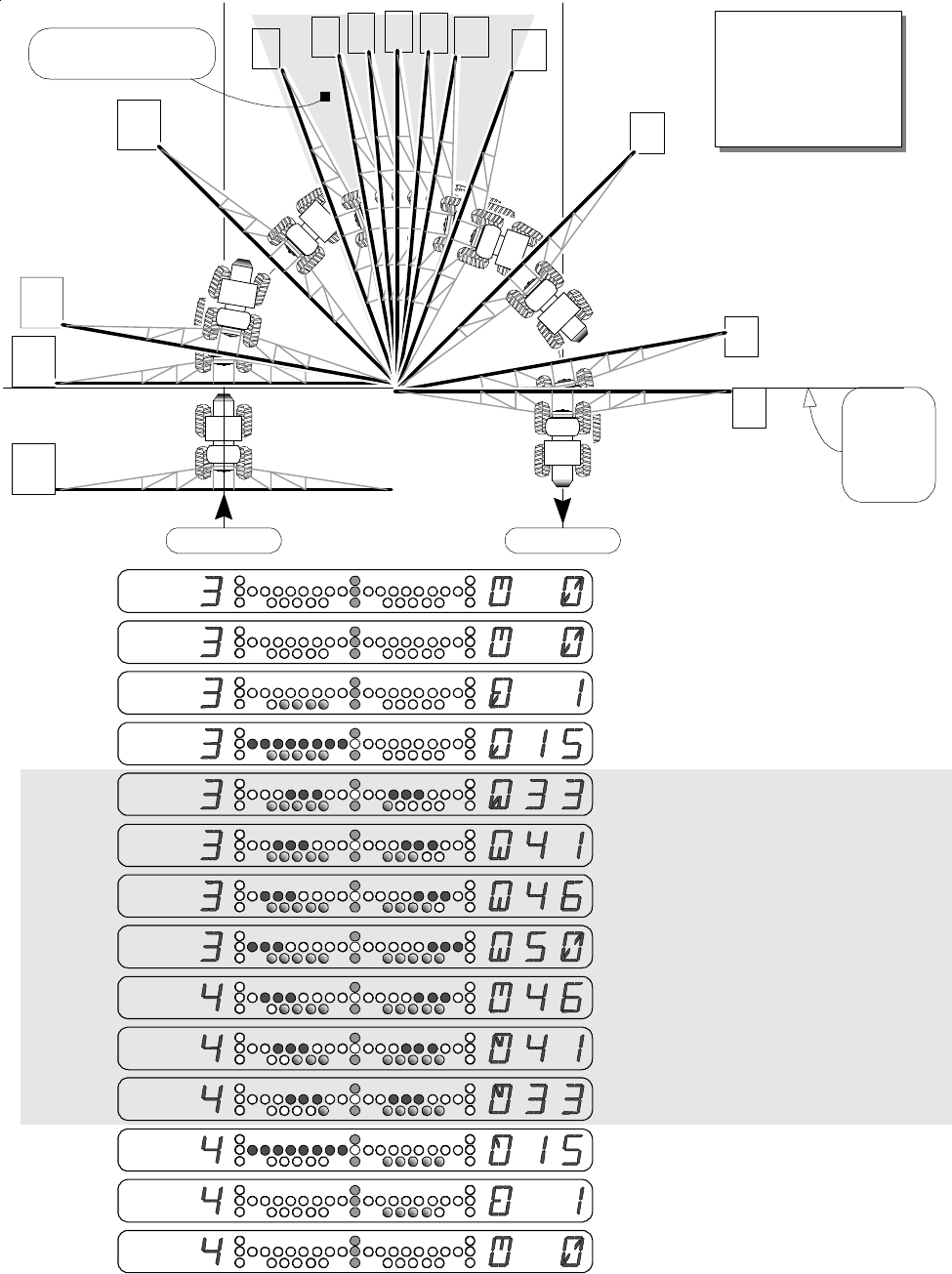
57
Approaching end of Swath #3,
prepare to turn off spray nozzles
Edge
of field
spray
area
#4
45°
#3
10°
#2
0°
#1
0°
#9
95°
#6
80°
#7
85° #8
90° #10
100°
#12
135°
#13
170°
#14
180°
Swath #4Swath #3
#4 - 45°
#3 - 10°
#2 - 0°
#1 - 0°
Turn off spray nozzles, begin turning right
Angle LED's show 10° angle to Swath #3
#5
70° #11
110°
Special Display
Region
#9 - 95°
#6 - 80°
#7 - 85°
#8 - 90°
#10 - 100°
Past half way to Swath #4, SNP switches to
Swath #4.
#5 - 70°
#12 - 135°
#13 - 170°
#14 - 180°
Angle LED's show 10° angle to swath #4,
prepare to turn spray nozzles On.
Turn spray nozzles On and continue on
straight line of swath #4.
#11 - 110°
Entering Special Display Area
Leaving Special Display Area
An Ideal Turn
UTS = FT
SWT = SNP
SWW = 100ft
SCL = NRM
Angle LED's show perpendicular to Swath #3
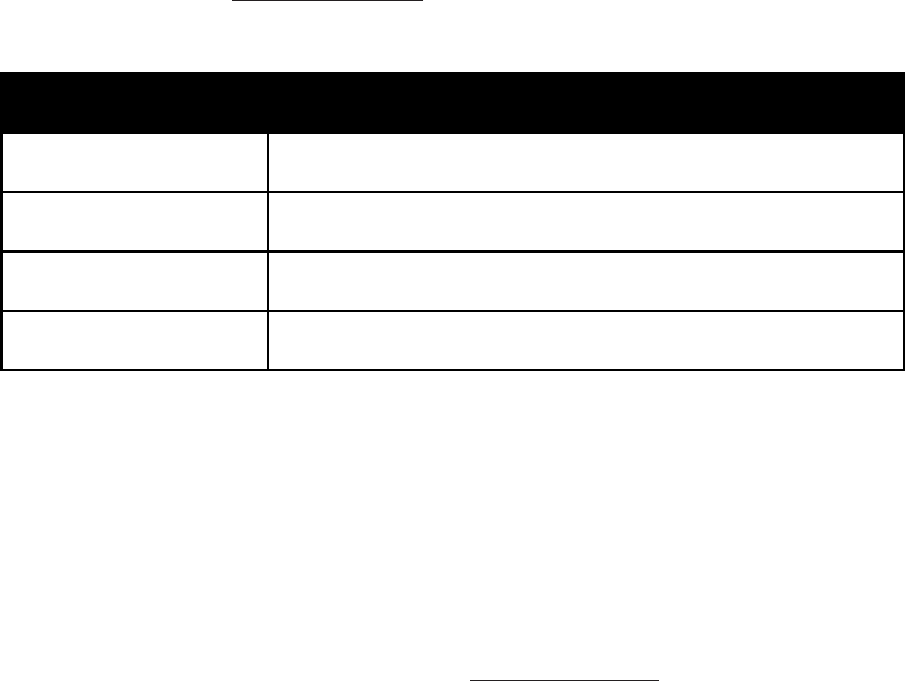
58
ALARMS
System performance can be adversely affected under certain operating conditions. Loss of
differential signal and/or poor satellite geometry can cause the accuracy of the system to fall
below that required for precision guidance. Should conditions exist which cause the accuracy
to lessen, the user is notified with one of three possible alarm conditions; GPS, Accuracy, or
Differential GPS. These alarms; G, A, D, are displayed on the far right side of the DGPS
Status Display Screen (Configuration Mode - GPS). All other screens display these alarm
conditions as yellow LED’s along the far end of both sides of the Smartbar (refer to diagram
items B and F on page 4). Alarms are represented as follows:
Alarm Description
[G] GPS Alarm All 3 LED's on each side. Less than 4 satellites or receive
r
mode less than D3X.
[A] Accuracy Alarm Bottom 2 LED's on each side. HDOP greater than 2.0.
[D] Differential Alarm Bottom LED on each side. Age of Data greater than 120.
No Alarms No LED's on each side
[GPS] The system is not operating in three-dimensional Differential GPS mode. At
least four (4) usable satellites, five (5) or more is preferable, must be commun-
icating with the receiver along with a valid correction signal in order to operate
in 3-dimensional DGPS mode.
[Accuracy] The Horizontal Dilution of Precision (HDOP) is greater than two (2.0). HDOP is
a fancy term for approximating the error in your position solution caused by
poor satellite geometry. Simply stated, it usually means that you do not have
enough satellites in view (should have a minimum of 5) or the antenna’s view of
the sky is partially blocked. You can see the number of staellites being used by
going to the DGPS status screen (Configuration Mode) and pressing the DOWN
button.
[Differential] The age of satellite differential correction data has exceeded 120 seconds.
Your GPS receiver is not receiving the correction signal. It may be tuned to the
wrong frequency, the service provider may be out of range or unavailable or
there may be some electrical noise interfering with the signal.
The system should not be used when alarms are present. Many times the alarm conditions
are only temporary and will clear up by themselves. Should alarm conditions remain, refer to
the Troubleshooting section in this manual and the User’s Manual supplied with your GPS
receiver.
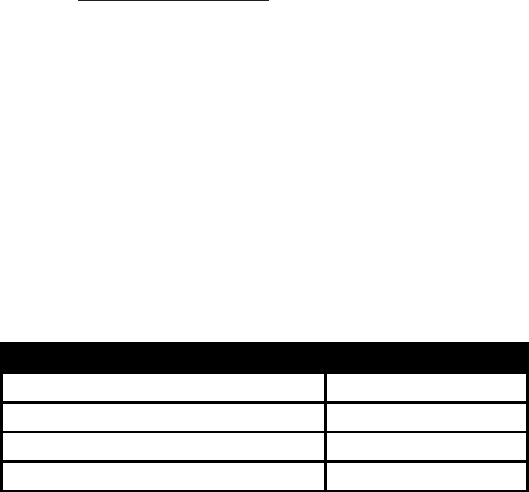
59
GPS RECEIVER / SMARTBAR COMMUNICATIONS
The Smartbar receives communication messages from the GPS receiver. Using the BPS
screen (Configuration Mode - SYS), you can select a BAUD rate for communicating with the
GPS receiver and monitor certain data communication and message conditions:
If the top center green LED is on or flashing, but the middle-center and bottom-center green
LED’s are off, data is being received from the GPS receiver, but is not at the same BAUD rate
as the GPS receiver. You can set the Baud rate to AUT, and the Smartbar will automatically
match its BAUD rate to that of the GPS receiver. Alternatively, you can select the specific
BAUD rate that matches that of the GPS receiver.
The bottom yellow LED’s will sequence when the BAUD rate selection is AUT and the Smart-
bar is trying to match its BAUD rate with that of the GPS receiver. The bottom yellow LED’s
will stop sequencing when a BAUD rate match is found. The number of yellow LED’s on for
each side indicates teh BAUD rate:
If all center green LED’s are on, but the left red LED’s are not sequencing, you are receiving
messages at the correct BAUD rate, but they are not the correct messages. You need both
$GPGGA and $GPVTG messages, or the single $GPRMC message.
If the left red LED’s are sequencing, then $GPGGA messages are being received. The
$GPGGA message contains position and GPS status information.
If the right red LED’s are sequencing, then $GPVTG messages are being received. The
$GPVTG message contains course and speed information.
If the Smartbar is receiving $GPRMC messages, the left and right LED’s will sequence. The
$GPRMC message contains position, GPS status, course, and speed information.
Note: The 3 center green LED’s are used to diagnose communication problems (especially
during installation). The top green LED monitors the receive-data signal directly. It will
come on momentarily whenever there is any activity on the receive-data signal. The
middle green LED indicates a properly formatted message has been received. The
bottom green LED indicates multiple properly formatted messages are being received.
The top green LED will flash when the GPS position solution rate is less than 5 hertz.
This is not an error condition. If using a Raven receiver, the RGL 600 may be used
to auto configure the receiver. In the SYS configuration menu, set GPS to INV.
The default setting is GEN (Generic). When SYS-GPS is set to INV, and MENU
button is pressed, ‘INV-SEL-TO-INI.’ will appear. Pressing the SELECT button will
automatically set up the port of the invicta receiver that the RGL 600 is connected.
Baud rate will be set at 19200, GGA-ON at 10 Hz, VTG-ON at 10 Hz.
Yellow LED's on each side BAUD rate
1 4800
2 9600
3 19200
4 38400

60
CARE AND CLEANING
The Smartbar is designed for all-weather outdoor operation. You can clean the dirt off of the
Smartbar by spraying it with a garden hose.
IMPORTANT: DO NOT USE PRESSURIZED WATER TO CLEAN THE SMARTBAR.
TROUBLESHOOTING
No Power
Ensure the Smarbar power cable is securely fastened and wired properly in your
vehicle.
No GPS Position
1. The Smartbar interface cables should be securely fastened and connected to
the correct port on your GPS receiver.
2. In order to operate properly, the Smartbar must receive two messages from the
DGPS receiver. These are National Marine Electronics Association (NMEA)
messages known as $GPGGA (GPS Fix Data) and $GPVTG (Course Over
Ground and Speed), or $GPRMC (Recommended Minimum Specific GNSS
Data). GNSS is an acronym for Global Navigation Satellite System.
3. Ensure the BAUD rate is configured to match the output BAUD rate of your
DGPS receiver. You can set the BAUD rate to AUT, which causes the Smartbar
to automatically synchronize its BAUD rate with the BAUD rate of the GPS
receiver.
4. If using a Raven receiver, the RGL 600 may be used to auto configure the
receiver. In the SYS configuration menu, set GPS to INV.
Erratic Swathing Patterns
Make sure the straight line formed by the ‘A’ and ‘B’ marks is parallel to your desired
swath paths. Ensure that no alarms are present while establishing the ‘A’ and ‘B’
marks.
GPS Alarm
Determine if the alarm is the result of loss of differential signal or a low number of
satellites. Go to the GPS Receiver Position Status screen. This is the second sub-
menu under the Configuration Mode GPS main menu (see page 12 and 13). Normally,
the GPS receiver is in 3D differential mode, and the left side of the screen displays
D3X. If you’ve lost differential, no “D” will be present on the far-left side of the screen.
If the alarm is due to a low number of satellites, the number on the far left side will be
4 or less. If this is the case, trees, buildings, or some other obstruction is blocking your
antenna.
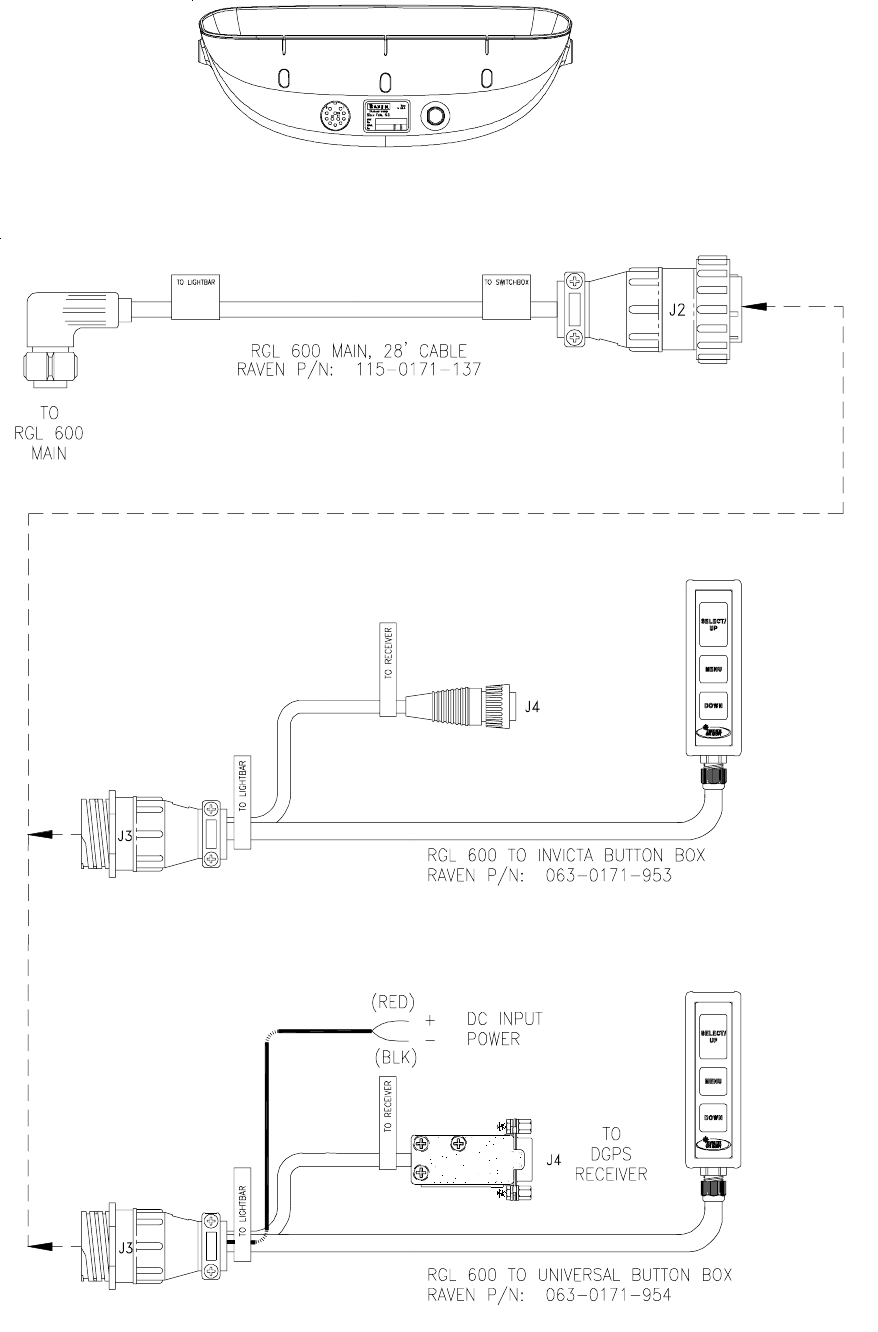
61
RGL 600 MAIN UNIT CONNECTOR
CABLE OPTIONS
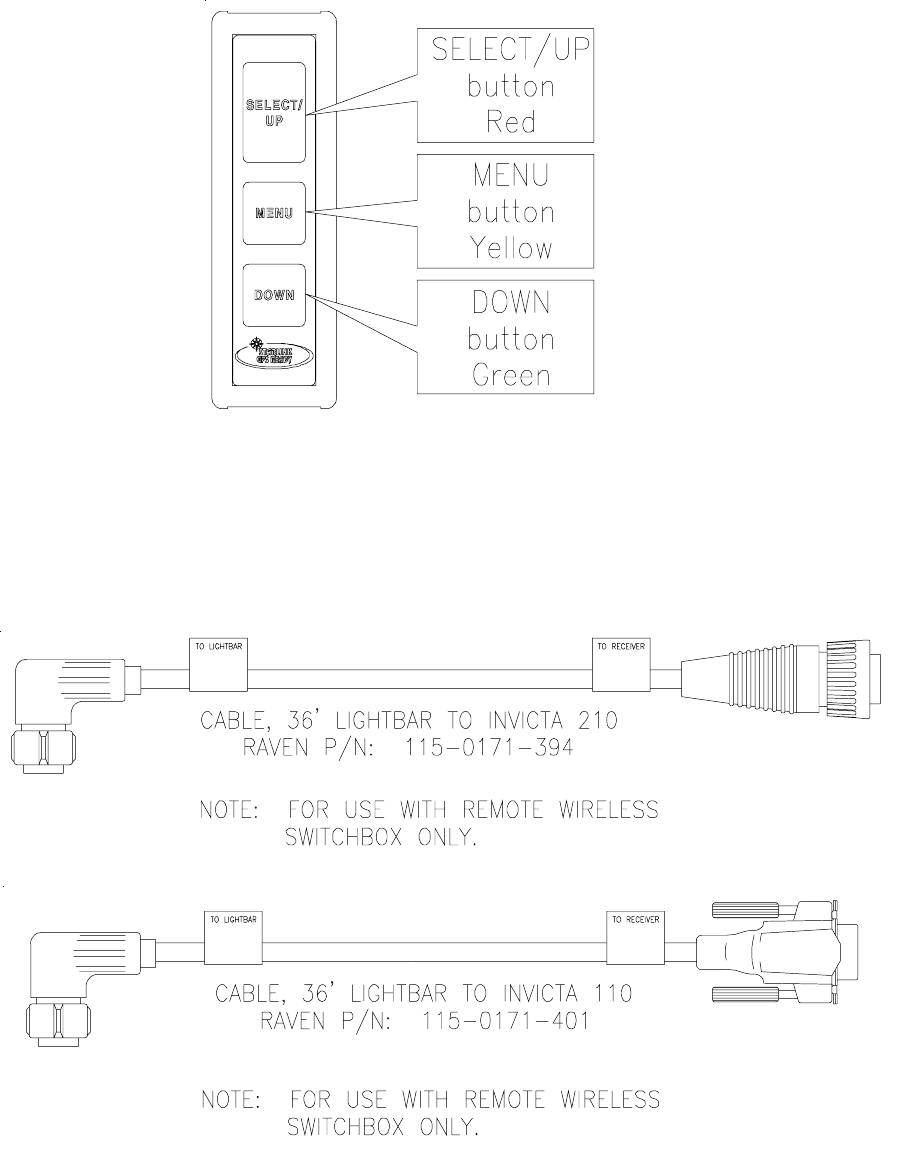
62
CABLE OPTIONS (continued)
WIRELESS SMARTBAR BUTTON BOX
In addition to the standard Smartbar Button Box, the RGL 600 also has an optional wireless button
box. The look, feel and functionality of this button box is identical to the wired version (refer to page
5 of this manual), however, no additional cables are necessary for operation.
This product has been tested to comply with FCC Standards. The EUT has been evaluated and found
compliant with the requirements as set forth in CFR 47 sections 15.203, 15.205, 15.209, and 15.231.
NOTICE: Any changes or modifications not expressly approved by Raven Industries would
voil authority to operate this device.
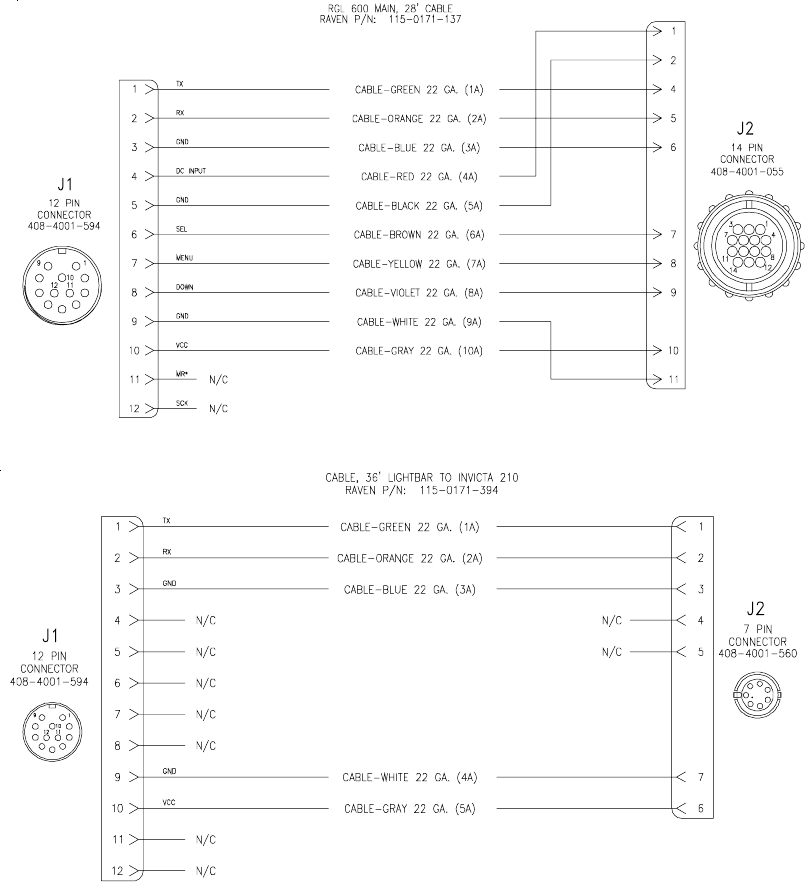
63
CABLE WIRING DIAGRAMS
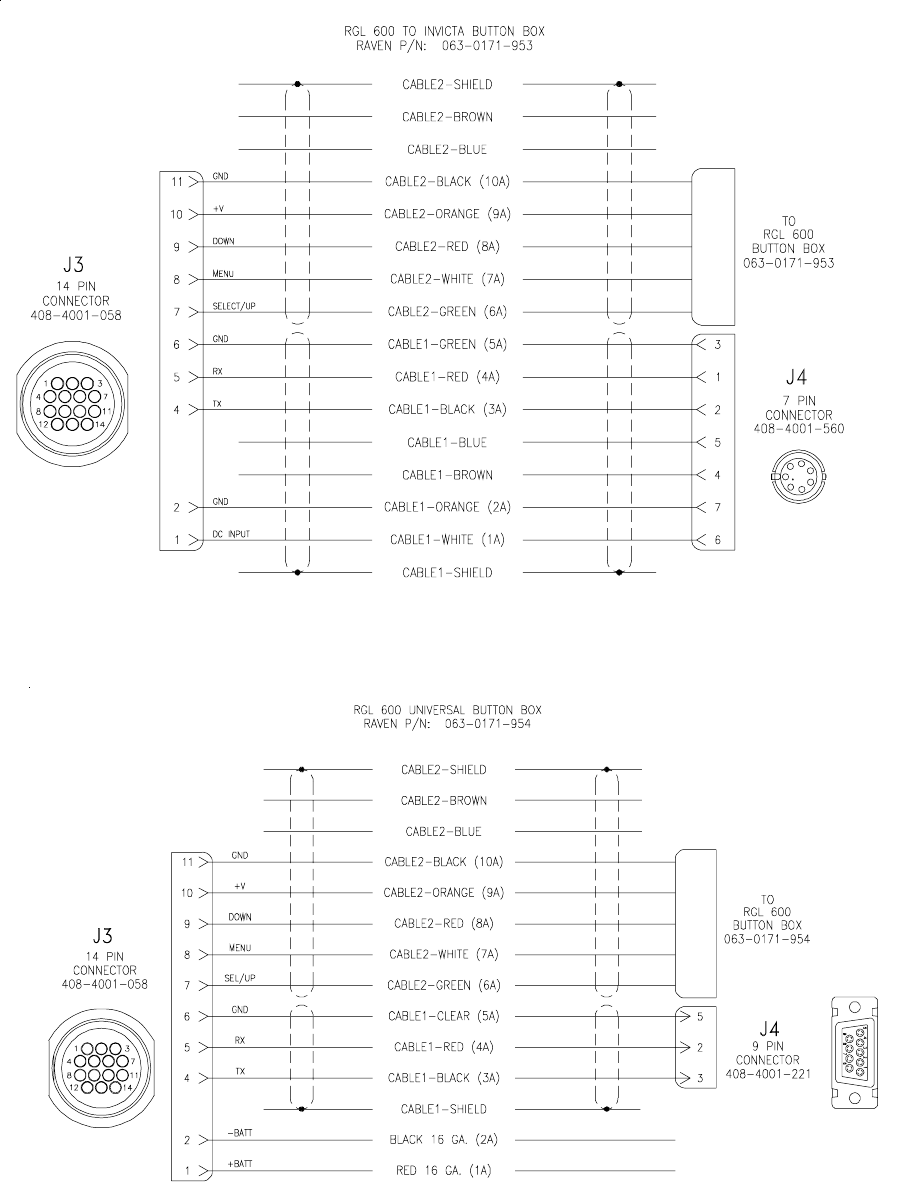
64
CABLE WIRING DIAGRAMS (continued)
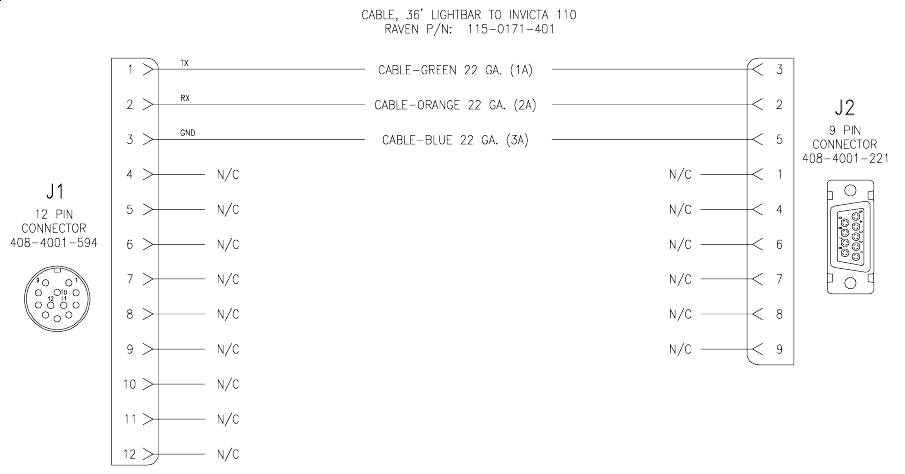
65
CABLE WIRING DIAGRAMS (continued)
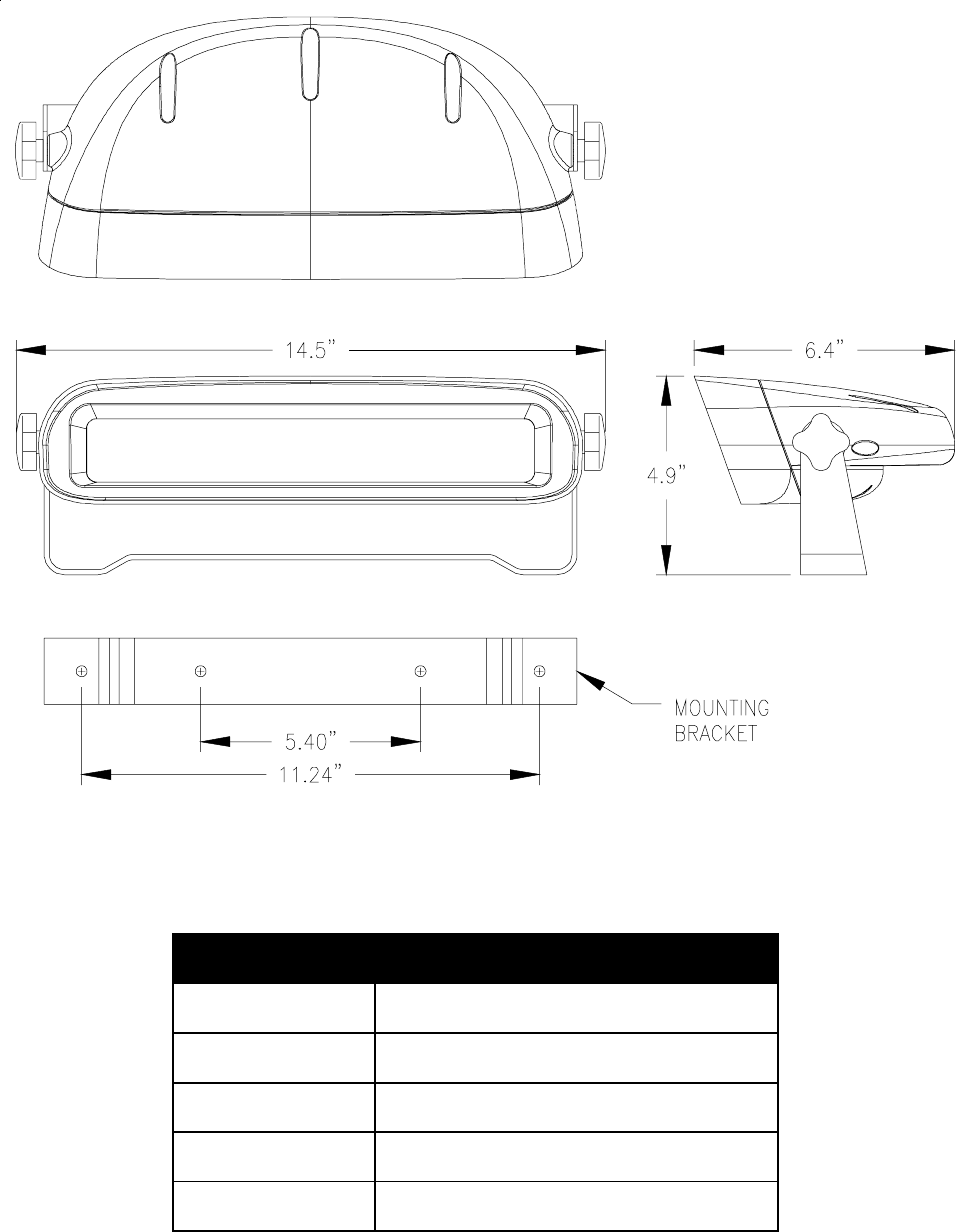
66
SMARTBAR SPECIFICATIONS
Specification Description
Voltage 10-32 VDC
Current 650 milli-amps at max brightness,
100 milli-amps at min brightness, 12 VDC
Weight 4.5 lbs.
Environmental -40 degrees to +70 degrees C
Humidity 95% non-condensing
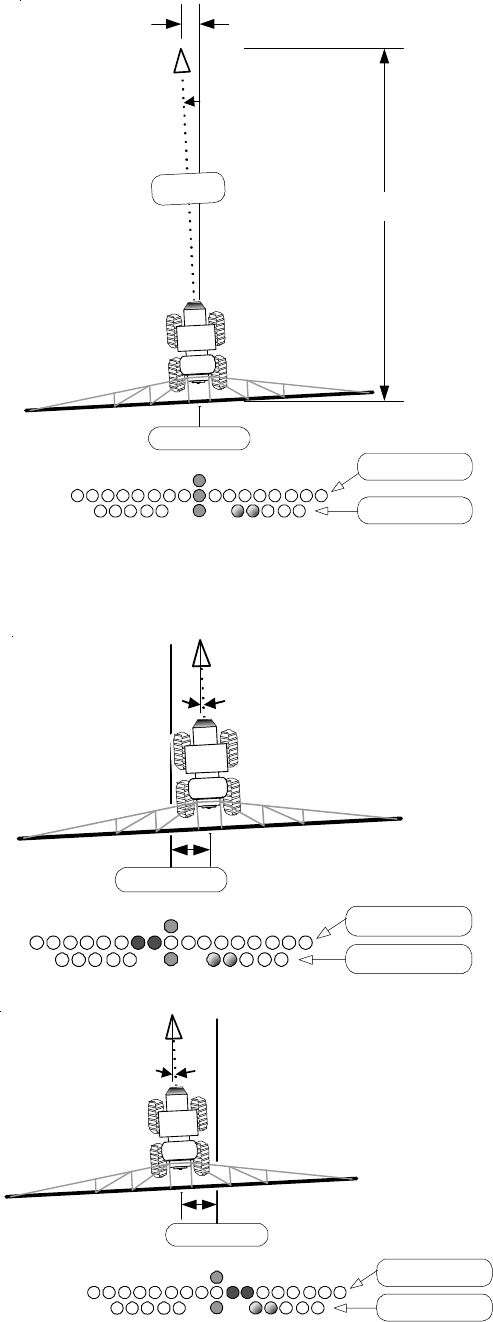
67
APPENDIX A - DRIVING YOUR MACHINE USING THE SMARTBAR
There are many different driving techniques and
various conditions encountered when following
parallel swath lines to cover a field. No single
technique or method is likely to be suitable for all
conditions. The Smartbar’s guidance display
gives the operator indications to help follow the
swath line accurately. The operator can see both
offset and angle LED indicators.
In the diagram shown to the left, the machine is
exactly on swath (i.e. no offset error), but is mov-
ing along a line which points 3o left of the swath
line being followed. The Smartbar is configured
with SCL set to NRM (first LED is 1 ft) and ANG
set to ON (first LED is 1o). If the offset LED’s
alone were used for guidance, the machine must
move 20 feet forward from the position shown
before an offset LED guidance indication is given.
By using both the offset and angle LED’s, the
operator knows that the machine is on swath and
needs to turn gradually to the right. Two angle LED’s showing on the right side indicate a 3o correc-
tion is needed to the right. Using this method, an operator can drive a very straight line that has
minimal offset error from the swath line.
In the diagram shown to the left, the machine is
2 feet right of the swath line and has the same
angle alignment as previously. The two offset
LED’s on the left are telling the operator to drive
to the left. The two angle LED’s to the right are
telling the operator to turn to the right. This looks
like a problem. However, the operator can drive
left to correct the offset error, but already knows
a right turn correction will be needed very soon.
In the diagram shown to the lower left, the
machine is 2 feet left of the swath line and has
the same angle alignment as previously. The
two offset LED’s on the right are telling the
operator to drive to the right. The two angle
LED’s to the right are telling the operator to turn
to the right. The operator can simply drive right
to correct the offset and angle alignment error.
1 ft
3°
offset LED'
s
COG
angle LED'
s
20 feet
swath line
offset LED'
s
angle LED'
s
2 ft
swath line
3°
offset LED'
s
angle LED'
s
3°
2 ft
swath line
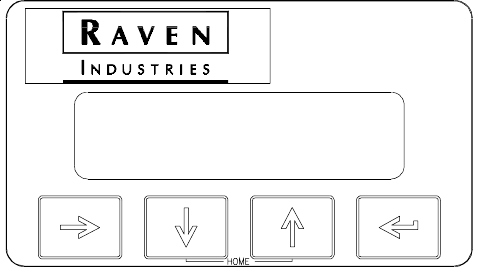
68
APPENDIX B - RAVEN INVICTA DGPS RECEIVER SETUP
Refer to the Invicta front panel shown below and use the following steps to setup you Invicta
DGPS Receiver to operate with the RGL 600 Smartbar. Refer to the operation manual
supplied with your Invicta DGPS Receiver to clarify or modify these steps.
From the HOME screen, press the LEFT ARROW (‘enter’) key once to arrive at
th OUTPUT CONFIG menu screen.
Press the DOWN ARROW key until you reach the Baud Rate Setting menu
screen for your chosen interface port (A or B). If the port’s baud rate is not
already displayed as “19200 bps”, press the LEFT ARROW (‘enter’) key to
hightlight the field.
Using the UP and DOWN ARROW keys, set the baud rate to 19200 bps and
then press the LEFT ARROW (‘enter’) key again to make your selection final.
To configure the NMEA message output for use with the RGL600 lightbar, press
the DOWN ARROW once to move from the Baud Rate menu screen to the
MSGOUTPUT menu screen for the chosen port (A or B).
Press the RIGHT ARROW key once to enter the message-type selection screen.
Press the UP or DOWN ARROW key until “GGA” is displayed at the message
type.
Press the LEFT ARROW (‘enter’) key to hightlight the output interval.
Use the UP and DOWN ARROWS to select the proper output rate (0.1 see if
your receiver has the 10 Hz option installed, else 1.0 sec) and press the LEFT
ARROW (‘enter’) key to finalize your selection.
Next, press the UP or DOWN ARROW key until “VTG” is displayed as the
message type.
Follow the same steps shown above to set the message output interval to the
VTG message.
Press the UP and DOWN ARROWS simultaneously to return to the HOME
menu screen and you’re ready to swath!
69
APPENDIX C - GLOBAL POSITIONING SYSTEM (GPS)
GPS is a satellite-based global navigation system created and operated by the United States
Department of Defense (DOD). Originally intended solely to enhance military defense
capabilities, GPS capabilities have expanded to provide highly accurate position and timing
information for many civilian applications.
An in-depth GPS study is required to fully understand it, but not to see how it work or appreci-
ate what it can do for you. Simply stated, twenty-four satellites in six orbital paths circle the
earth twice each day at an inclination angle of approximately 55o to the equator. This
constellation of satellites continuously transmits coded positional and timing information at
high frequencies in the 1500-Megahertz range. GPS receivers with antennas located in a
position to clearly view the satellites, pick up these signals and use the coded information to
calculate a position in an earth coordinate system.
GPS is the navigation system of choice for today and many years to come. While GPS is
clearly the most accurate world wide all-weather navigation system yet developed, it still can
exhibit significant errors. GPS receivers determine position by calculating the time it takes for
the radio signals, transmitted from each satellite, to reach earth. It’s that old “Distance = Rate
x Time” equation. Radio waves travel at the speed of light (Rate). Time is determined, and the
fact that the satellite’s position is reported in each coded navigation message, by using a little
trigonometry the receiver can determine its location on earth.
Position accuracy depends on the receiver’s ability to accurately calculate the time it takes for
each satellite signal to travel to earth. This is where the problem lies. There are primarily
seven sources of errors that can affect the receiver’s calculation. These errors consist of:
1. Ionosphere and troposhere delays on the radio signal.
2. Signal multi-path.
3. Receiver clock biases.
4. Orbital satellite (ephemeris) position errors.
5. GPS Satellite errors.
6. Tracking biases (position shifts when satellites are lost and re-aquired).
7. GPS Receiver performance and cost.
The combination of these errors and poor satellite geometry can limit GPS accuracy of a high
performance GPS Receiver to approximately 5 meters RMS and a low cost GPS Receiver to
10-15 meters RMS. Many of these errors can be reduced or eliminated through a technique
known as “Differential”.
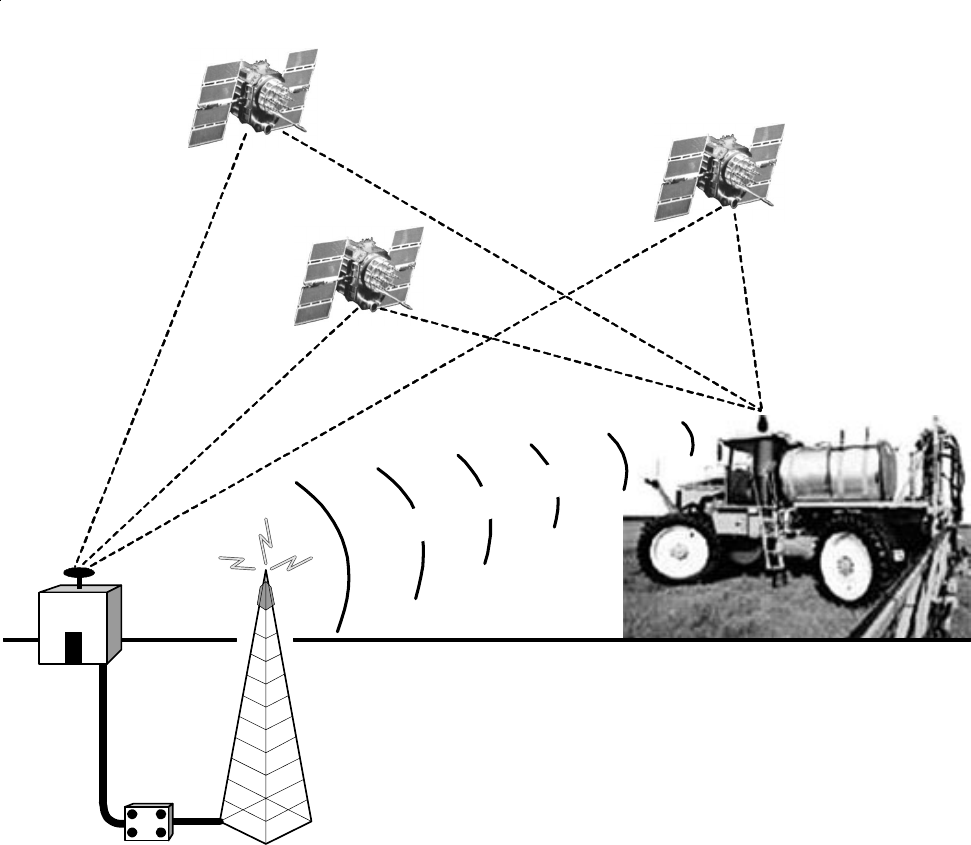
70
APPENDIX D - DIFFERENTIAL GPS (DGPS) BEACON
DGPS works by placing a high-performance GPS receiver (reference station) at a known
location. Since the receiver knows its exact location, it can determine the errors in the
satellite signals. It does this by measuring the ranges to each satellite using the signals
received and comparing these measured ranges to the actual ranges calculated from its
known position. The difference between the measured and calculated range is the total
error. The error data for each tracked satellite is formatted into a correction message and
transmitted to GPS users. The correction message format follows the standard established
by the Radio Technical Commission for Maritime Services, Special Committee 104 (RTCM-
SC104). These differential corrections are then applied to the GPS calculations, thus re-
moving most of the satellite signal error and improving accuracy. The level of accuracy
obtained is a function of the GPS receiver. Sophisticated receivers like the Invicta 210 series
can achieve accuracy on the order of 1 meter or less.
GPS Satellites
Reference
Station
Coupler
DGPS
Radiobeacon
Antenna
RTCM-SC104 Corrections
Differential GPS Broadcast Site